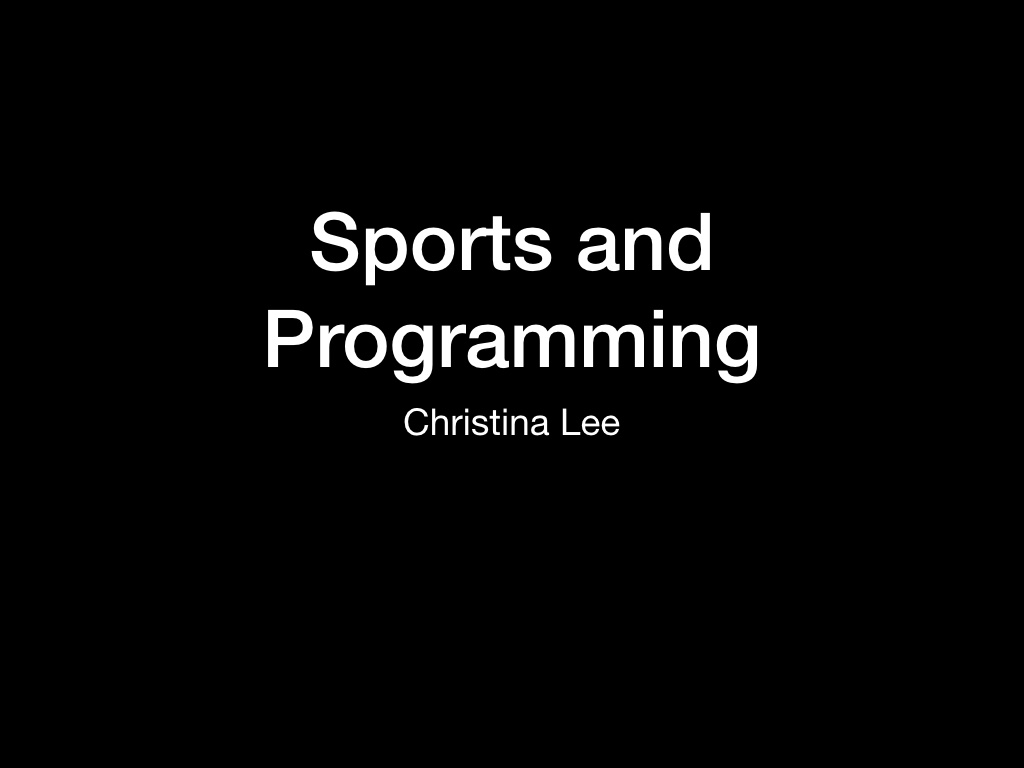
Disclaimer: I am not a scientist. This is a synopsis of the latest books, interviews, and research papers I’ve been reading in the realm of psychology and physiology. Any inaccuracies in this deck are mine and mine alone, and as with anything, I’d encourage you to do your own research instead of relying on the musings of an internet stranger.

“Silicon Valley engineers are pretty similar to professional athletes” -my brother
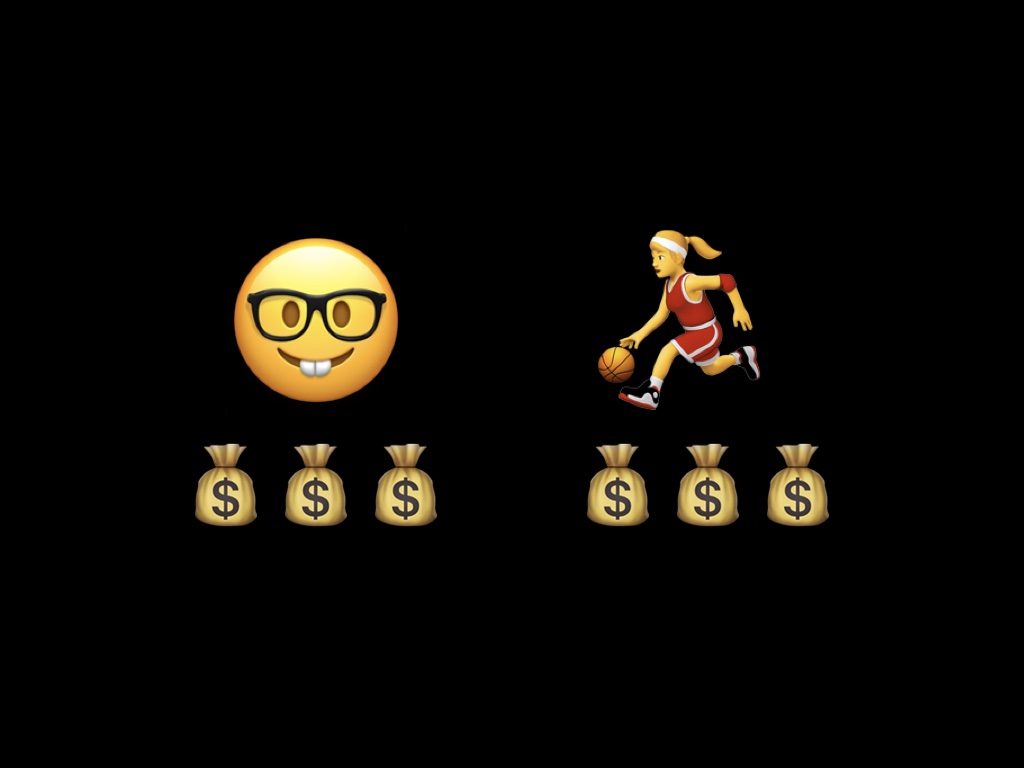
Which is to say that both are getting paid A LOT and companies/teams have vested interests in us outputting as much as possible

I had never really made this connection, and it got my mind racing. The more you think about it, the more you start to see it.
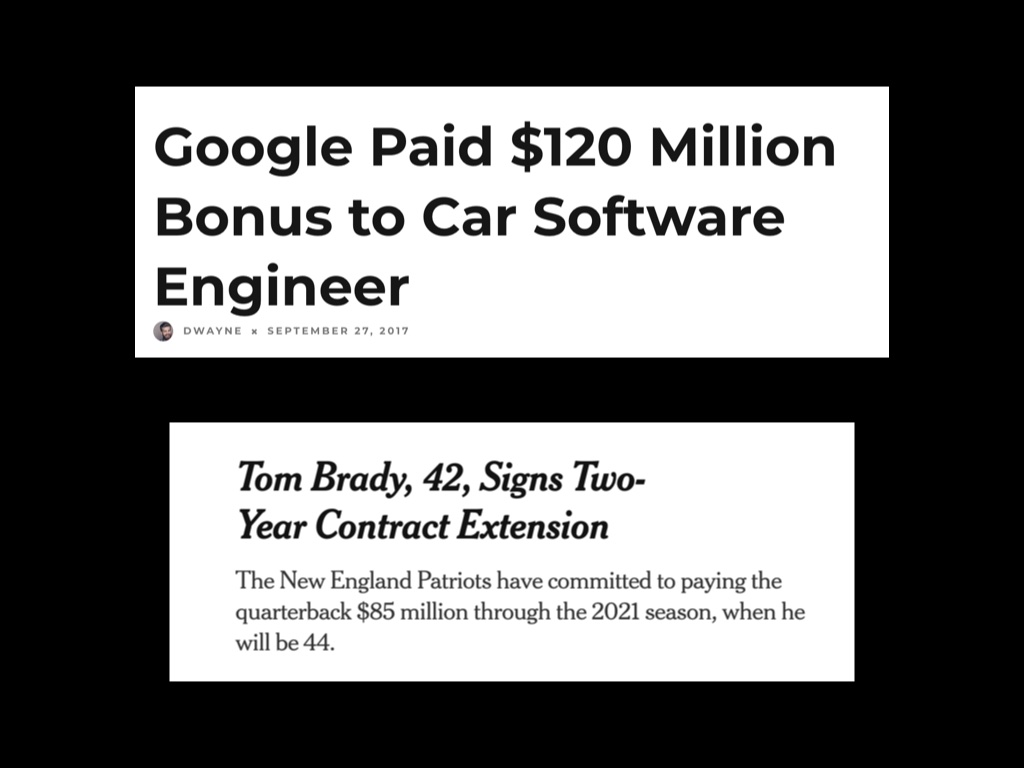
Sure, both groups get paid extremely…

Ridiculous…

Sums of money when they’re at the top of their game. But once you look past money, you see a lot of other parallels that can be drawn too.

For instance, there’s a lot of public interest in the “teams” that star engineers are affiliated with. When they decide to leave a company, or join a new one, it generates a lot of chatter in a way similar to how people discuss free agency for athletes.
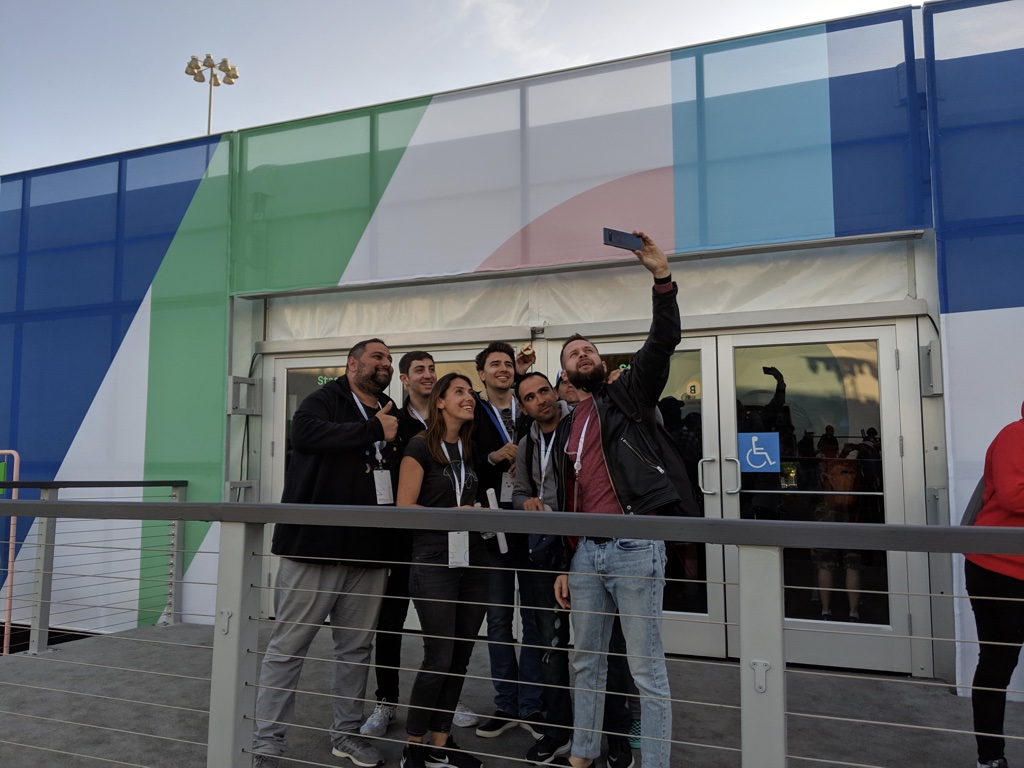
If you walk around with a sufficiently famous software engineer, they will be stopped for photos or autographs. I can tell you this, because as the less famous sidekick I’m usually the one who gets asked to take the photo.

We shit talk people on other teams
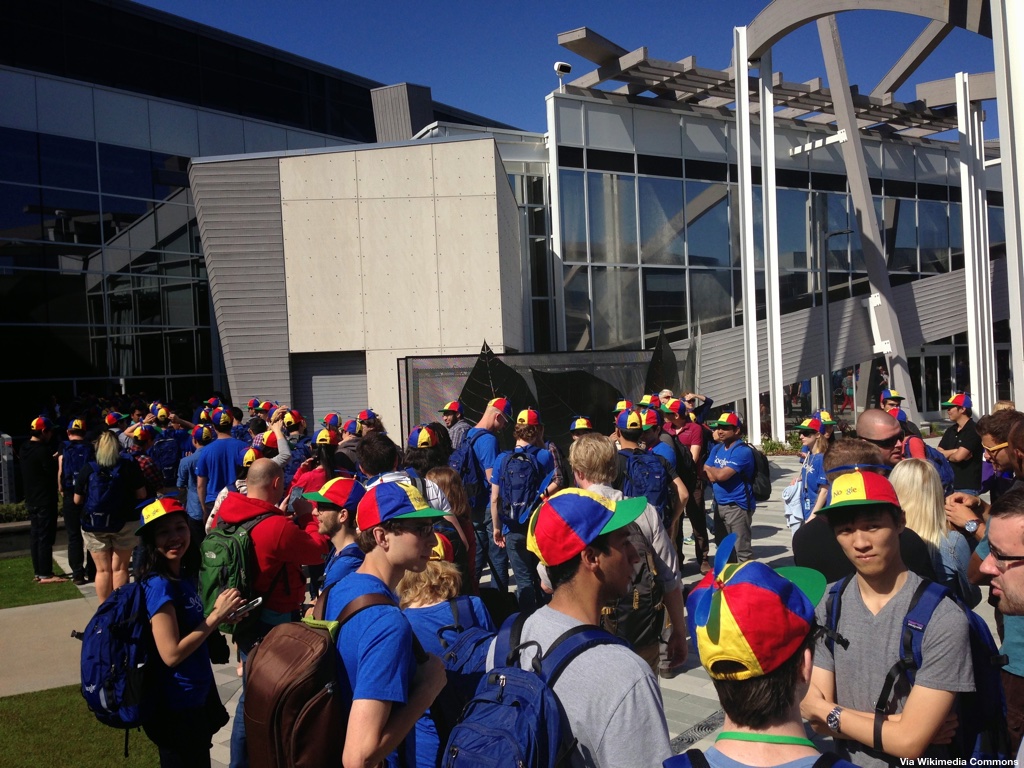
And don’t get me started on uniforms. Because techies definitely have team uniforms. I know at least one of you in this audience is in your uniform today.

And cheering crowds? Well sure, maybe we don’t get entire stadiums, but its still enough to make your mom proud
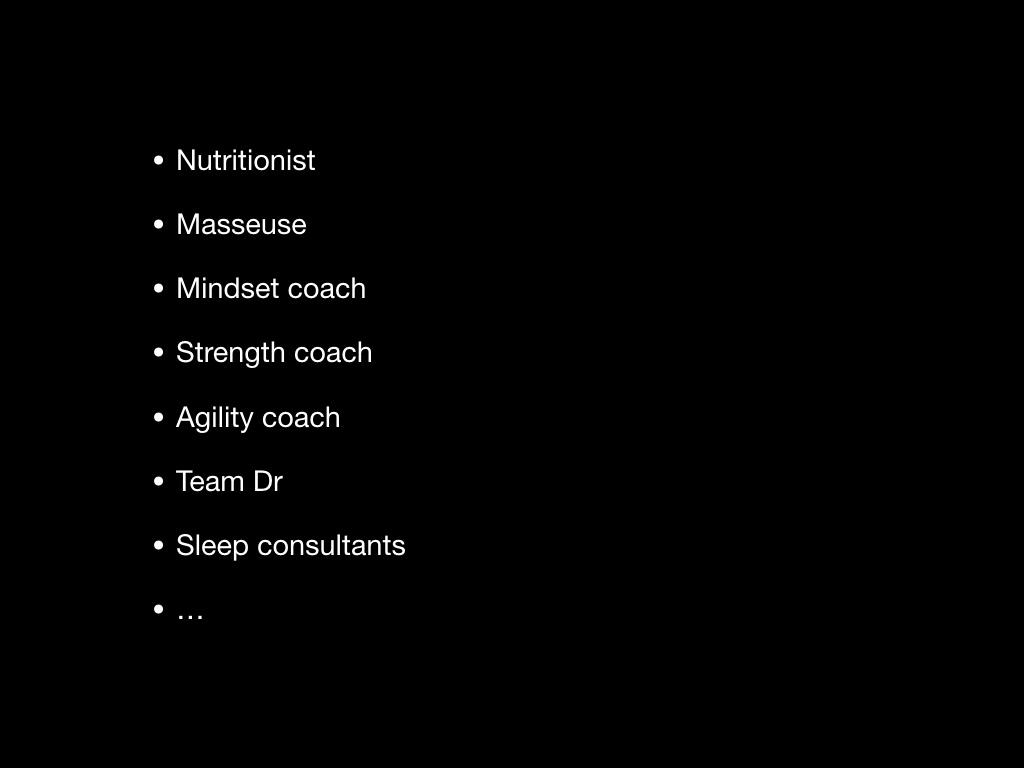
But there’s a very noticeable place where the two industries vary dramatically. In professional sports, athletes tend to have teams surrounding them to eek every last ounce of performance out of them.
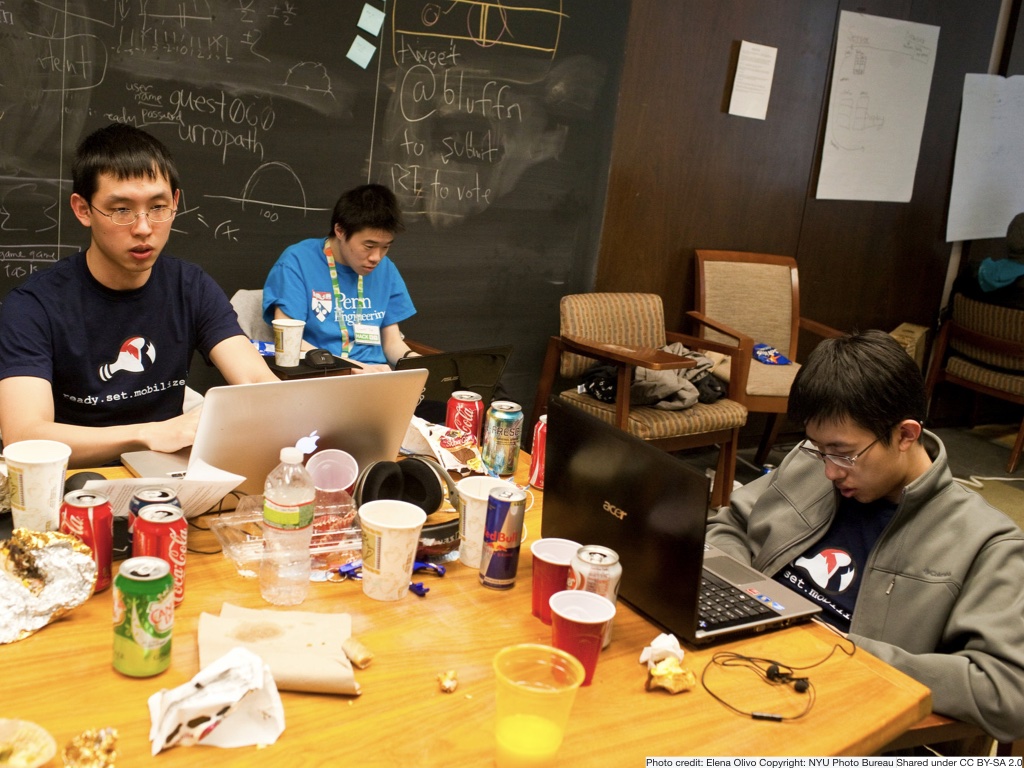
Meanwhile over in programming land, we still have a notion that crushing redbulls, eating snacks from unlimited candy bars, and staying up all night are good ideas

And to be fair, companies are trying to fight this. At Pinterest, we have a nutritionist on staff to keep us from destroying ourselves.

I know this, because she had to get on stage at company Q&A once to explain why the company was not going to supply us with unlimited Nutella (apparently it lacks “sufficient nutritional content”)

Google is probably closest to a professional sports team, with its on site masseuses and yoga and laundry, but I can attest from first hand experience, there is still a lot of junk food and late nights to be found
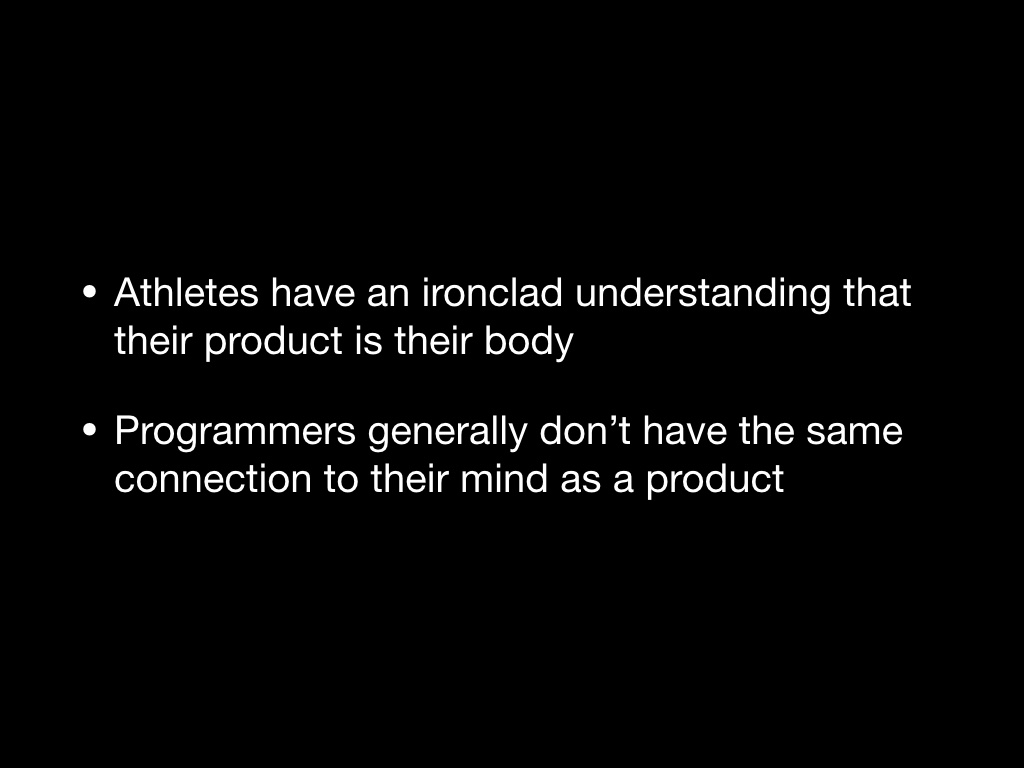
Despite their best efforts, companies seem to be losing the battle. And I think this is true due to a key difference in how most athletes and most programmers see themselves.
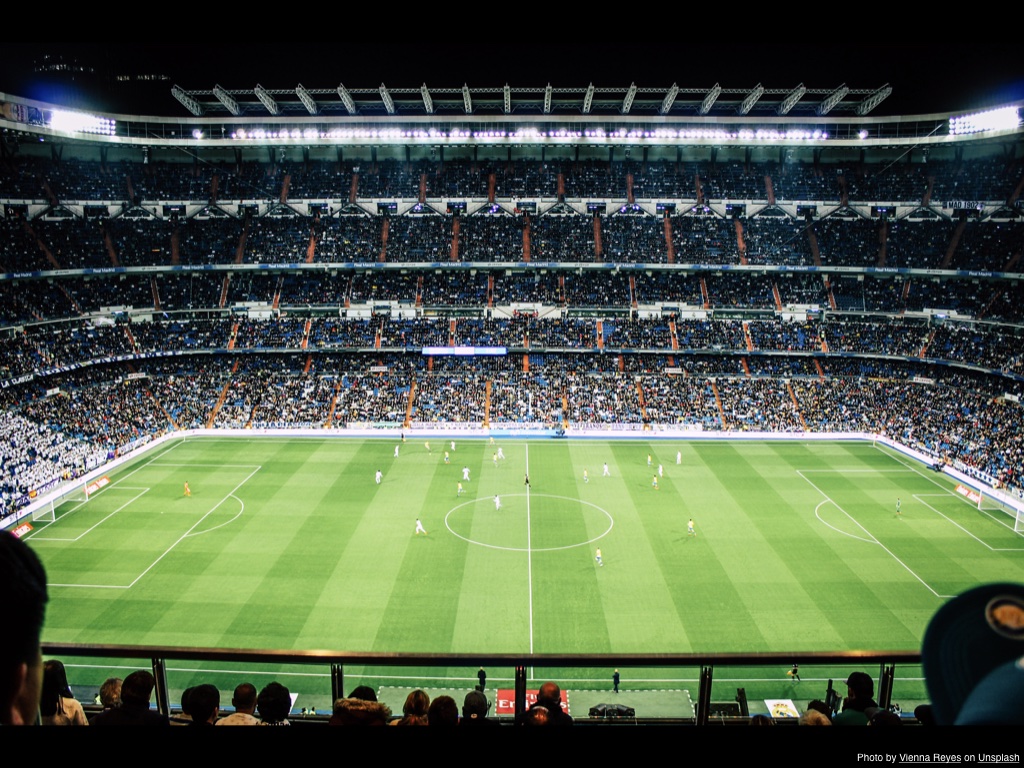
Many engineers don’t think twice about staying up late bingeing Netflix before work the next day, but I’d hazard a guess none of the women competing in the world cup felt the same way. Athletes seems to have a much clearer conceptualization of environmental factors affecting their work output than the average software engineer.
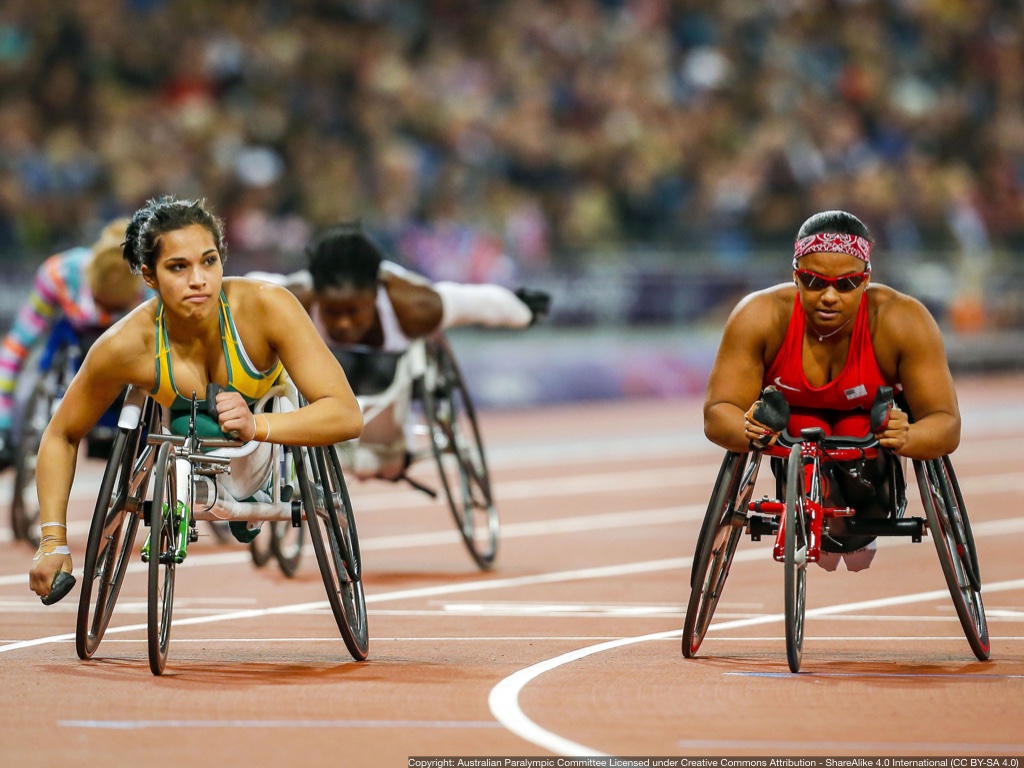
And you might be thinking: but Christina, athletes are using their muscles mostly. We understand muscles need rest and recovery. It’s different.
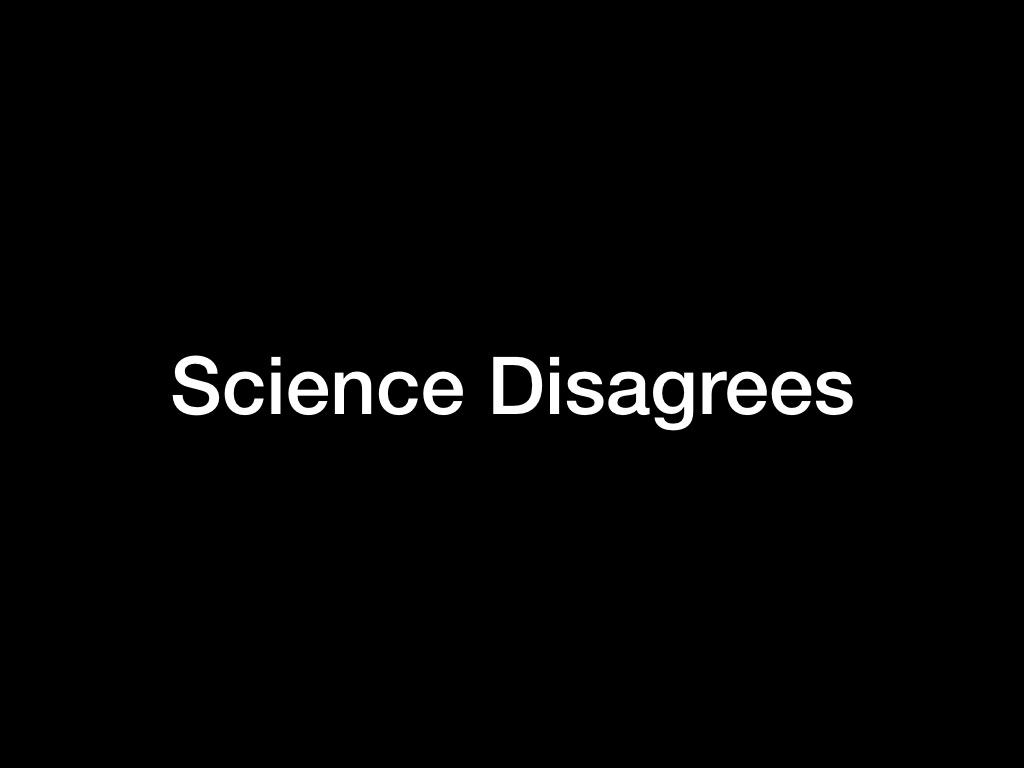
And to that, I’ll say

We have ample evidence that the brain is a muscle that grows and responds to exercise.
__________________________
Citation: Ericsson, Anders. Peak: Secrets from the New Science of Expertise (p. 32). HMH Books. Kindle Edition.

In one study by Eleanor Maguire about people studying for the taxi exam in London, she found that “the volume of the posterior hippocampi had gotten significantly larger in the group of trainees who had continued their training and had become licensed taxi drivers.” The taxi drivers had literally bulked up the part of their brain responsible for navigation, in turn increasing their capacity to navigate.
__________________________
Citation: Ericsson, Anders. Peak: Secrets from the New Science of Expertise (p. 32). HMH Books. Kindle Edition.

This ability to bulk up brain matter translates to making tasks easier in much the same way bulking up muscles at the gym makes athletic performances easier.
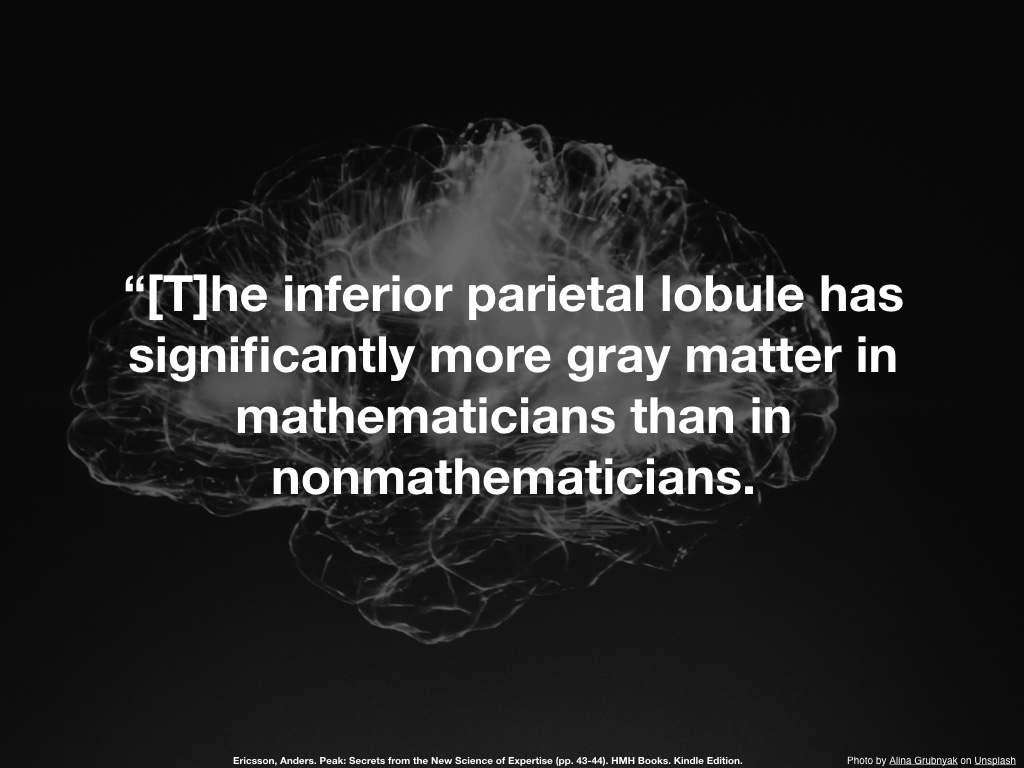
You know how people say “oh they’ve got a mind for numbers?” Well it’s physically true. Mathematicians do have more grey matter in their brains that makes them better at math than you.
__________________________
Citation: Ericsson, Anders. Peak: Secrets from the New Science of Expertise (pp. 43-44). HMH Books. Kindle Edition.
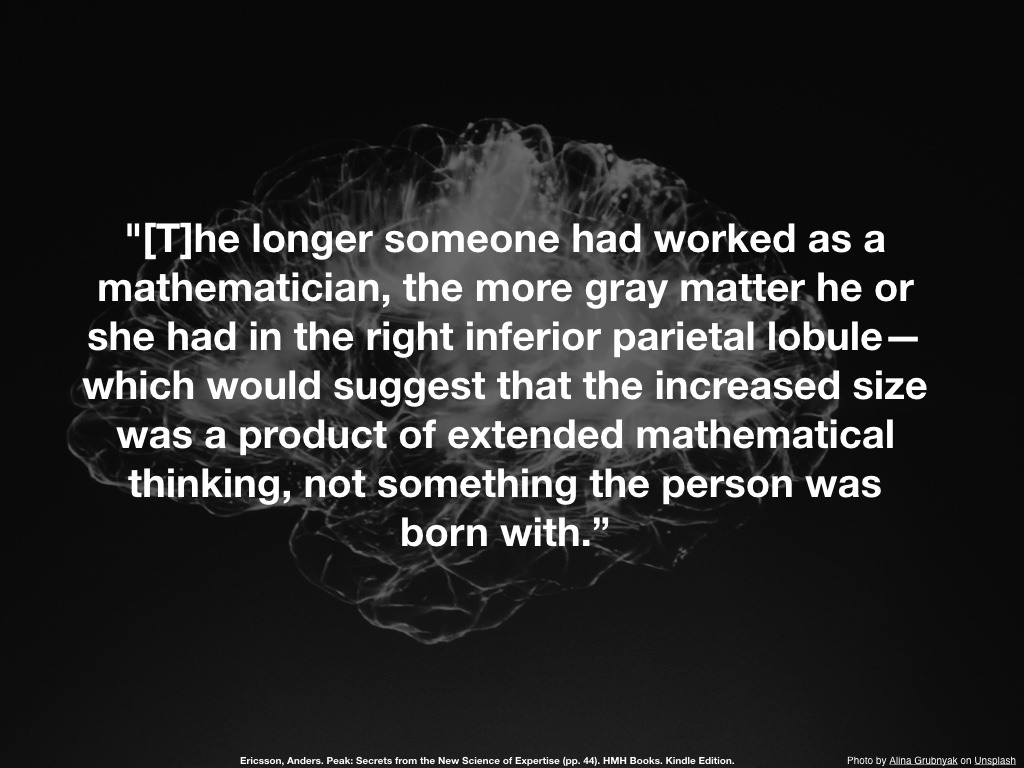
But crucially, it’s not that they were BORN with more grey matter. They trained it into themselves.
__________________________
Citation: Ericsson, Anders. Peak: Secrets from the New Science of Expertise (pp. 44). HMH Books. Kindle Edition.
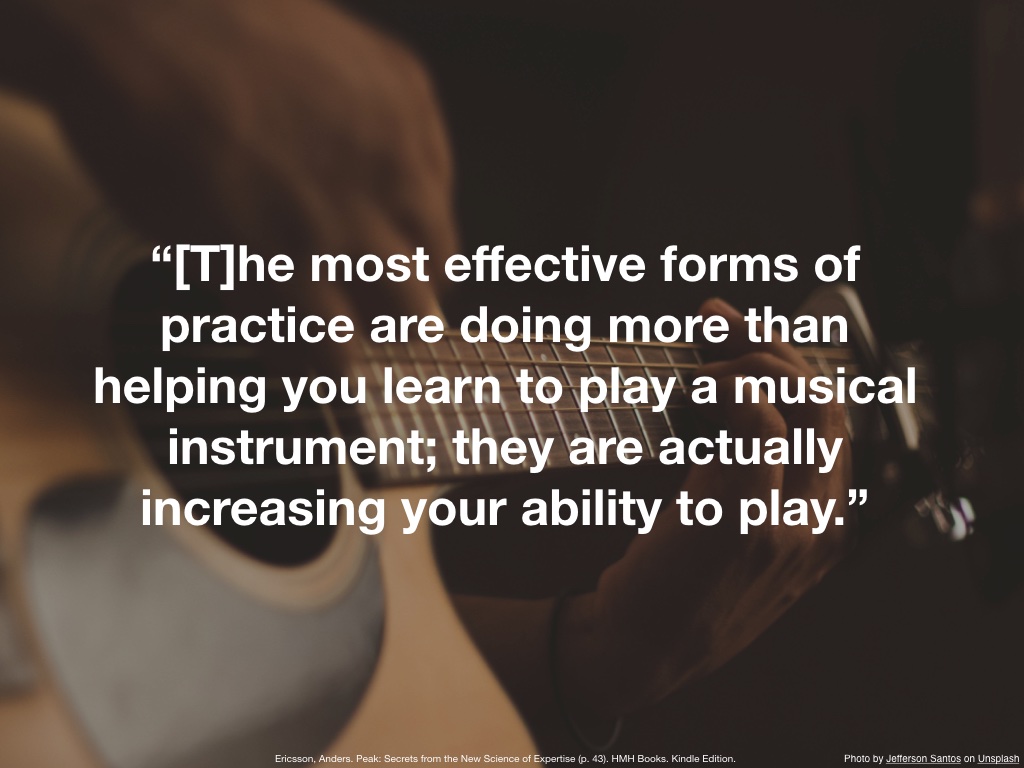
Musicians brains rewire themselves through practice to make them better at music than someone who hasn’t played — They not only *know* how to play music, they are *physically* more capable of playing it than you.
__________________________
Citation: Ericsson, Anders. Peak: Secrets from the New Science of Expertise (p. 43). HMH Books. Kindle Edition.
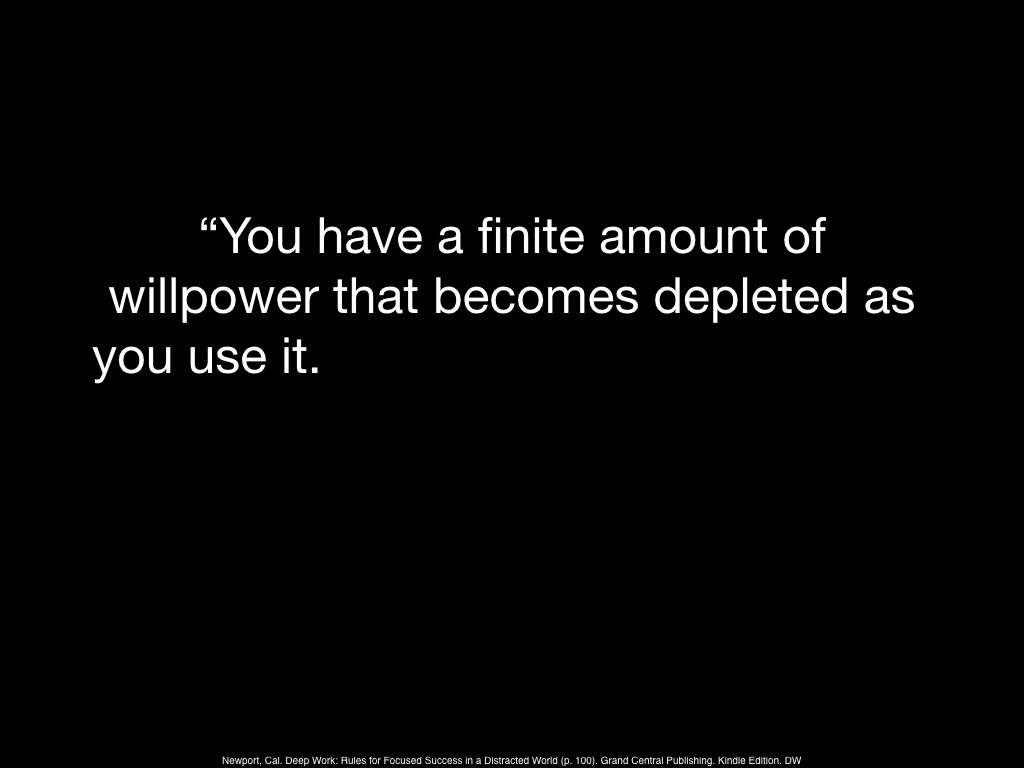
And further, just like a muscle getting tired late in a game, we know that certain parts of the brain can get fatigued.
__________________________
Quote Citation: Newport, Cal. Deep Work: Rules for Focused Success in a Distracted World (p. 100). Grand Central Publishing. Kindle Edition. DW

Importantly, will power is not a character trait
__________________________
Quote Citation: Newport, Cal. Deep Work: Rules for Focused Success in a Distracted World (p. 100). Grand Central Publishing. Kindle Edition. DW
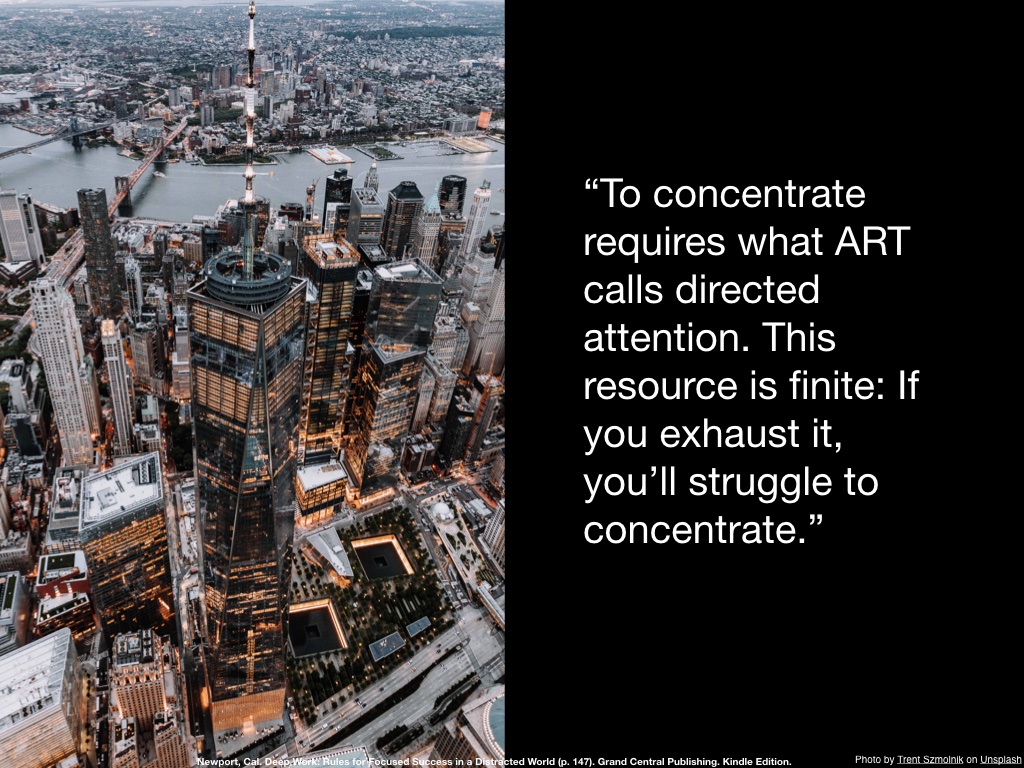
We can see these effects in studies exploring ART, or the attention restoration theory.
__________________________
Newport, Cal. Deep Work: Rules for Focused Success in a Distracted World (p. 147). Grand Central Publishing. Kindle Edition.
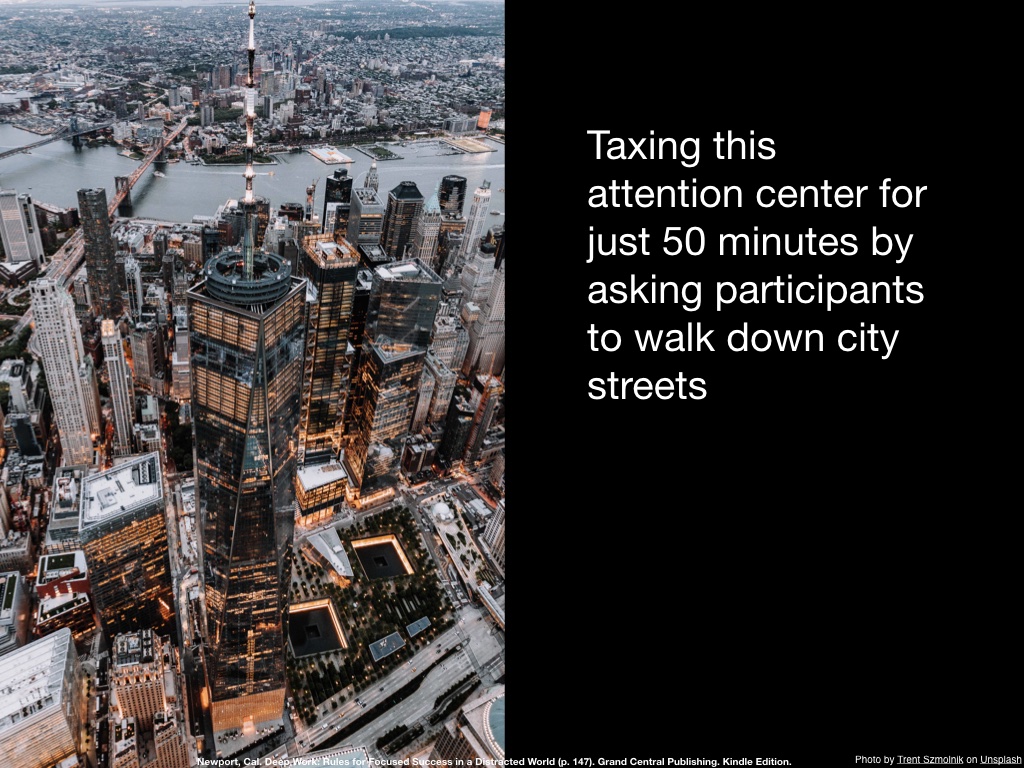
When students walked through a city, requiring directed attention…
__________________________
Quote Citation: Newport, Cal. Deep Work: Rules for Focused Success in a Distracted World (p. 147). Grand Central Publishing. Kindle Edition.
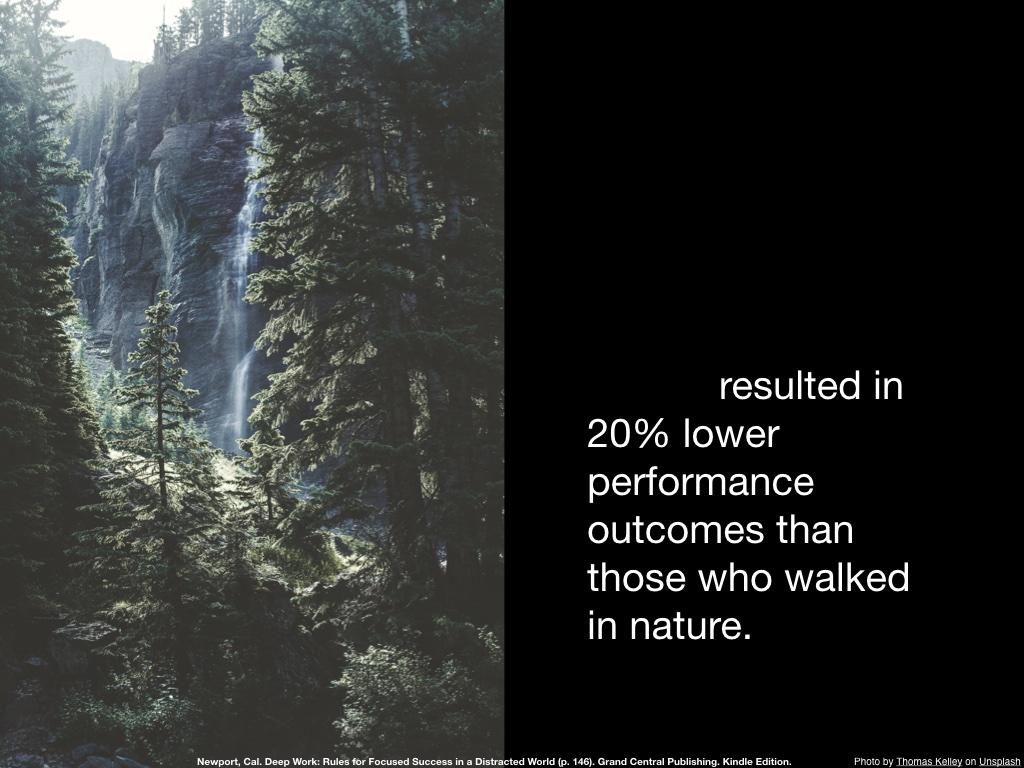
They were outperformed by a factor of 20% on a subsequent attention task by those who’s attention centers were well rested (by walking through nature).
__________________________
Quote Citation: Newport, Cal. Deep Work: Rules for Focused Success in a Distracted World (p. 146). Grand Central Publishing. Kindle Edition.

The science is pretty clear: knowledge workers are in the business of selling muscle-like capacity in a way very similar to athletes.
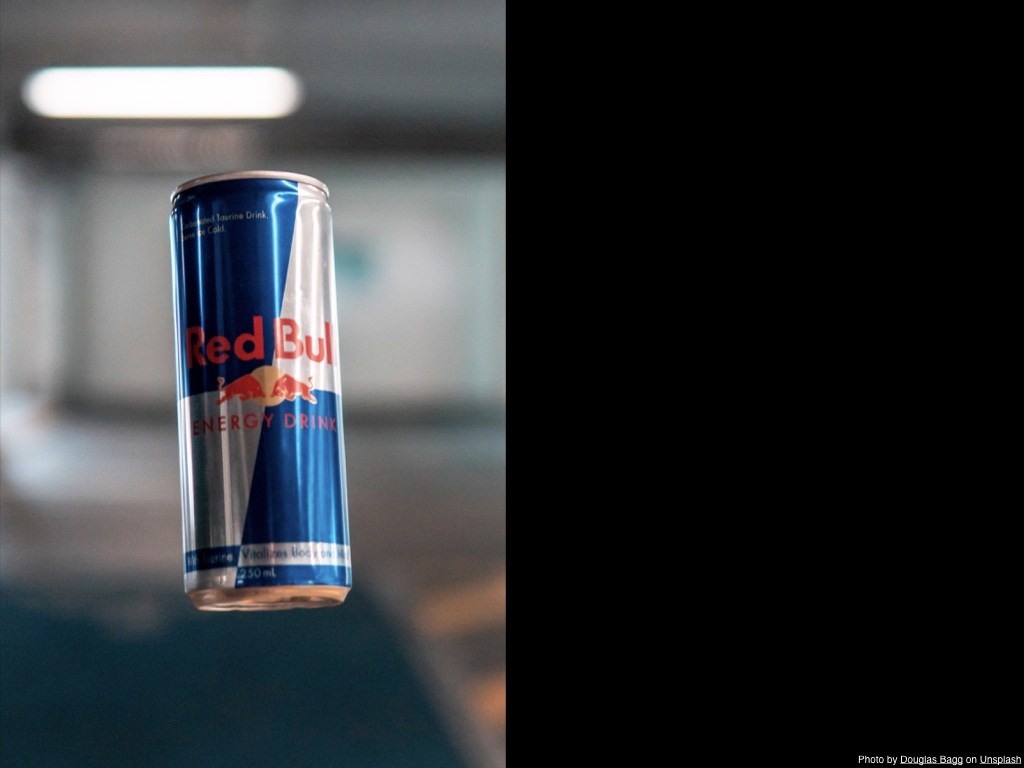
Which makes our pop culture obsessions with red bull and all nighters particularly ill advised.

Ok, so let’s say you accept that the software industry is a little misguided in what we hold up as environmental norms. Luckily, if we want to change, we don’t need to reinvent the wheel. Athletes are already highly optimized in this regard. So what can we learn from them?

Well, let’s start where most athletes start: at the beginning. With no skills, and no fame, just wee little chaps practicing their craft out on a playground. What can we learn about practice from those who go on to greatness?
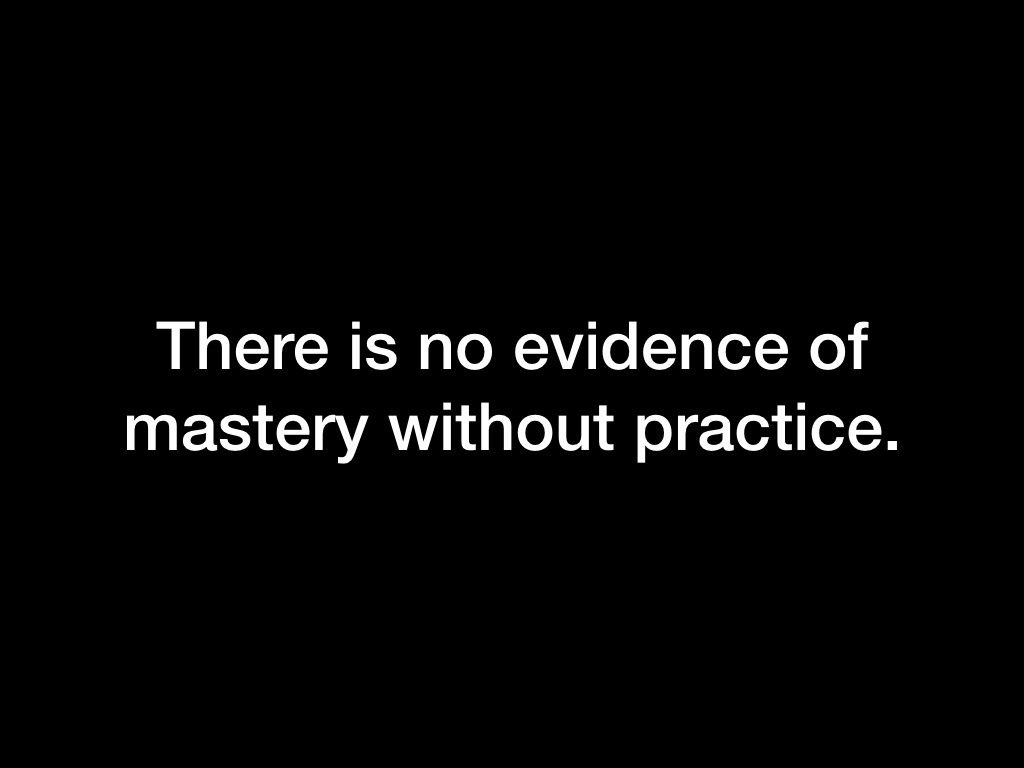
First, that there really isn’t any evidence of mastery without practice.
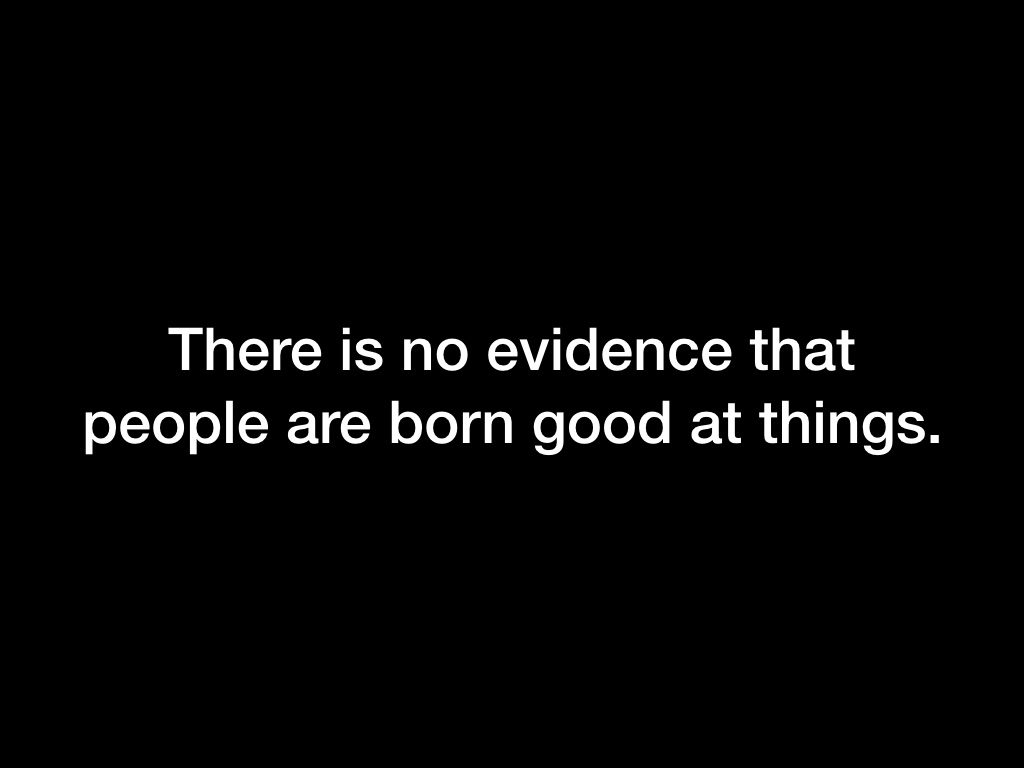
Which is another way to say there is no current evidence that people are born savants. They may be born with advantages that they leverage in addition to practice, but practice is always an important step to catapult potential into actuality.
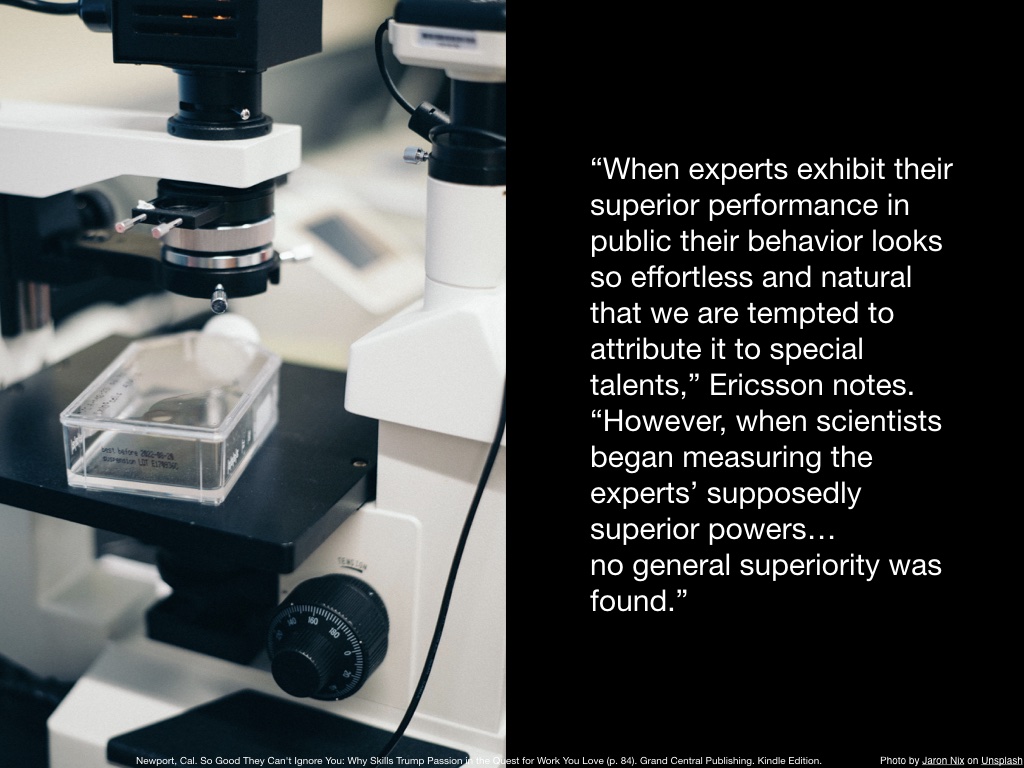
Many of us struggle to believe this, because we usually see people perform only after they are great. They make things look easy enough that we assume it was always natural to them, but when scientists try to look for this supposed superiority, it doesn’t appear to exist
__________________________
Citation: Newport, Cal. So Good They Can't Ignore You: Why Skills Trump Passion in the Quest for Work You Love (p. 84). Grand Central Publishing. Kindle Edition.
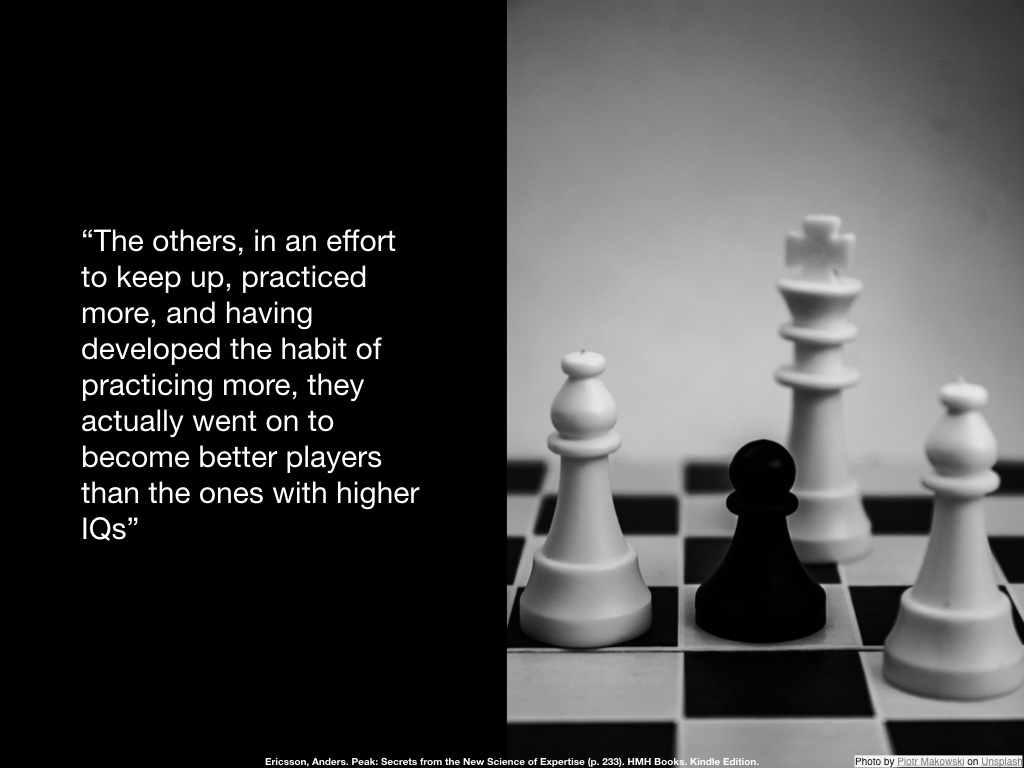
Indeed we have some evidence from studying chess players that early genetic advantages can hold people back if it causes them to “coast” instead of investing in practicing like their peers who struggle more initially.
__________________________
Citation: Ericsson, Anders. Peak: Secrets from the New Science of Expertise (p. 233). HMH Books. Kindle Edition.
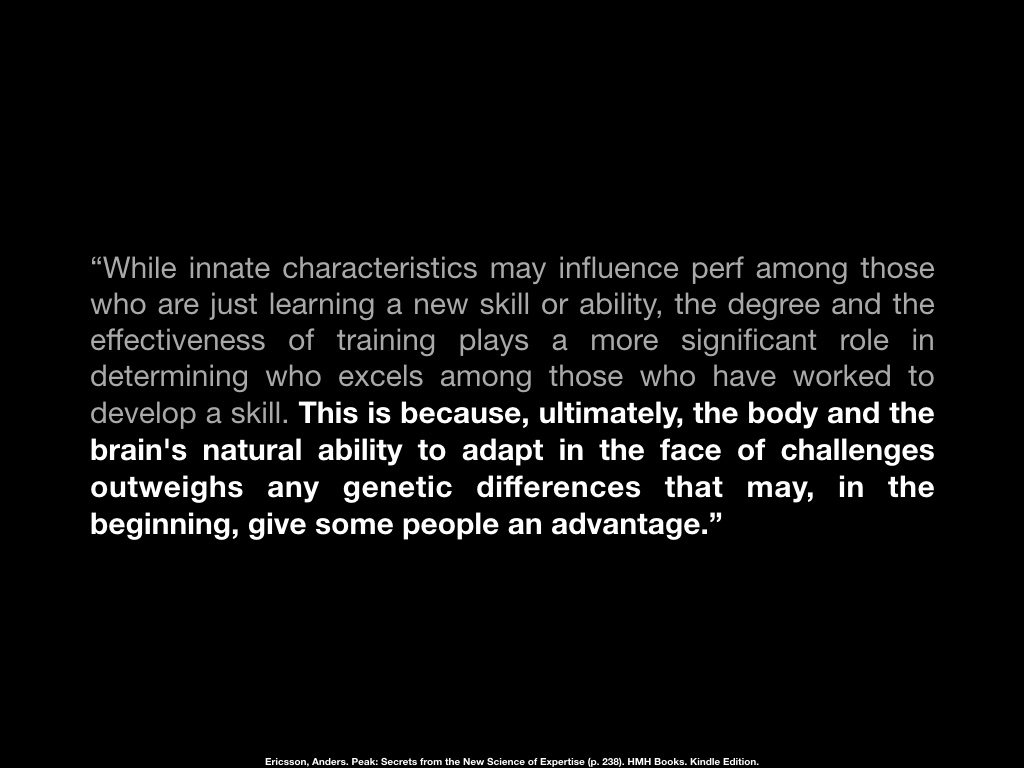
Genetics versus practice is the story of the tortoise and the hare
__________________________
Citation: Ericsson, Anders. Peak: Secrets from the New Science of Expertise (p. 238). HMH Books. Kindle Edition.

Specifically what practice gives us is mental models. Experts have practiced enough to build up sophisticated mental models that allow them to make more informed decisions, faster than someone who hasn’t trained. This is where their apparent ease comes from. As we’ll discuss later, it is a bit easier for them to process information in their area of expertise.
__________________________
Citation: Ericsson, Anders. Peak: Secrets from the New Science of Expertise (p. 62-63). HMH Books. Kindle Edition.
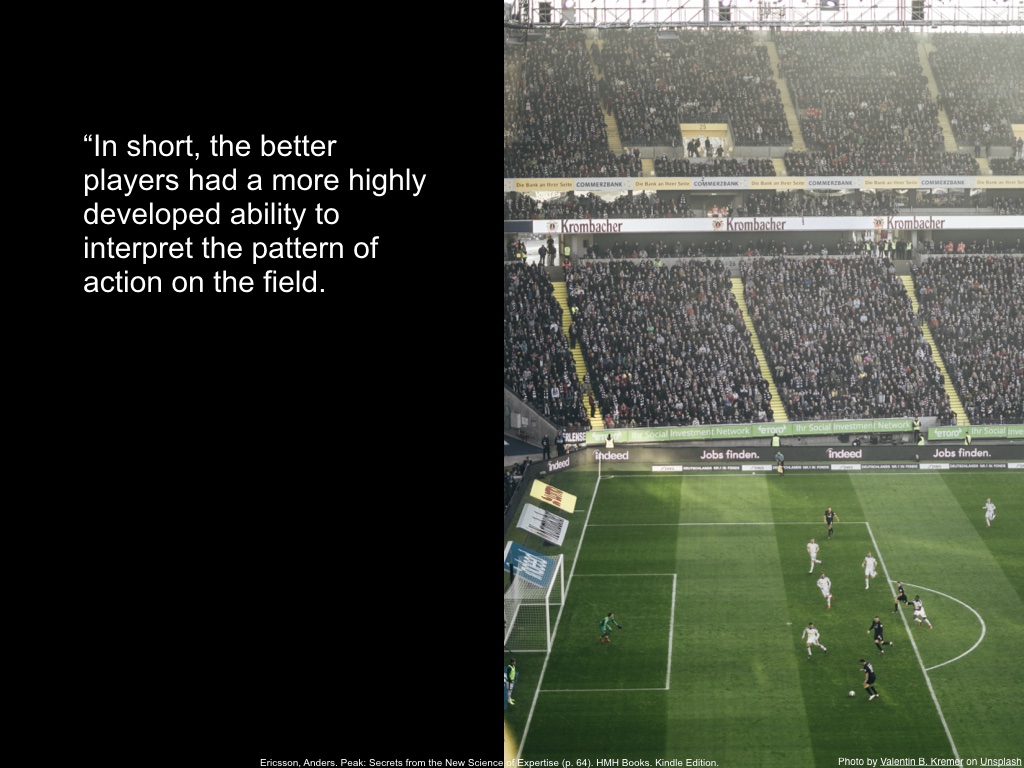
One way this was studied was via soccer players. A scenario was set up where the researchers would play a clip of a game, and then pause it as the ball got to a player’s foot. They would then quiz the participants on what they thought would happen next and where certain players were located on the field or doing at the moment the game was stopped. They found:
“In short, the better players had a more highly developed ability to interpret the pattern of action on the field…”
__________________________
Citation: Ericsson, Anders. Peak: Secrets from the New Science of Expertise (p. 64). HMH Books. Kindle Edition.
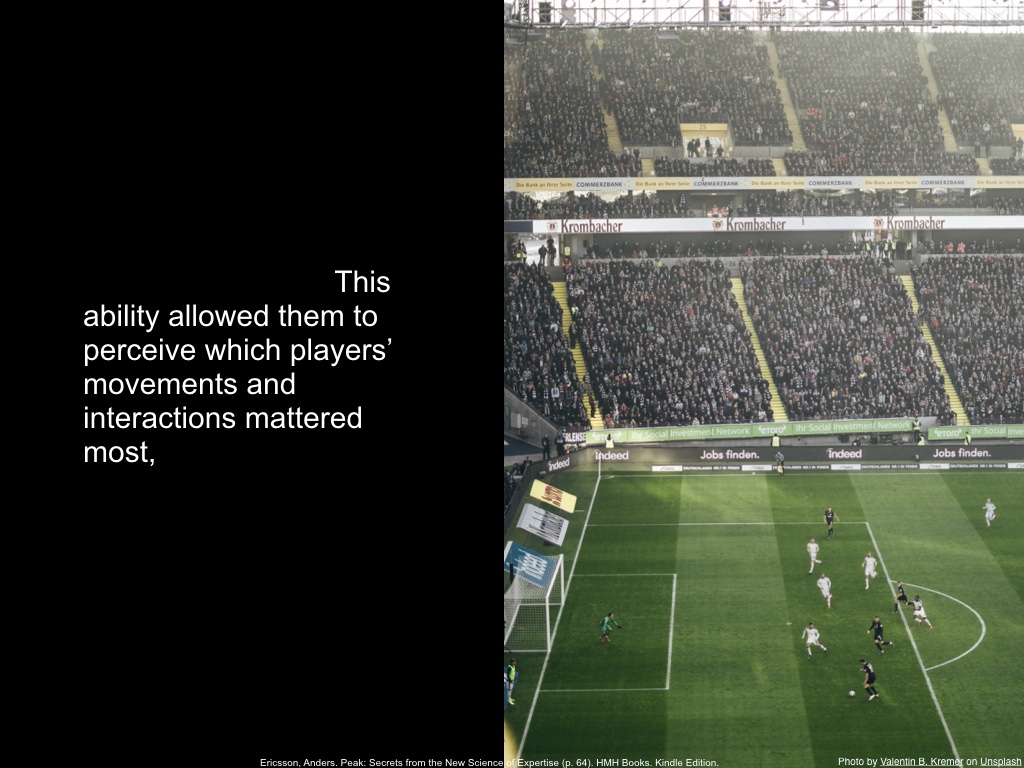
“… This ability allowed them to perceive which players’ movements and interactions mattered most,…”
__________________________
Citation: Ericsson, Anders. Peak: Secrets from the New Science of Expertise (p. 64). HMH Books. Kindle Edition.
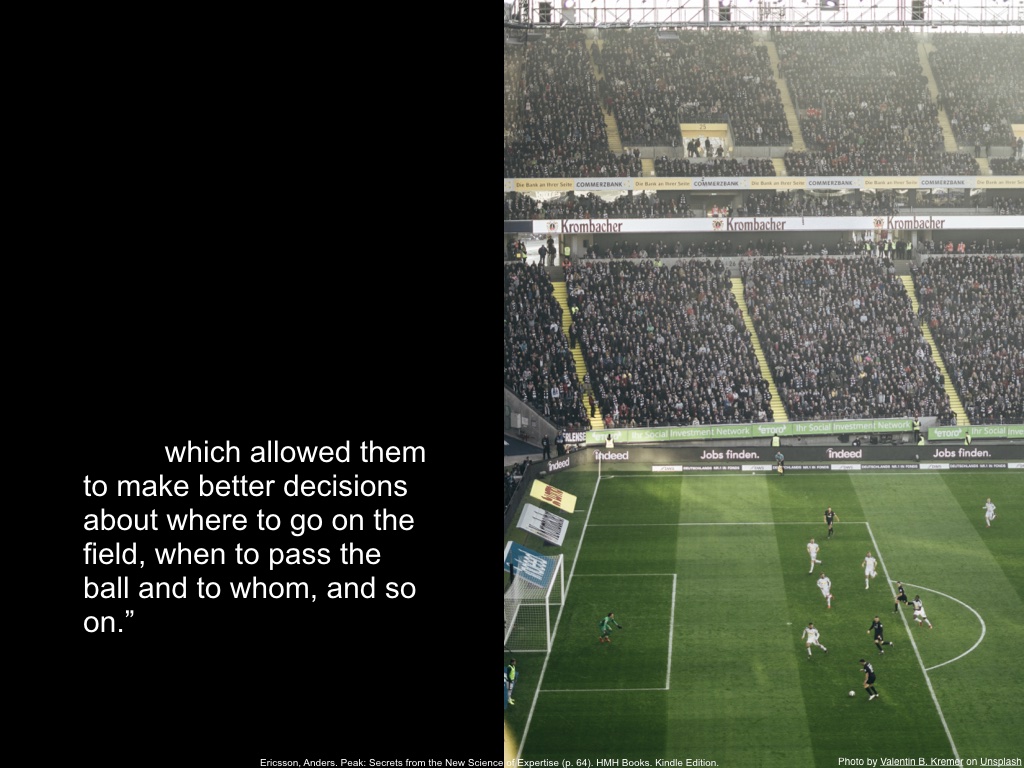
“… which allowed them to make better decisions about where to go on the field, when to pass the ball and to whom, and so on.”
__________________________
Citation: Ericsson, Anders. Peak: Secrets from the New Science of Expertise (p. 64). HMH Books. Kindle Edition.

The reason having mental models is important to expertise is because it allows for easier encoding and retrieval. Without a mental model, a student needs to encode information piece by piece. When it comes time to retrieve it, they must also do so piece by piece, placing them at the whim of their short term memory’s capacities.
__________________________
Citation: Ericsson, Anders. Peak: Secrets from the New Science of Expertise (pp. 250-251). HMH Books. Kindle Edition.
“If you teach a student facts, concepts, and rules, those things go into long-term memory as individual pieces, and if a student then wishes to do something with them—use them to solve a problem, reason with them to answer a question, or organize and analyze them to come up with a theme or a hypothesis—the limitations of attention and short-term memory kick in. The student must keep all of these different, unconnected pieces in mind while working with them toward a solution. However, if this information is assimilated as part of building mental representations aimed at doing something, the individual pieces become part of an interconnected pattern that provides context and meaning to the information, making it easier to work with.”
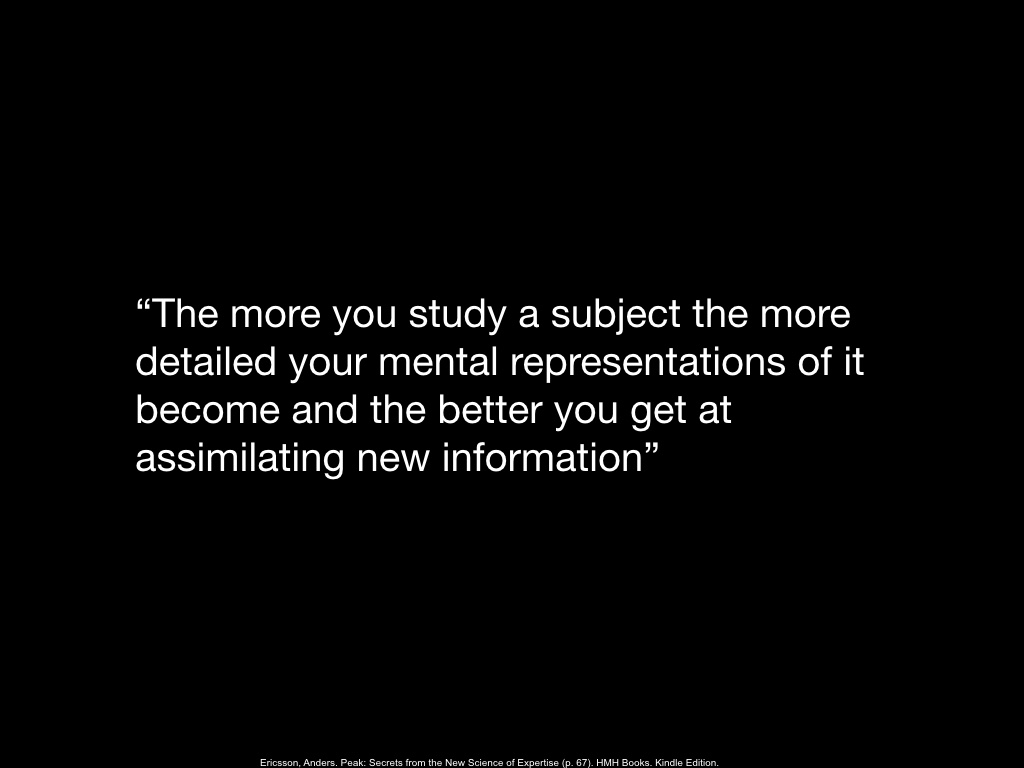
The best part is that having a mental model makes it easier to learn new information which in turn strengthens the mental model, creating a virtuous cycle in which the more expertise you build up, the easier it is to gather expertise, the more you build up, and on and on.
__________________________
Quote Citation: Ericsson, Anders. Peak: Secrets from the New Science of Expertise (p. 67). HMH Books. Kindle Edition.

Ok, so if mental models are what set experts apart from non experts across disciplines, how do we build mental models?
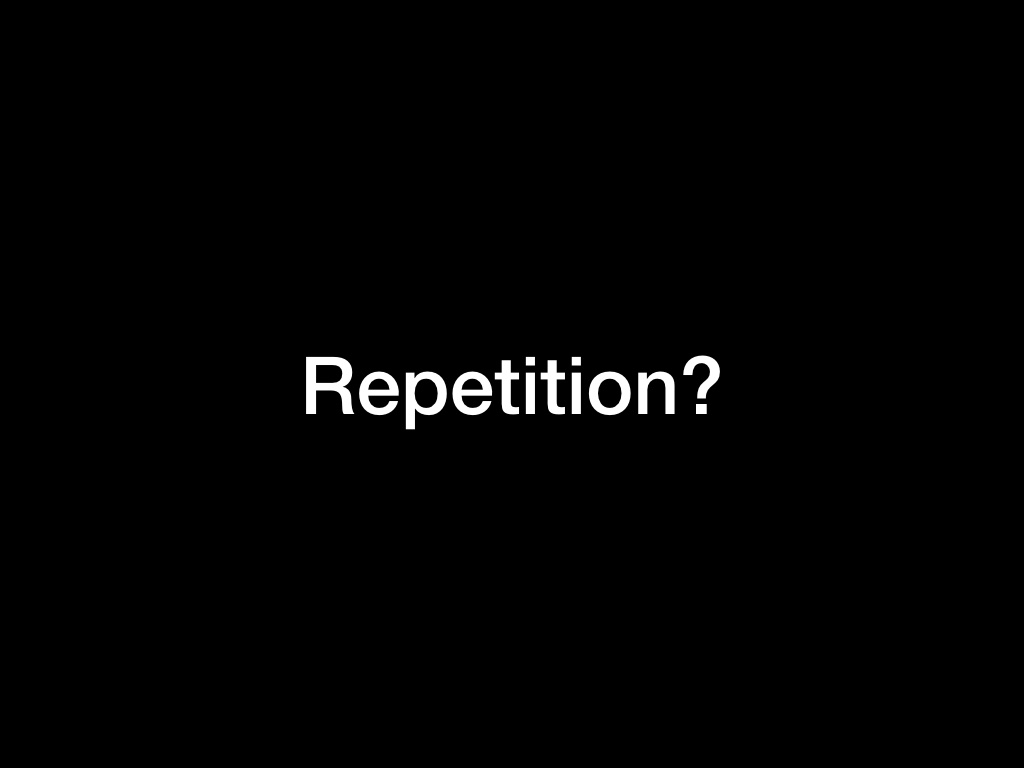
If we draw on our experiences from childhood, the first thing we might think is probably to practice it a lot. I.e. the flashcard method of learning new vocabulary words. Unfortunately though, you are not bound to get better just by putting in more hours.

Sometimes we talk about getting better solely as a factor of “trying harder”. This is the “if you only tried harder you’d succeed” way of thinking
__________________________
Quote Citation: Ericsson, Anders. Peak: Secrets from the New Science of Expertise (p. 122). HMH Books. Kindle Edition.

But based on what we know about the brain and how it learns complex tasks, this doesn’t appear to be a well supported ideology. Repetition might help you memorize discrete facts, but it won’t necessarily help you build a mental model.
__________________________
Quote Citation: Ericsson, Anders. Peak: Secrets from the New Science of Expertise (p. 122). HMH Books. Kindle Edition.
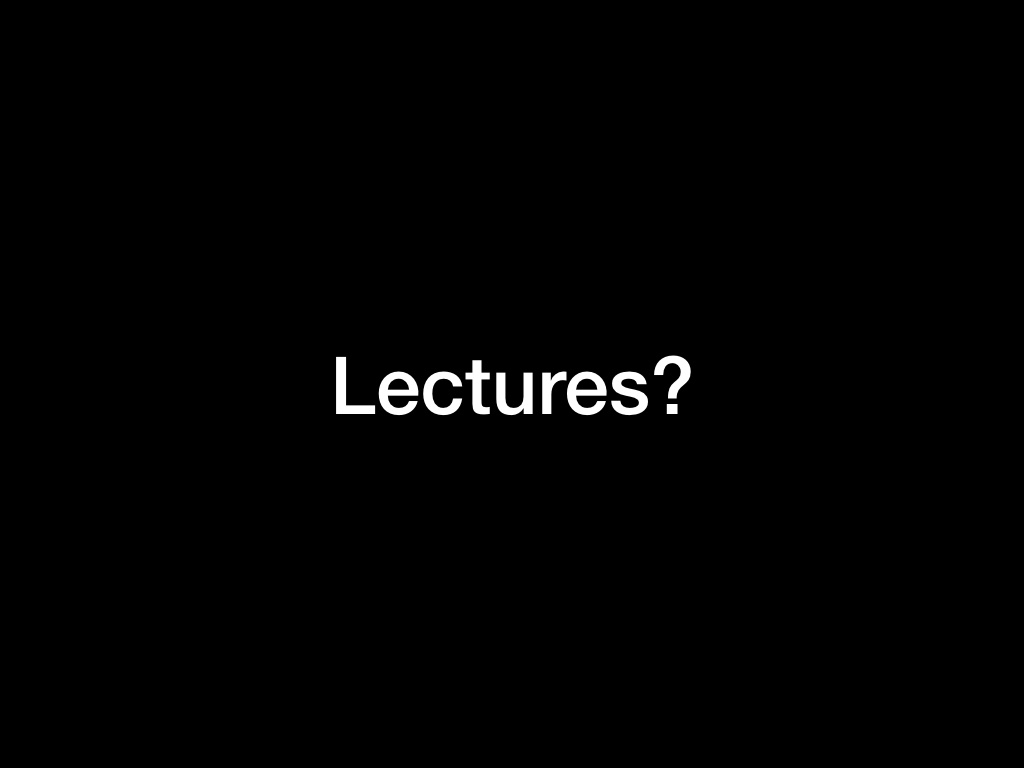
The second thing we might think of when reminiscing about past learning techniques is that much of our schooling has revolved around lectures, so maybe going out and attending lectures from experts would be a good way to build mental models.

Unfortunately though, in a study of medical professionals quantifying the effect of their various continuing education methodologies, scientists found that lectures were the least efficient way to learn and provided only a nominal boost.
__________________________
Citation: Ericsson, Anders. Peak: Secrets from the New Science of Expertise (pp. 134-135). HMH Books. Kindle Edition.

This is of course quite unfortunate, as most education systems are built around lectures as they’re one of the easiest educational activities to provide.
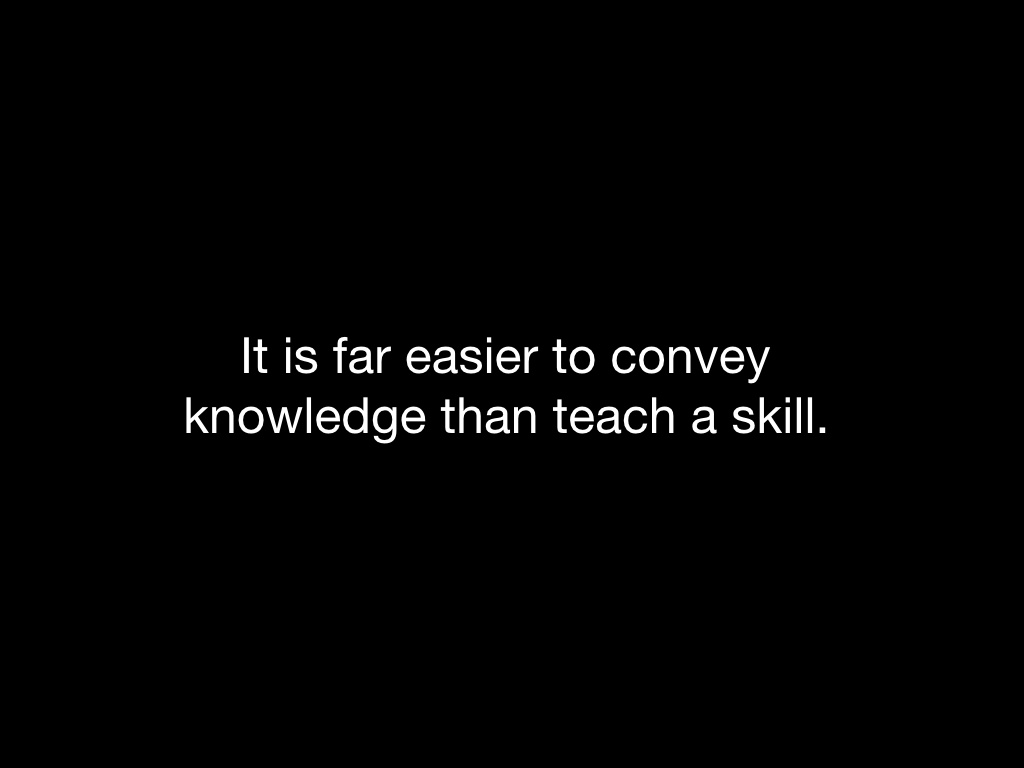
Specifically, they’re easier than some other possibilities because conveying discrete knowledge is much more straightforward than building a mental model or teaching a skill, which requires a lot of fine tuned feedback and constant adjustments and is less predictable and linear temporally.
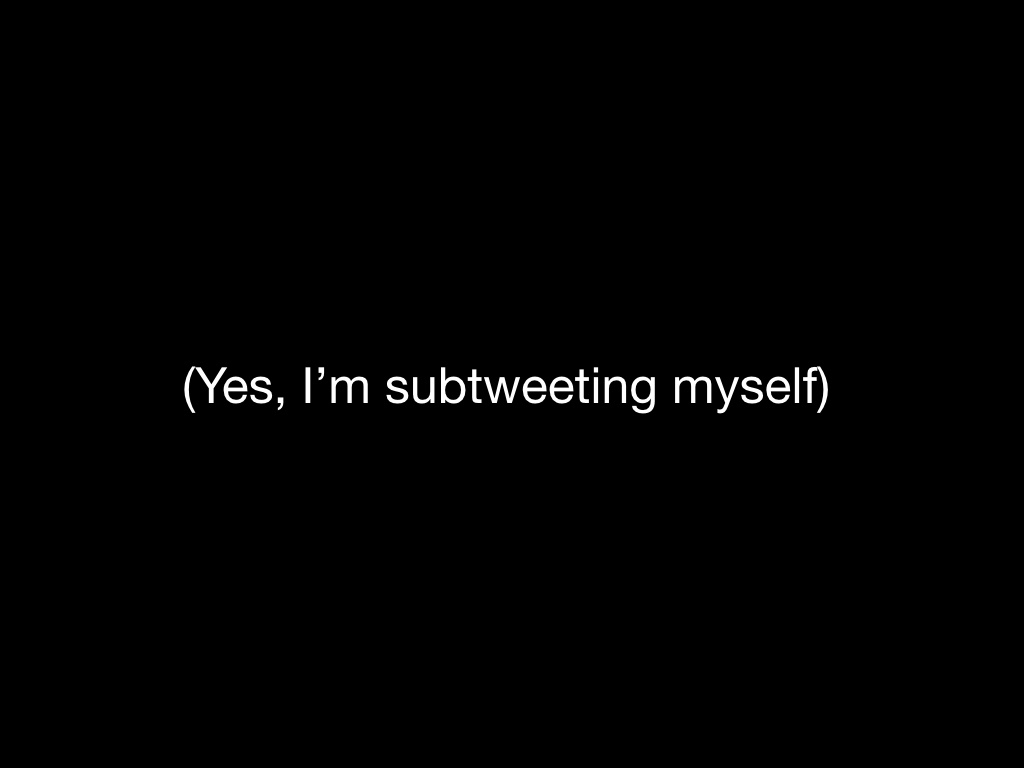
And yes, as someone standing on stage giving a lecture right now, I’m most definitely subtweeting myself.

All is not lost though. Remember, the question I started with was “how do I build a mental model”? not “do lectures have any value”. Lectures specifically are not terribly great at building mental models, but that doesn’t mean they’re without merit.
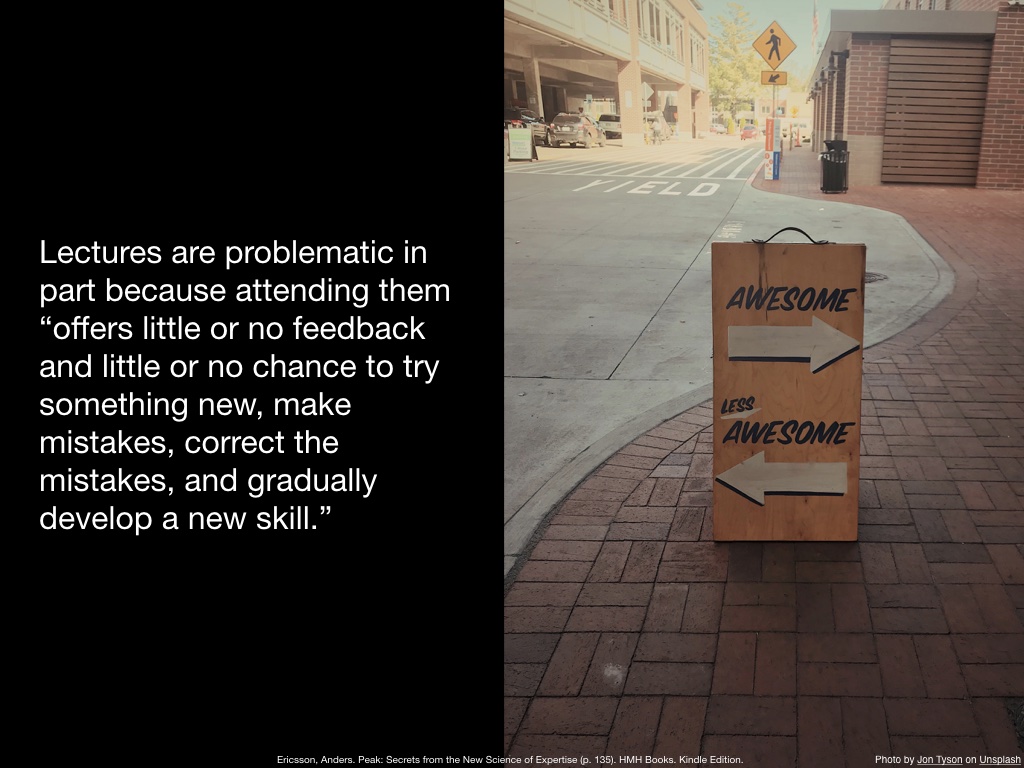
In particular, the reason lectures aren’t great at building mental models is that, on their own, they don’t offer enough feedback to build a mental model. You might receive and encode individual facts while listening to one, but without questioning and interaction, it is difficult to connect these facts into a cohesive model.
__________________________
Quote Citation: Ericsson, Anders. Peak: Secrets from the New Science of Expertise (p. 135). HMH Books. Kindle Edition.
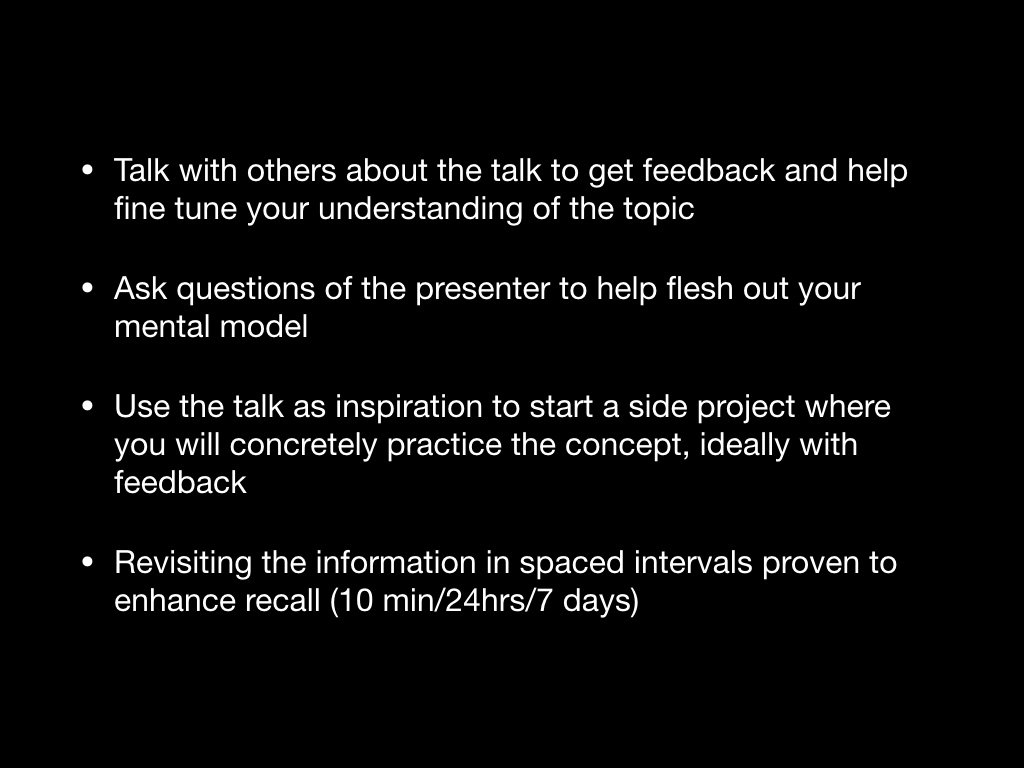
How can you increase the feedback from lectures to help leverage them for mental model building? A few of these actions might get you closer.
The most relevant simile here is of an athlete watching a youtube video. You wouldn’t expect them to be better at their sport just by watching the video. Unless they then took whatever knowledge they got from the video and put it concretely into practice, little would be gained.

But ok, if some of our traditional learning methodologies aren’t optimal for mental model building, what is?

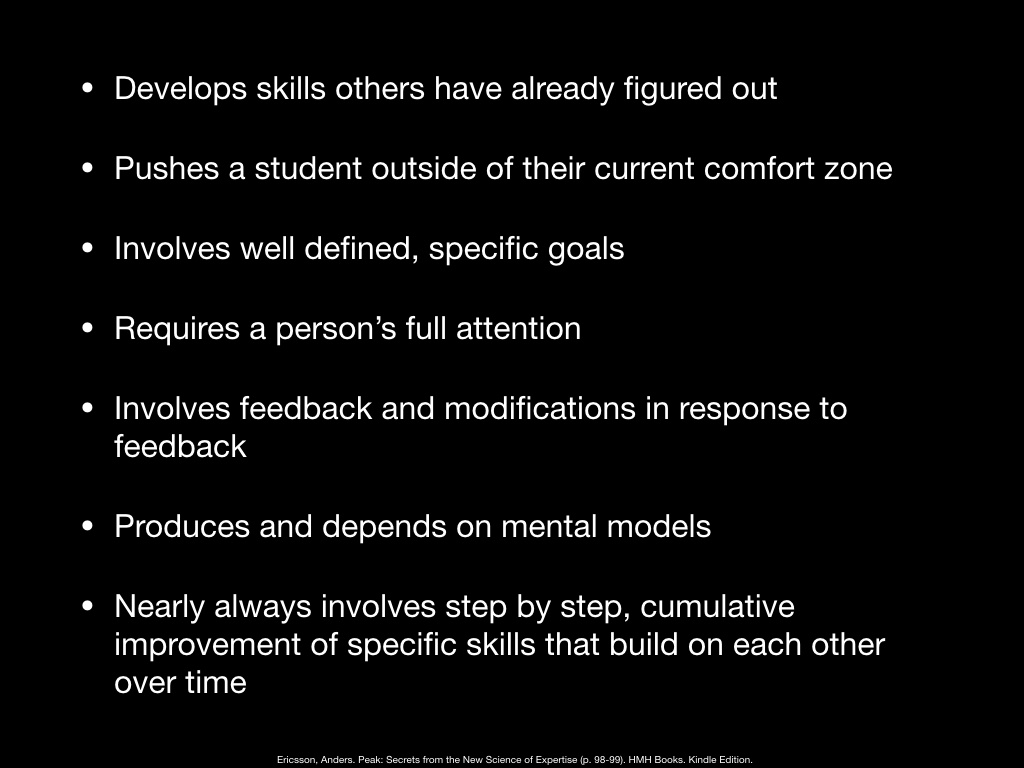
Now the definition of true deliberate practice is quite complex. It revolves around having a predefined set of skills for expertise and then taking measured, buildable steps towards those skillsets under the eye of a knowledgeable teacher capable of giving specific feedback. __________________________
Citation: Ericsson, Anders. Peak: Secrets from the New Science of Expertise (p. 98-99). HMH Books. Kindle Edition.

But unfortunately for us in the software industry, this first point is troubling. The first requirement of deliberate practice is that you are working in an area with a known definition of mastery, as in chess.
__________________________
Definition Citation: Ericsson, Anders. Peak: Secrets from the New Science of Expertise (p. 98-99). HMH Books. Kindle Edition.

So by the nature of the work we do as software developers, we can’t be full practitioners of deliberate practice because we have no universal standard for what an expert in our field is. Everyone in this room probably has a different idea of what constitutes an expert software developer.
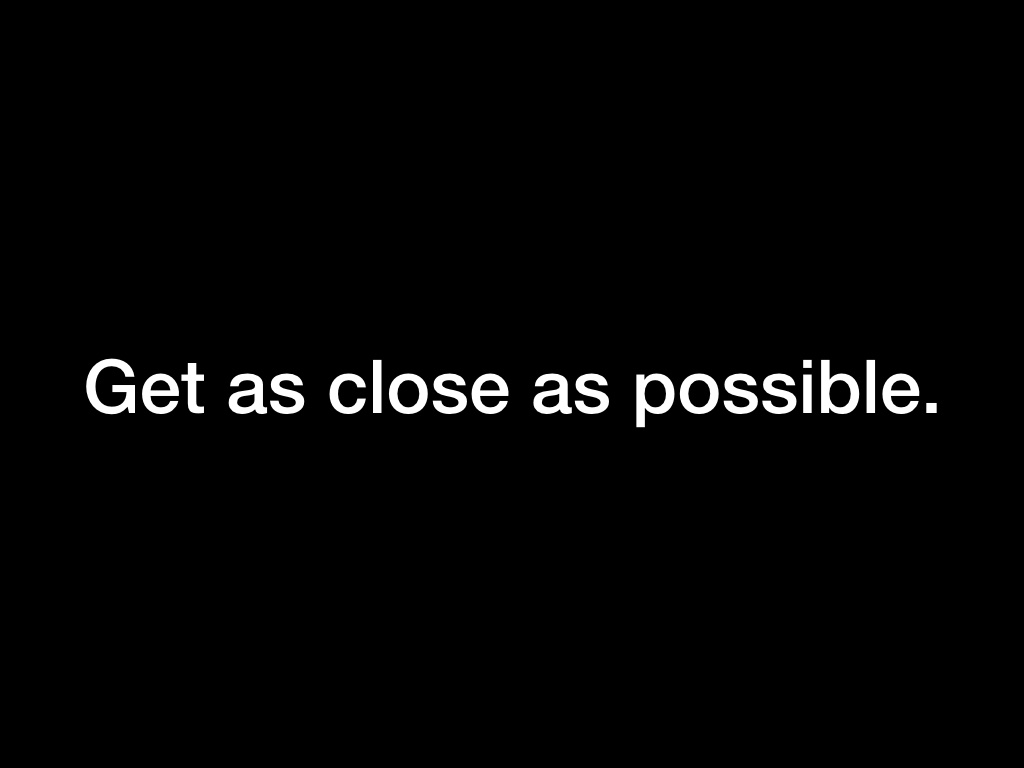
But that’s ok. Because the next best thing to deliberate practice is practice inspired by deliberate practice, otherwise dubbed “purposeful practice” by Anders Ericcson.
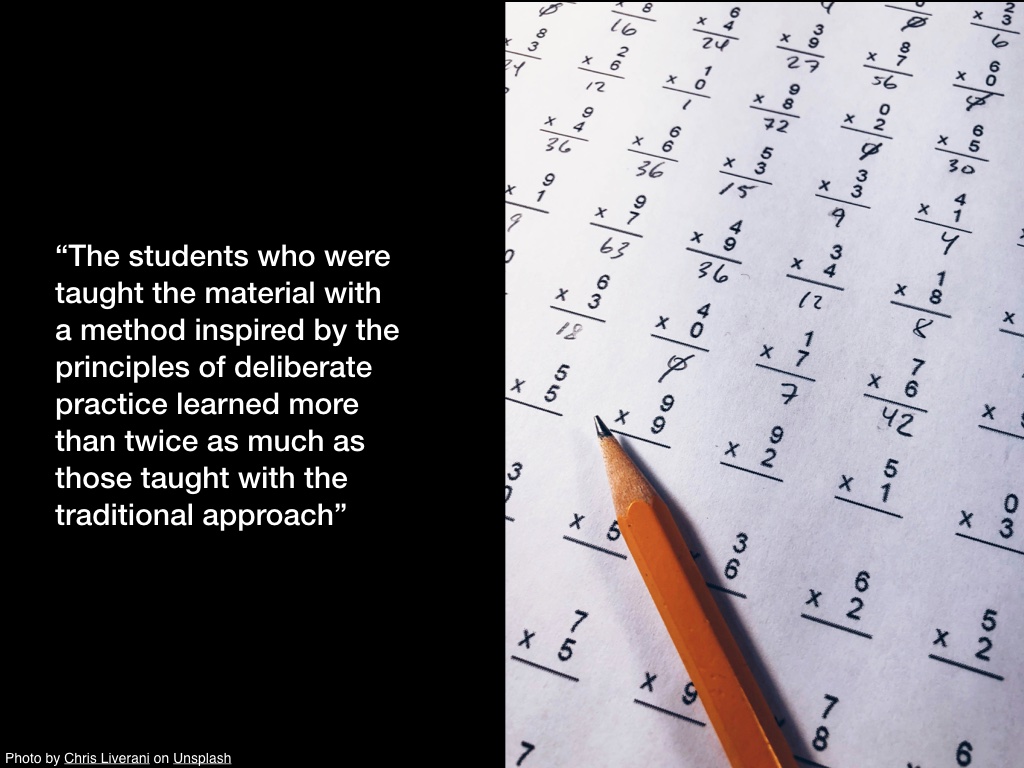
Now if “getting as close as possible” doesn’t seem very inspired, I assure you it is far more effective than you might believe. In another field without a quantifiable definition of mastery, teaching, approximating deliberate practice caused students in that section to learn twice as much compared to students in the control section of the course which continued to be taught in standard lecture format.
__________________________
Citation: Ericsson, Anders. Peak: Secrets from the New Science of Expertise (p. 243). HMH Books. Kindle Edition.
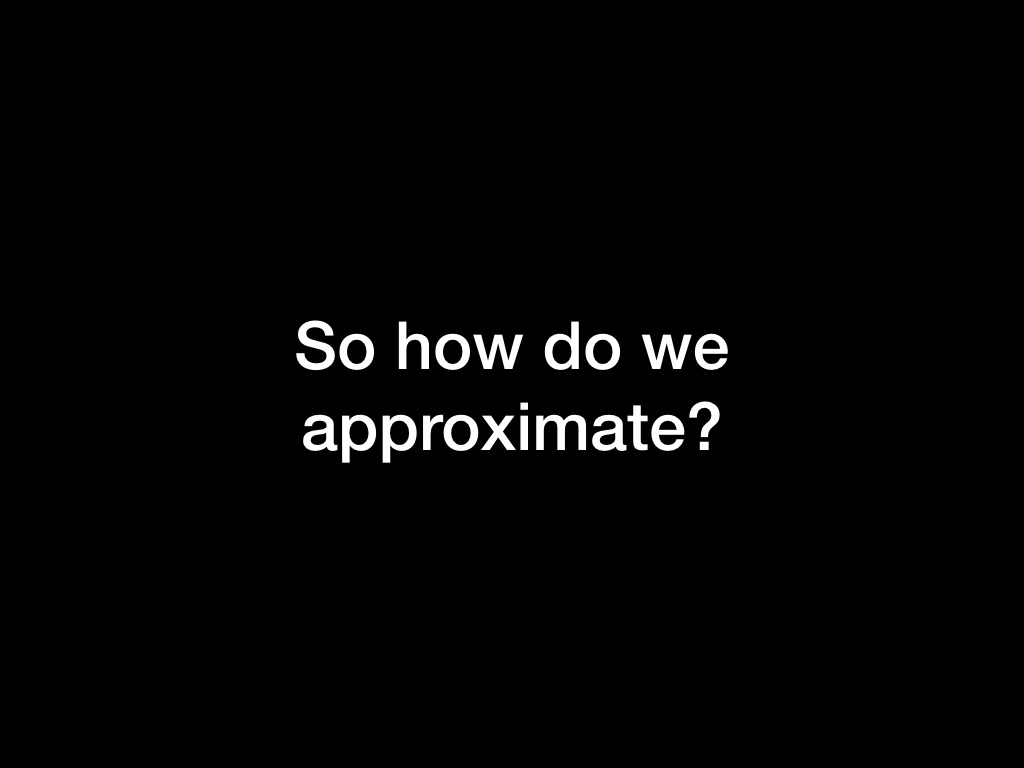
So what does approximating deliberate practice look like for software engineers?

First you need to find someone in the field you deem to be an expert.

Then you need to identify concrete skills that set them apart and contribute to their success.
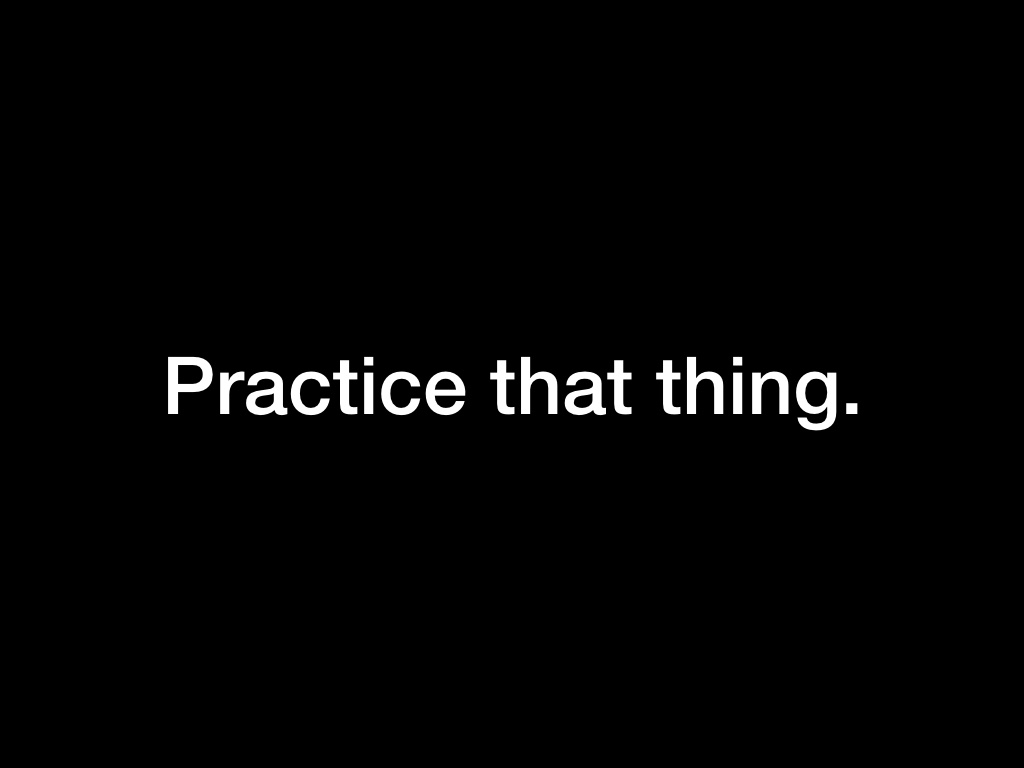
And then you need to determine a practice plan that will help you develop those skills.
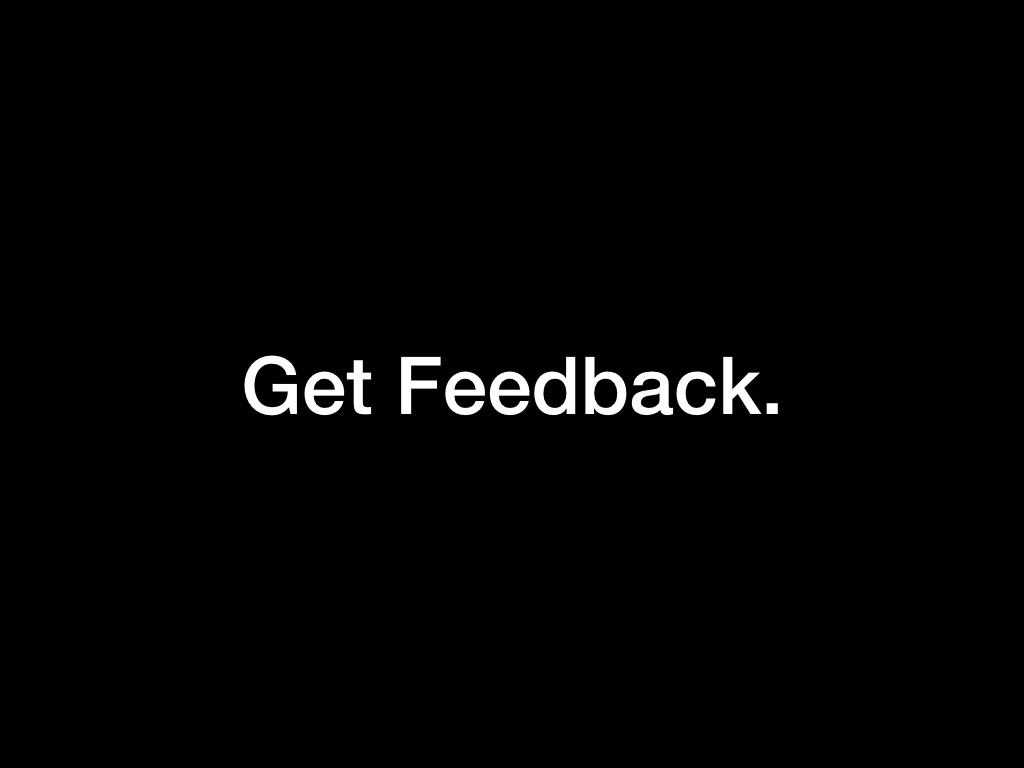
And then you need to get feedback on how well your practice is helping you gain the skillset you identified.

And then you practice some more, and get some more feedback, and practice again, etc etc. An extremely key component of this process, as you might be able to tell, is getting feedback.
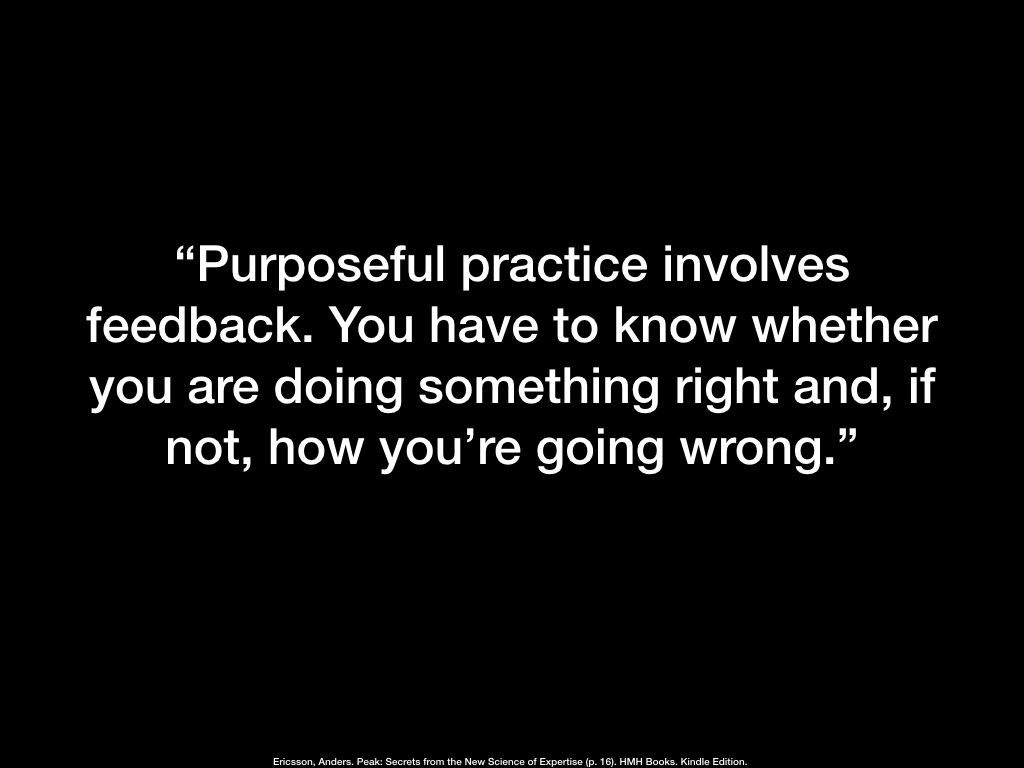
And this is because you can’t have purposeful practice without feedback.
__________________________
Quote citation: Ericsson, Anders. Peak: Secrets from the New Science of Expertise (p. 16). HMH Books. Kindle Edition.

Now this should terrify anyone in the software field. For most of us, it is standard to get substantive feedback only in once or twice yearly performance reviews.
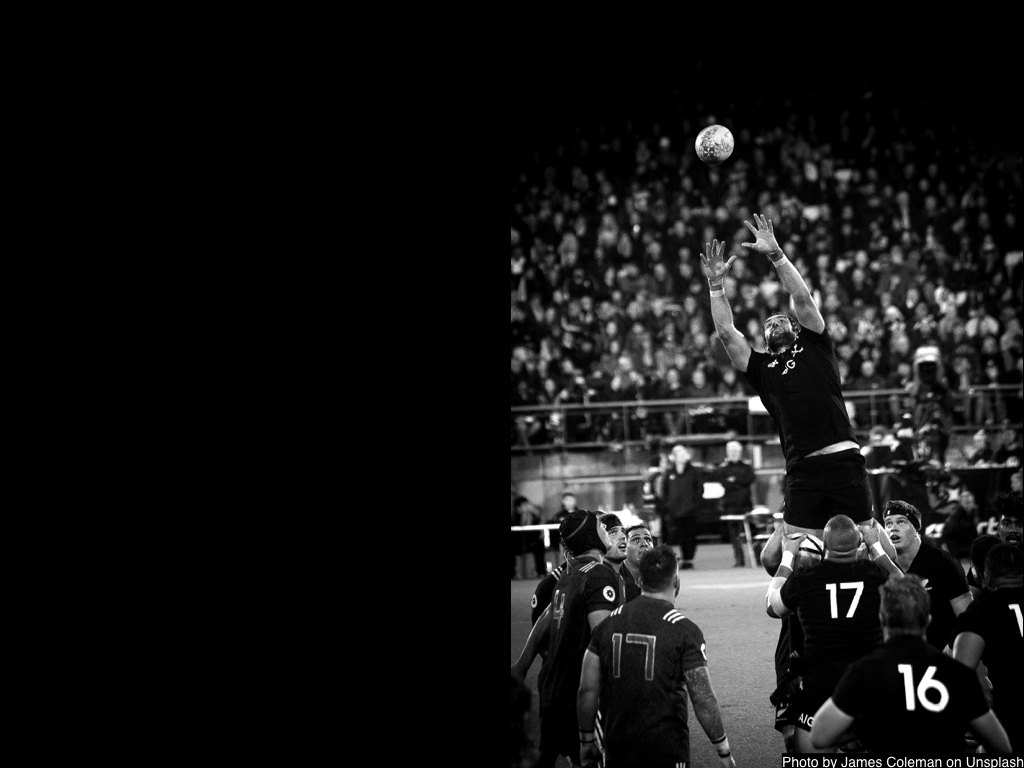
If this doesn’t seem ridiculous to you, think about professional sports. Imagine a rugby player playing an entire season, and then on the last day of the season, the coach sits them down and gives feedback on all the things they did wrong or right over the last 8 months. Then they pat them on the back, ask them to fix those things, and the player goes off to play another entire season before they meet once again the next year.
This is, of course preposterous. And it’s how it often works right now in our industry.
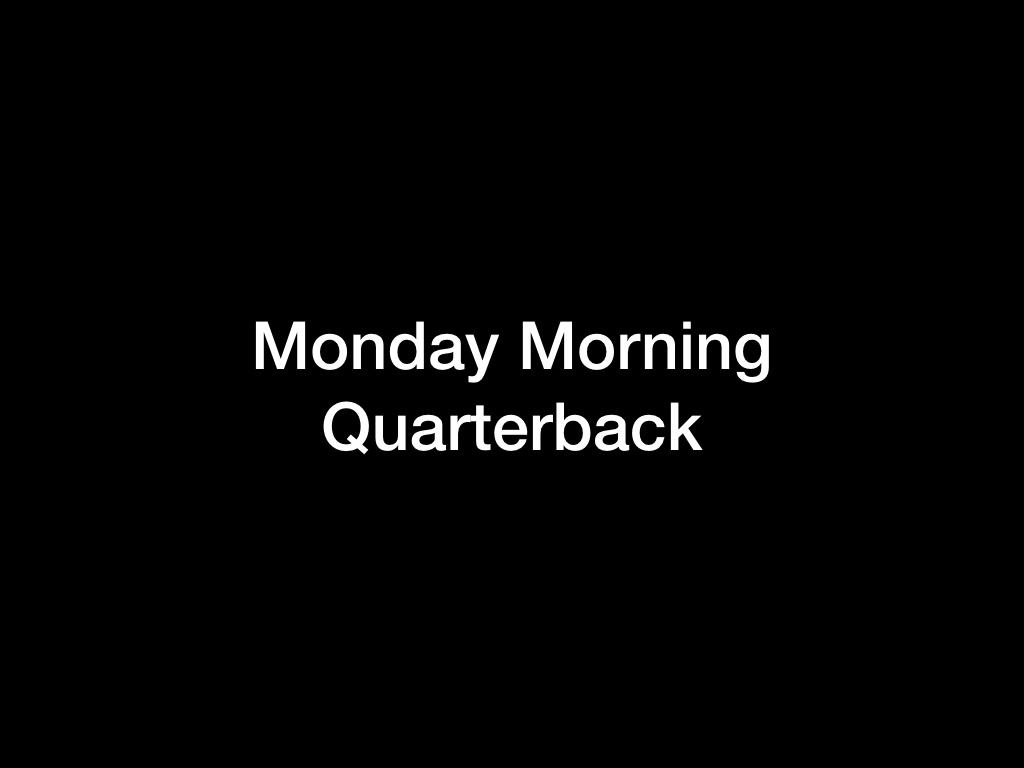
But this is not how it works in professional sports. Professional sports are one of the most highly statistic’d areas of society. They have measurements of seemingly everything and they are constantly receiving feedback.
Indeed in the NFL, there is the concept of the Monday morning QB.

While it’s generally considered a negative phrase, it has come to capture a dynamic where on Monday, after a team plays their traditional Sunday football game, the QB spends all morning pouring over the tapes, watching and rewatching and analyzing and dissecting what went wrong.*
This phrase is pejorative, but this is actually exactly what research is telling us works best.
*PS: the origin of this phrase is pretty interesting. I encourage you to read about it.

So how can you fake this for yourself? The author Anders Ericsson suggests that one way to do this is to set up your own monthly performance reviews. Create goals, and then check in on them (honestly and ruthlessly) each month.

Or start using code reviews as deliberate practice— pinpoint a specific skill you’re learning and ask your coworkers to give you feedback on it every time you put up a diff. Remember, the more specific the skill you identify, the more efficient this process will be, and you should have a way to identify progress against the skill.

You can do similar things in meetings. If you, like me, are into public speaking, you might be interested in reducing filler words in your speech such as “uhm” and “so”. Tell your coworkers and have them slightly raise a hand every time you use a filler word in a meeting, or have them tally the number of times on a piece of paper. You don’t have to stop speaking or disrupt your flow, but you’ll be getting feedback that measures your progress. Focus on reducing the number of filler words each meeting.
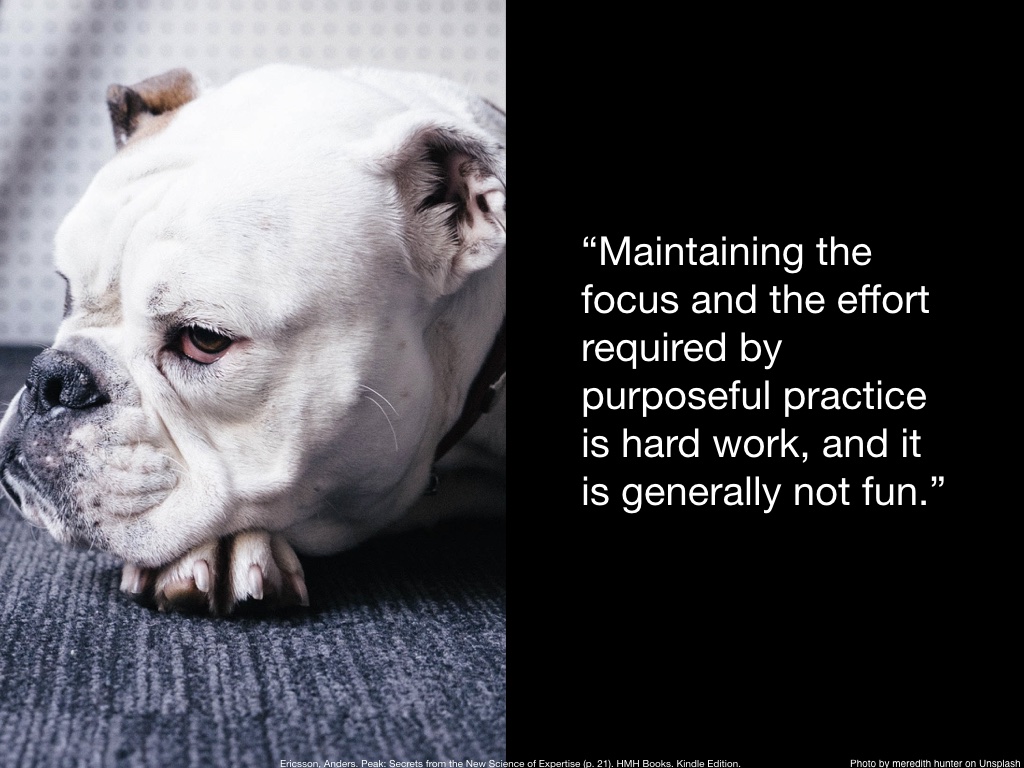
Now if all this sounds hard, IT IS. Deliberate practice is uncomfortable and exhausting.
__________________________
Quote citation: Ericsson, Anders. Peak: Secrets from the New Science of Expertise (p. 21). HMH Books. Kindle Edition.
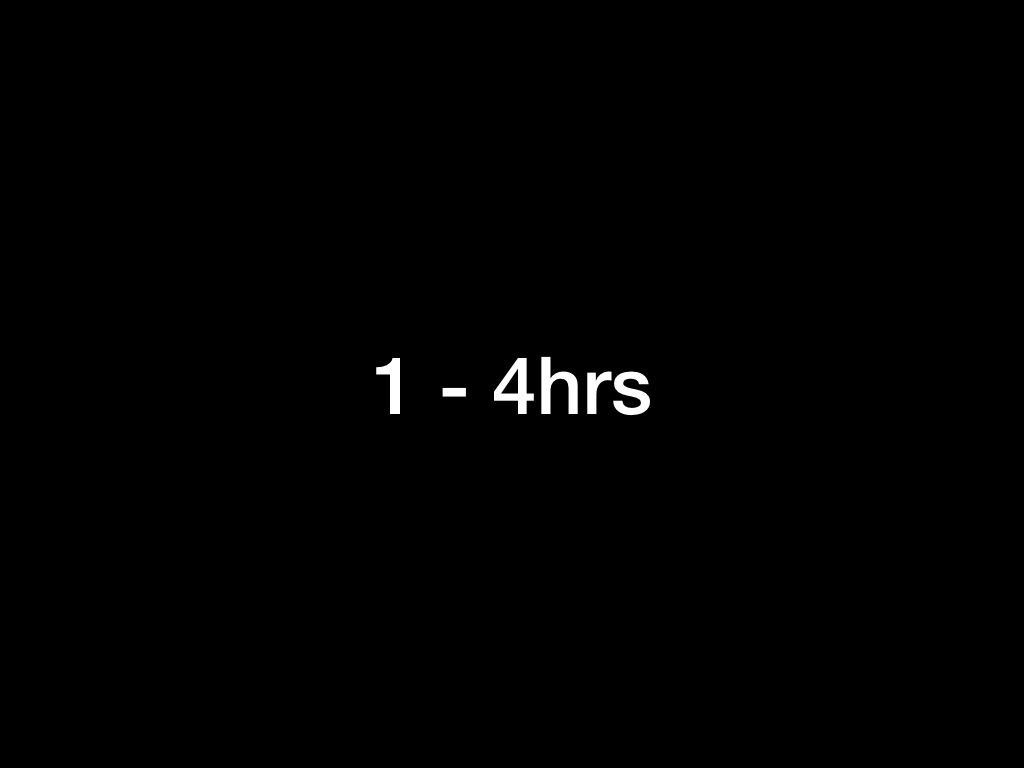
Even the best trained professionals can typically only sustain this level of intense focus for about 4 hours a day.
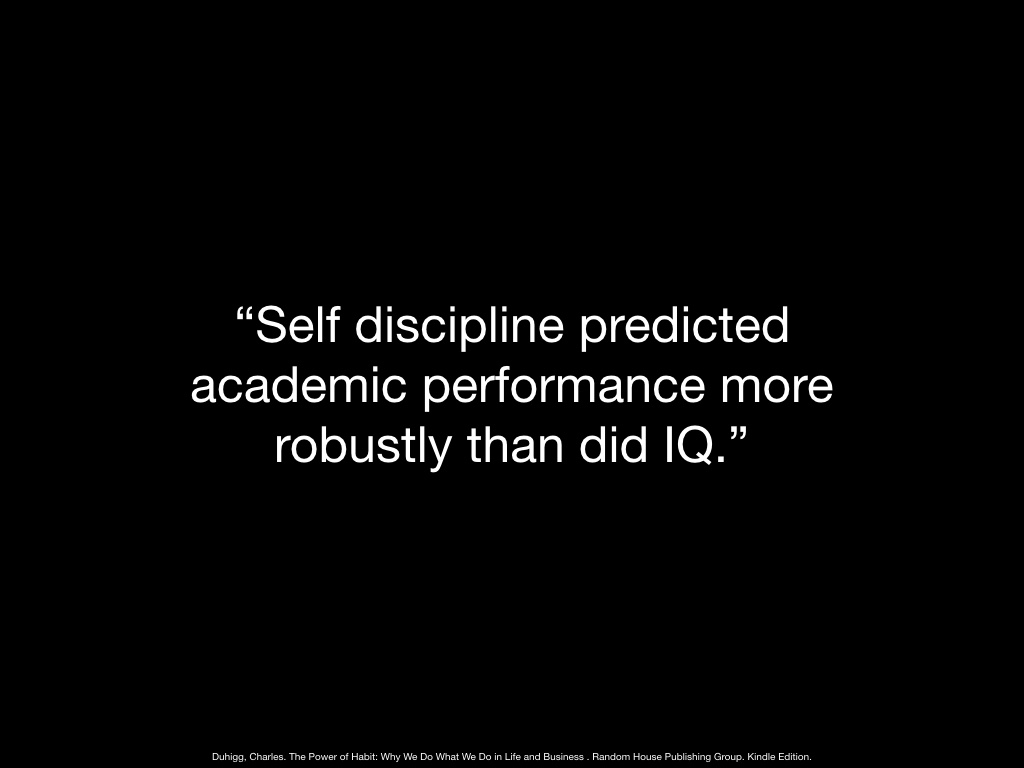
But overcoming this discomfort and building this skill will pay dividends. There is some research that shows that self discipline, such as the discipline built and used by deliberate practice, more accurately predicted academic performance than IQ.
__________________________
Quote citation: Duhigg, Charles. The Power of Habit: Why We Do What We Do in Life and Business . Random House Publishing Group. Kindle Edition.

Further, the feats achievable through deliberate practice are staggering. In one study researchers recruited patients with presbyopia, which is a problem resulting from the eye losing elasticity in the lens that makes it difficult to focus on nearby objects. They had these subjects come into the lab and practice spotting faint dots on a background several times a week. At the end of a three month practice period, on average subjects were able to read letters 60% smaller, and were able to read them faster than before. Every subject was also able to read a newspaper without glasses, which was something most of them were unable to do before the practice sessions. What is remarkable here is that the physical issue with the elasticity of the eye’s lens was still there, but the patients were able to train their brain to better process the fuzzy signals the eye was sending it to compensate.
Note: this is not to suggest that all physical maladies can be overcome with training. It is a single example to illustrate that deliberate practice can achieve great improvements even in areas where improvement is hard.
__________________________
Citation: Ericsson, Anders. Peak: Secrets from the New Science of Expertise (p. 36). HMH Books. Kindle Edition.

Ok, so we’ve established that sticking with deliberate practice can yield extremely powerful improvements, but that the practice itself can be difficult and tiring.

This necessarily leads us to considerations of how to motivate people to stick with the practice long enough to reap the rewards.

One quote that really resonated with me was this one, which posits that people stop when they have insufficient reasons to continue, suggesting that if we want people to continue we must find ways to beef up the reasons to practice
__________________________
Quote Citation: Ericsson, Anders. Peak: Secrets from the New Science of Expertise (p. 169). HMH Books. Kindle Edition.
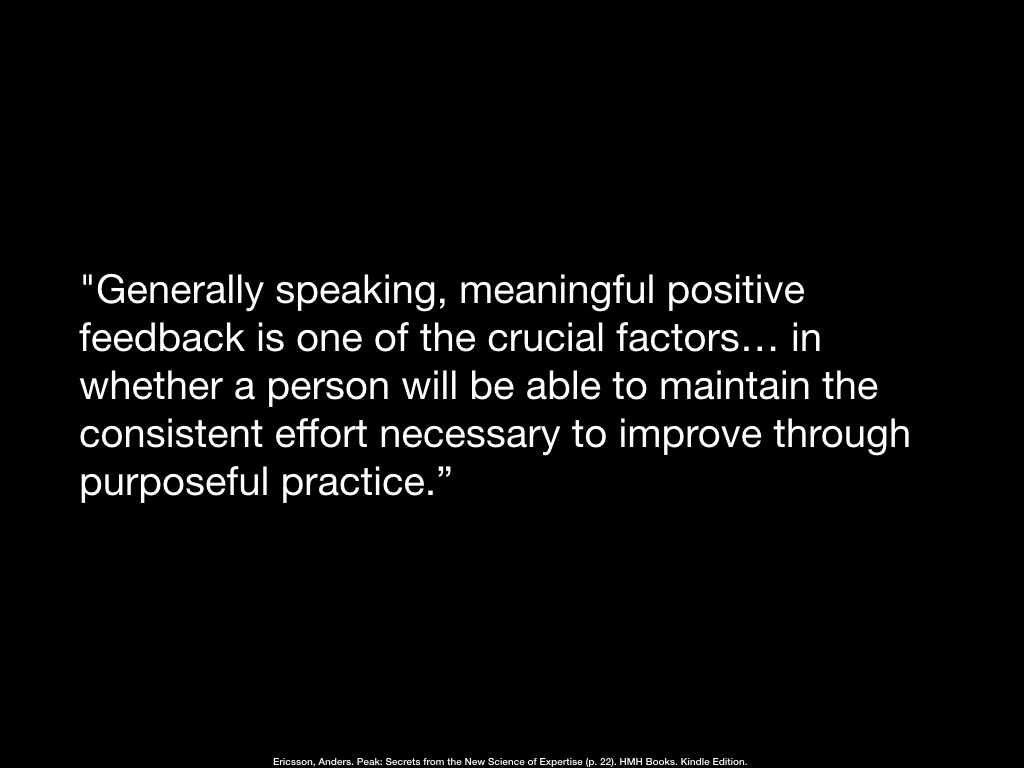
The same author points out positive feedback is one such factor that can be boosted in order to make continued practice more alluring
__________________________
Quote citation: Ericsson, Anders. Peak: Secrets from the New Science of Expertise (p. 22). HMH Books. Kindle Edition.

In the world of athletics, one way athletes get positive feedback is through competitions. The anticipation of a competition is what gets them through the difficult days and weeks and sometimes months of practice and conditioning.

And if you’re thinking, ok, an athlete competing in a game is not the same as me showing up to an office, I’m not about to practice HashMaps for 3 months just in anticipation of going to work on a random Monday, well, I have news for you.
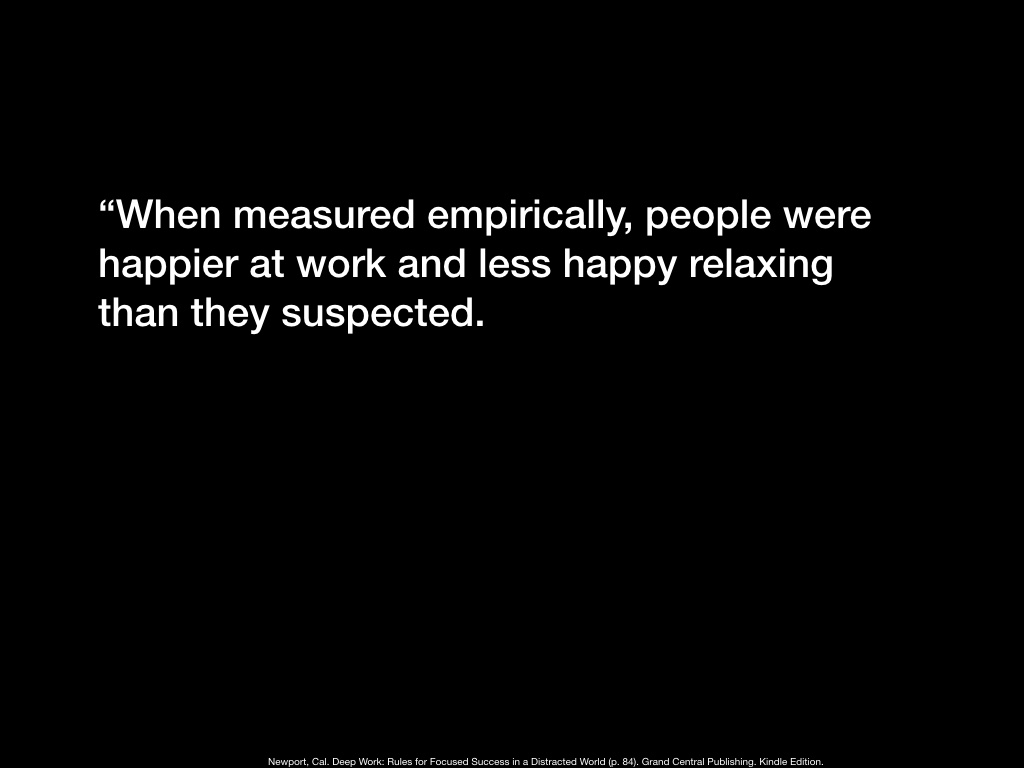
It turns out that people are much happier at work and less happy relaxing than they predict.
__________________________
Quotation Citation: Newport, Cal. Deep Work: Rules for Focused Success in a Distracted World (p. 84). Grand Central Publishing. Kindle Edition.

And that this happiness was tied to the number of flow occurrences in a week. This led the author to conclude “human beings, it seems, are at their best when immersed deeply in something challenging” which is a 🔥 quote if I’ve heard one.
__________________________
Quotation Citation: Newport, Cal. Deep Work: Rules for Focused Success in a Distracted World (p. 84). Grand Central Publishing. Kindle Edition.
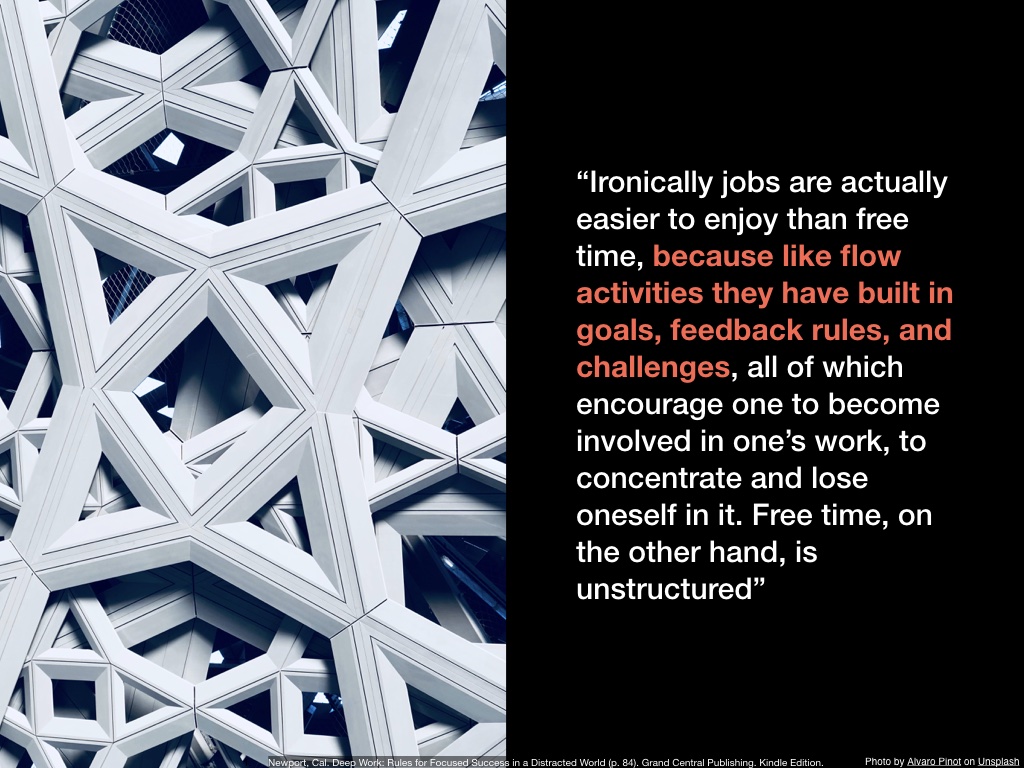
An interesting result of this conclusion about the relation of flow with self reported happiness is that it can be easier to enjoy work than free time, because the structure and challenges inherent to a job lend themselves to flow more readily than unstructured free time.
__________________________
Quote Citation: Newport, Cal. Deep Work: Rules for Focused Success in a Distracted World (p. 84). Grand Central Publishing. Kindle Edition.

The key point here is flow. Flow’s relationship with happiness tells us that we should be optimizing for it if we want to optimize our own happiness.

But here’s the thing. Professional athletes have cultivated work environments that are tuned for focus. When you are in one of these spaces, the expectation is that you are focused on the game.

On the sidelines, no one is sending emails or scheduling dry cleaning pickup. They are watching the game, or conversing with teammates about the game, ready to go in.

But the workspaces of knowledge workers seem custom built to thwart flow at every turn. We are often put in large open offices, where people are moving and talking and tapping on your shoulder at every turn.

In between getting interrupted in big rooms filled with people, we get interrupted by moving to smaller rooms filled with people, aka meetings, which always look more productive in stock photos than they are in real life.

And even if you escape the big interruption rooms and the small interruption rooms we have VIRTUAL INTERRUPTION ROOMS! Emails, Slack, Twitter, text messages, notifications, and more all vying for your attention on the very machine you must have open at all times in order to do your work.

Worst of all, because knowledge work is nebulous and hard to measure, busyness has increasingly become a proxy for demonstrating value. If you as an individual try to break the interruption cycle by not coming to the office, not attending meetings, and not answering slack or emails, it is highly likely your boss and coworkers will believe you are slacking off and being unproductive. Even if the solitude allows you to do more deep thinking, the lack of busyness cues is likely to come at a social cost.

Which is to say, compared to athletes, the landscape for focus is bleak for knowledge workers.

And this is costly. Cal Newport offers this equation, that high quality work is a product of time spent and the amount of focus.
If we believe this equation, then the way we can produce more high quality work is by adjusting either time spent or intensity of focus.
__________________________
Equation citation: Newport, Cal. Deep Work: Rules for Focused Success in a Distracted World (p. 42). Grand Central Publishing. Kindle Edition.
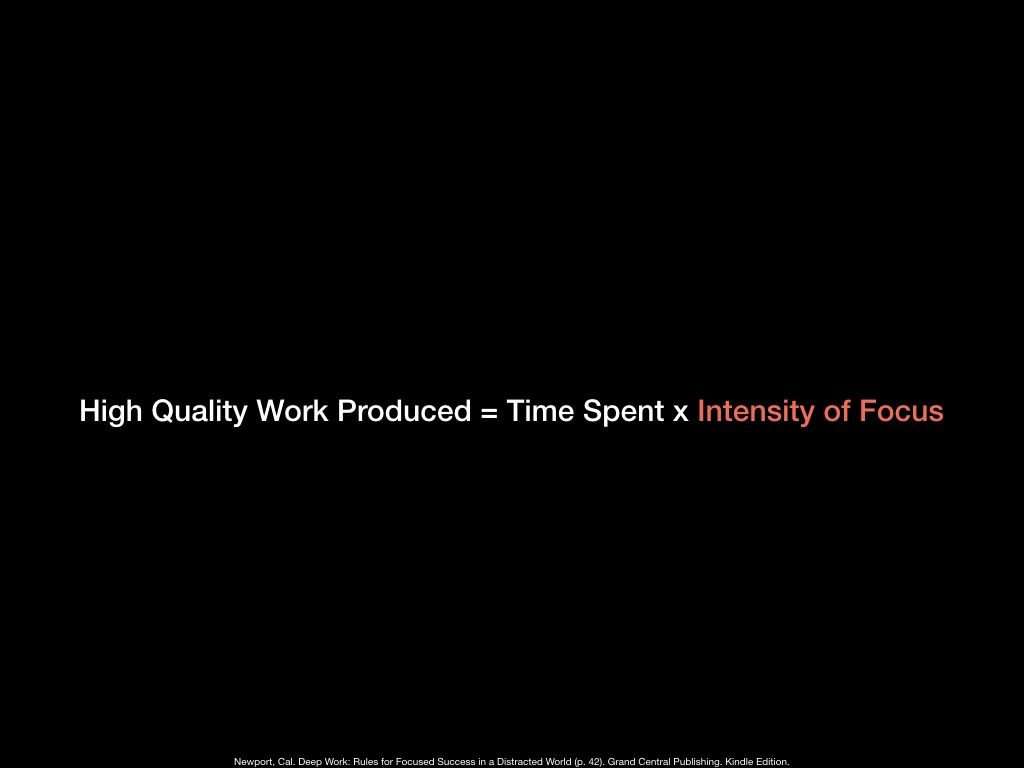
Let’s start by looking at the intensity of focus piece

It turns out that we’re not very good at focusing in offices. And by not good, I mean awful.
__________________________
Quote Citation: Gloria Mark, Professor in the Department of Informatics at the University of California, Irvine in an interview with FastCompany 7.28.08 https://www.fastcompany.com/944128/worker-interrupted-cost-task-switching

It turns out that we switch entire spheres of work (i.e. switching from one project space to a different one rather than from two tasks within a similar topic) about every ten and a half minutes.
__________________________
Citation: Gloria Mark, Professor in the Department of Informatics at the University of California, Irvine in an interview with FastCompany 7.28.08 https://www.fastcompany.com/944128/worker-interrupted-cost-task-switching

And before you blame your coworkers, Dr Mark’s team found that about half of these interruptions were self interruptions. And if you’re thinking “I don’t interrupt myself this much”, checking Twitter while Gradle builds your app definitely falls into this category.
__________________________
Citation: Gloria Mark, Professor in the Department of Informatics at the University of California, Irvine in an interview with FastCompany 7.28.08 https://www.fastcompany.com/944128/worker-interrupted-cost-task-switching
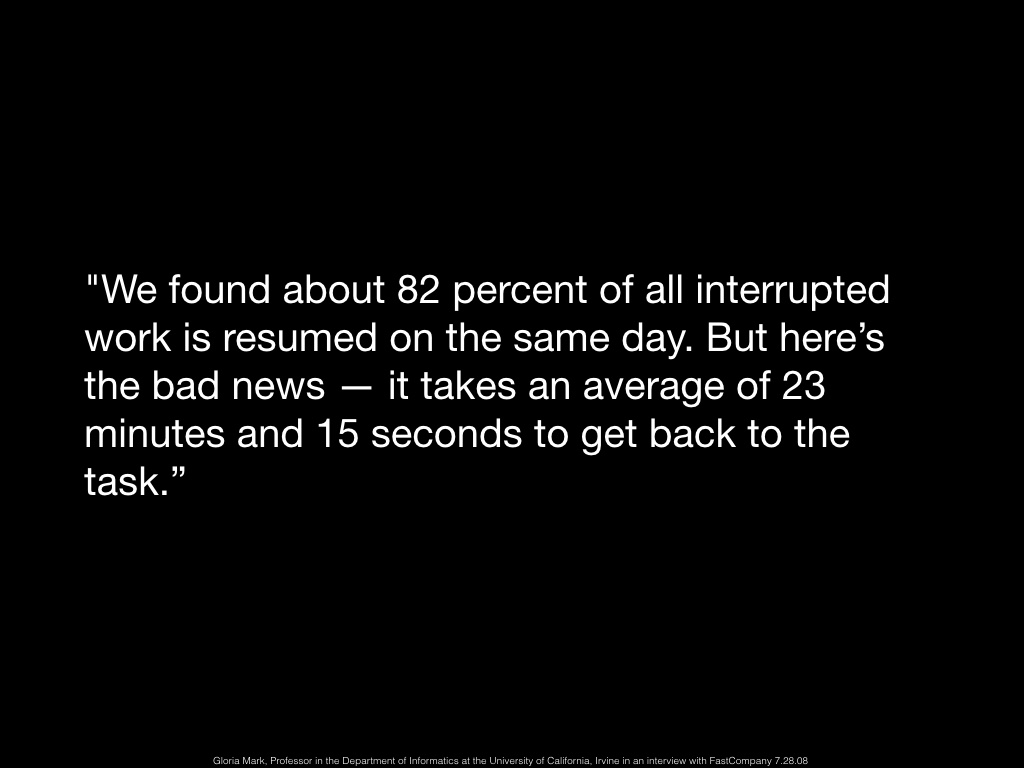
When quantifying the cost of these interruptions, Dr Mark’s team found that most were resumed the same day, but that the time between the interruption and the resumption averaged 23 minutes and 15 seconds.
__________________________
Citation: Gloria Mark, Professor in the Department of Informatics at the University of California, Irvine in an interview with FastCompany 7.28.08 https://www.fastcompany.com/944128/worker-interrupted-cost-task-switching
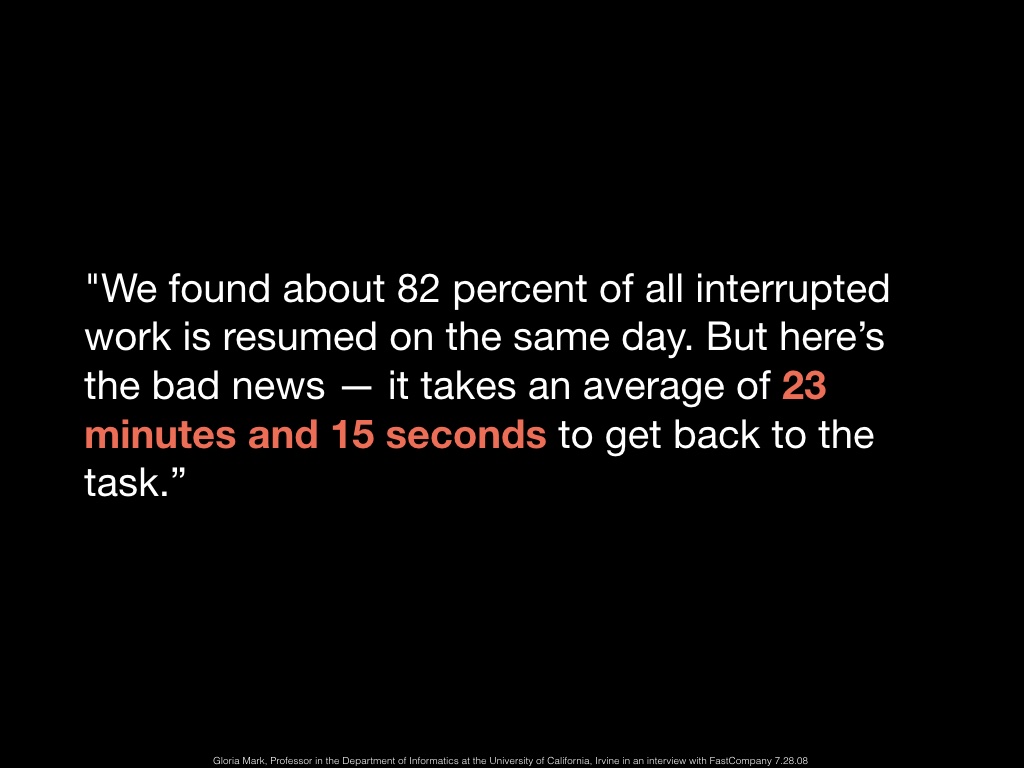
That is a lot of minutes and seconds 😱😱😱
__________________________
Citation: Gloria Mark, Professor in the Department of Informatics at the University of California, Irvine in an interview with FastCompany 7.28.08 https://www.fastcompany.com/944128/worker-interrupted-cost-task-switching
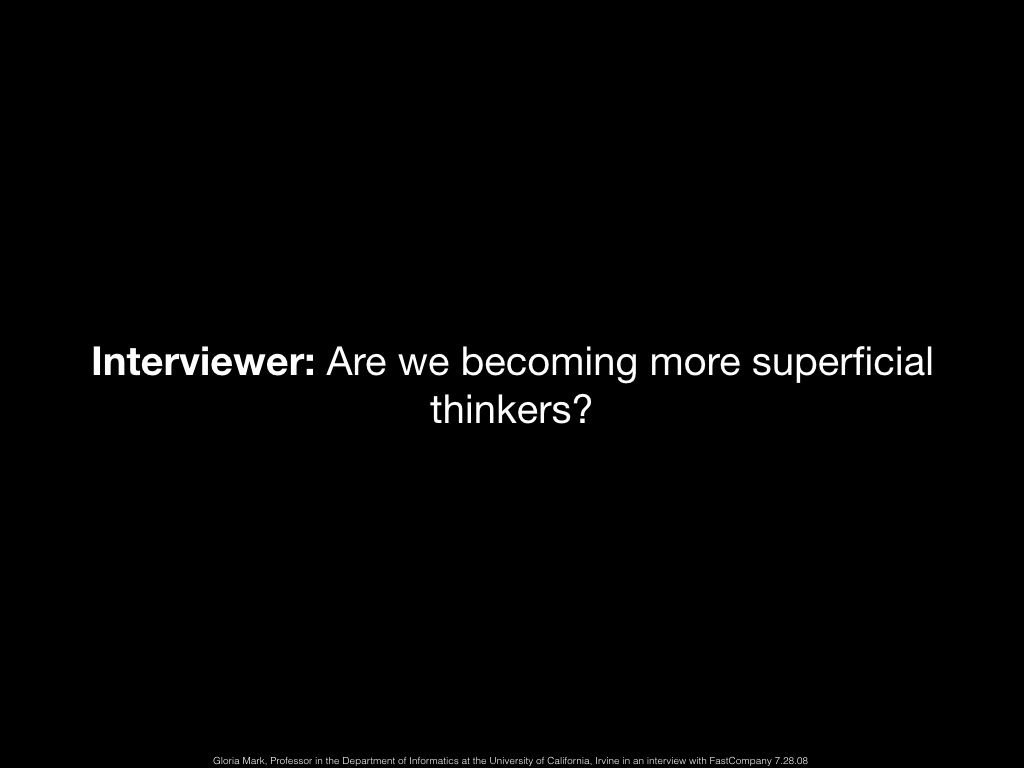
After hearing all of these facts, the interviewer asked Dr Marks whether she thought we were becoming more superficial thinkers.
__________________________
Citation: Gloria Mark, Professor in the Department of Informatics at the University of California, Irvine in an interview with FastCompany 7.28.08 https://www.fastcompany.com/944128/worker-interrupted-cost-task-switching
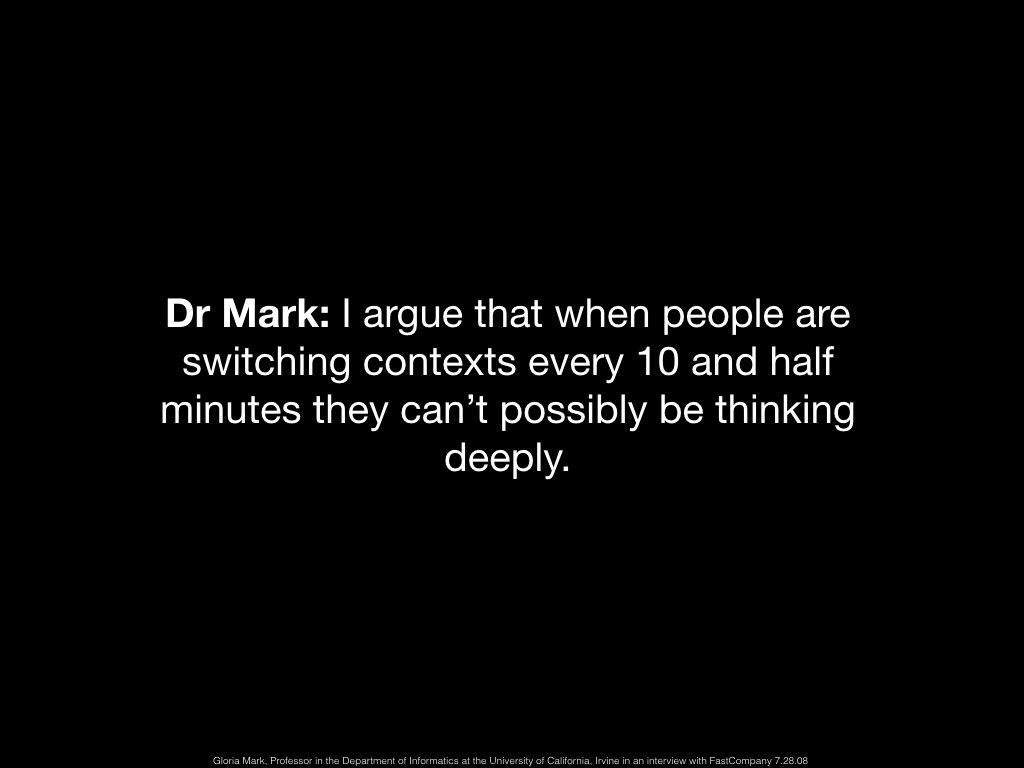
And her response captures what all of us as knowledge workers were already feeling.
__________________________
Citation: Gloria Mark, Professor in the Department of Informatics at the University of California, Irvine in an interview with FastCompany 7.28.08 https://www.fastcompany.com/944128/worker-interrupted-cost-task-switching

Citation: Gloria Mark, Professor in the Department of Informatics at the University of California, Irvine in an interview with FastCompany 7.28.08 https://www.fastcompany.com/944128/worker-interrupted-cost-task-switching
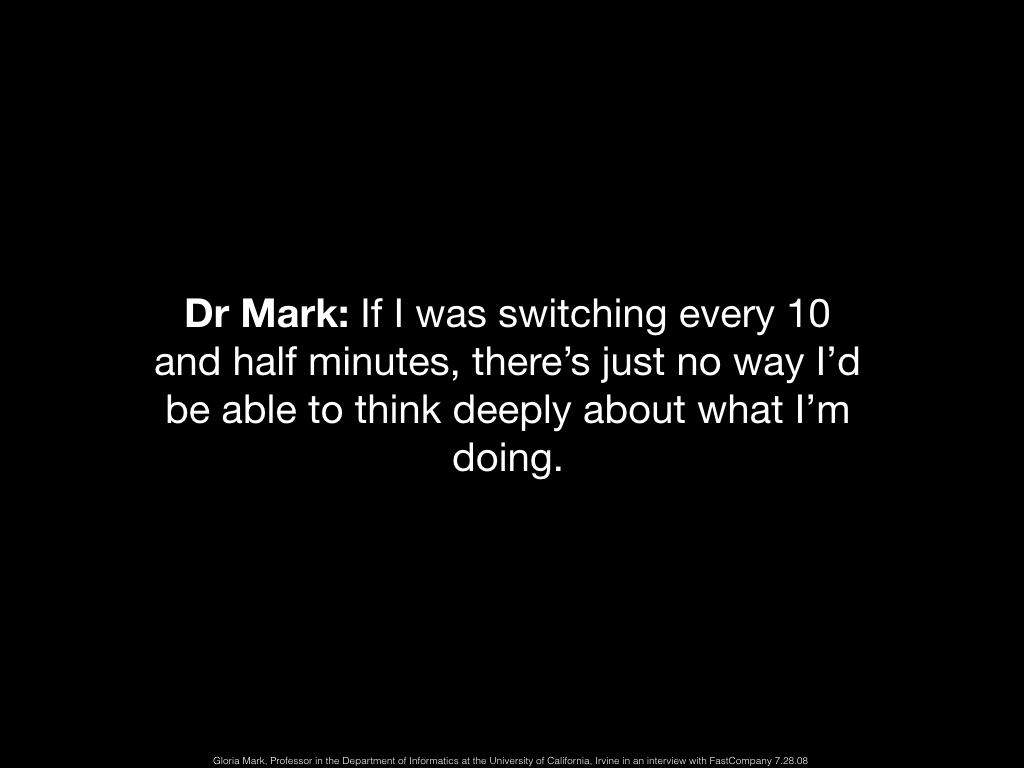
Citation: Gloria Mark, Professor in the Department of Informatics at the University of California, Irvine in an interview with FastCompany 7.28.08 https://www.fastcompany.com/944128/worker-interrupted-cost-task-switching
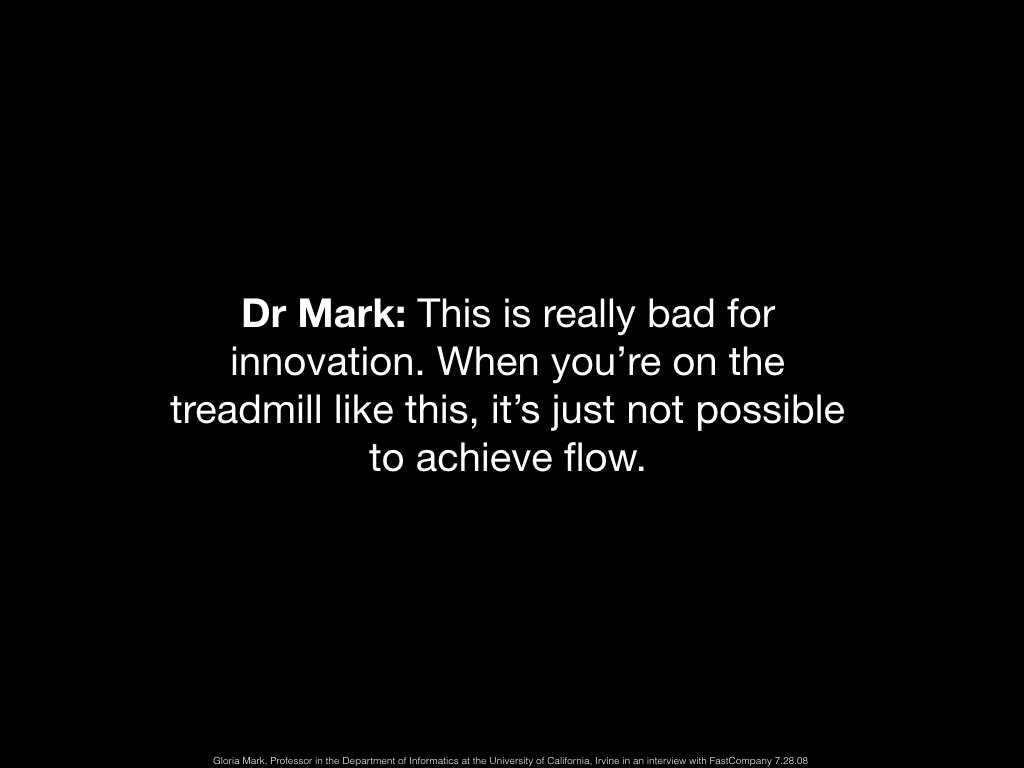
Citation: Gloria Mark, Professor in the Department of Informatics at the University of California, Irvine in an interview with FastCompany 7.28.08 https://www.fastcompany.com/944128/worker-interrupted-cost-task-switching
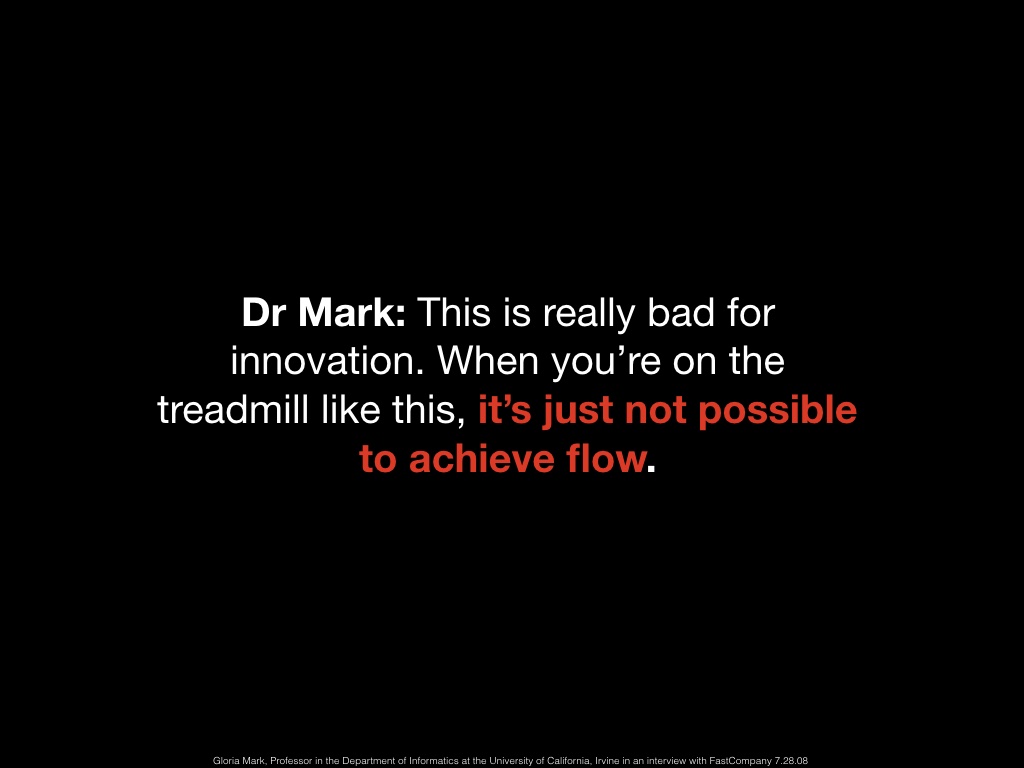
This inability to achieve flow that Dr Mark points out should worry us, because as we saw earlier there is evidence that the number of times an individual achieves flow in a given week is tied to their self reported happiness. Removing the ability to achieve flow lessens our likelihood of self reported happiness.
__________________________
Citation: Gloria Mark, Professor in the Department of Informatics at the University of California, Irvine in an interview with FastCompany 7.28.08 https://www.fastcompany.com/944128/worker-interrupted-cost-task-switching

But beyond the removal of opportunities to experience happiness, this interruption lifestyle actively adds stress and frustration to our lives.
__________________________
Citation: Gloria Mark, Professor in the Department of Informatics at the University of California, Irvine in an interview with FastCompany 7.28.08 https://www.fastcompany.com/944128/worker-interrupted-cost-task-switching
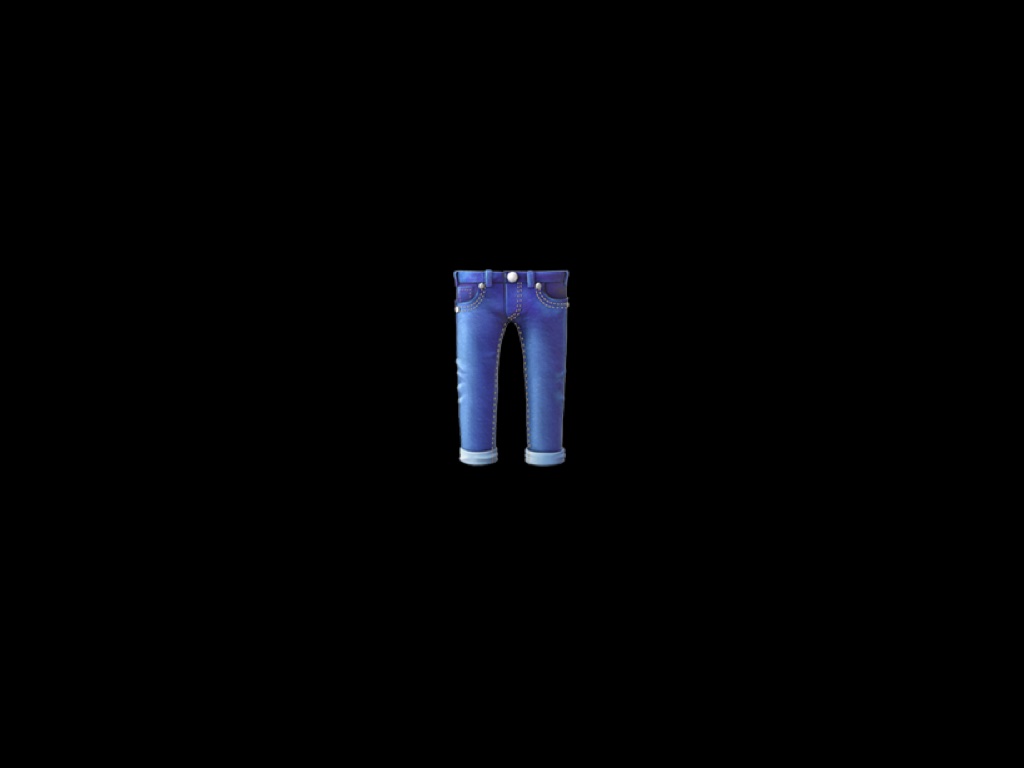
But let’s put on our pessimism pants for a moment and assume that business don’t necessarily care about worker stress/happiness. Let’s take the most ruthless interpretation of capitalism and assume that if a business doesn’t see an effect to one of their bottom lines, they won’t care about the health and well being of their employees.
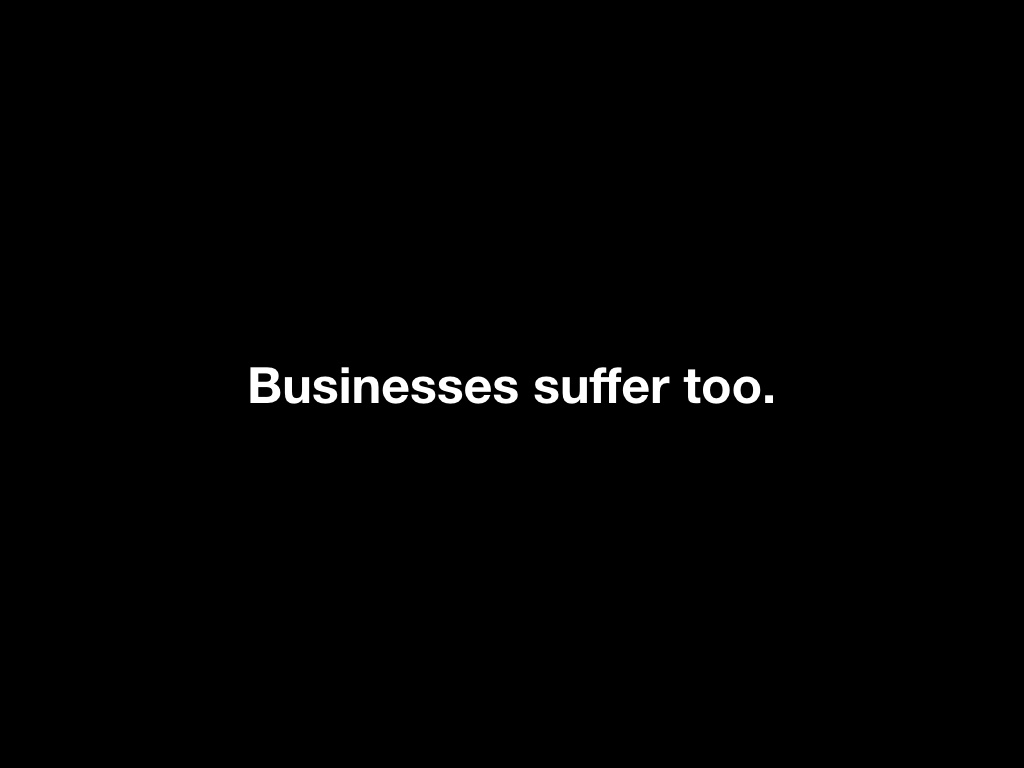
Luckily, the data shows that if we go down, we’re taking them with us.

We know this from measurements of performance around task switching based on a concept known as attention residue. Attention residue represents the thoughts and brain power occupied by a prior task after a user has switched to a new one.

Attention residue is known to increase in magnitude when the prior task was left unfinished at the time the task switching occurred.

It turns out that people experiencing attention residue tend to be poorer performers on their next task, with stronger residue correlating to worse performance.
__________________________
Quote citation: Newport, Cal. Deep Work: Rules for Focused Success in a Distracted World (p. 42). Grand Central Publishing. Kindle Edition.
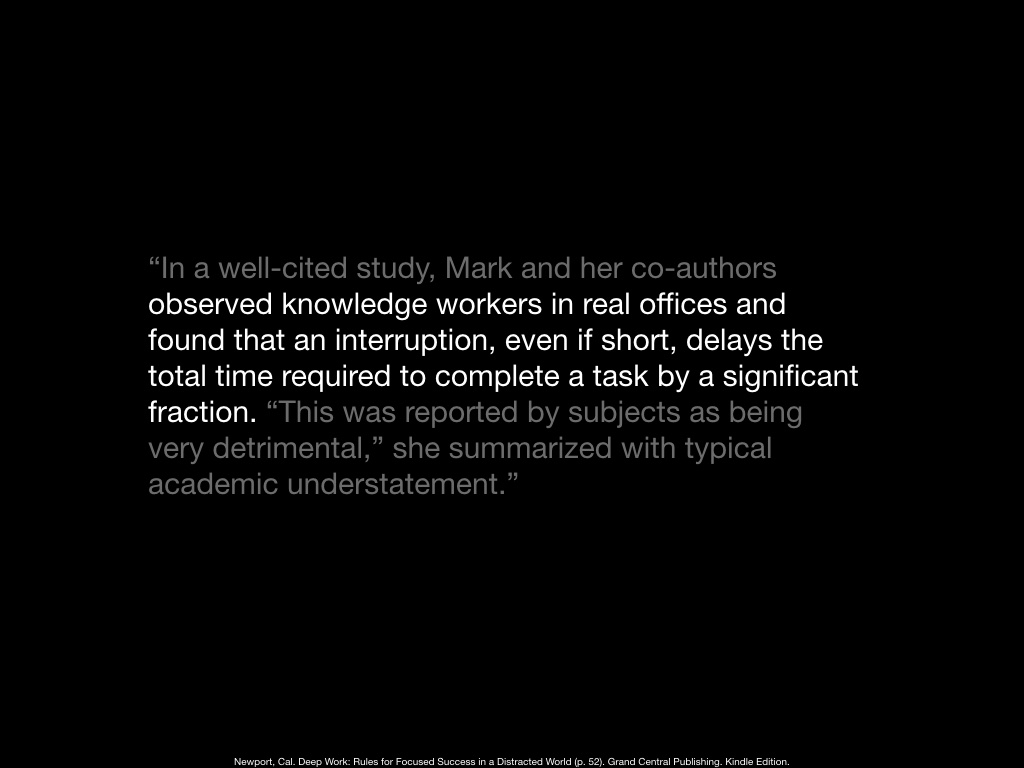
Further, a study that followed office workers in their places of work and timed their activities showed that interruptions, even when short, lengthen the total time to complete a task by a significant amount. Coupled with the last point, this means interruption rates like the ones cited by Dr Mark are causing workers to be prone to poorer performance and take longer on tasks than is otherwise needed, which is something even the most cynical business owners should be worried about.
__________________________
Quote Citation: Newport, Cal. Deep Work: Rules for Focused Success in a Distracted World (p. 52). Grand Central Publishing. Kindle Edition.
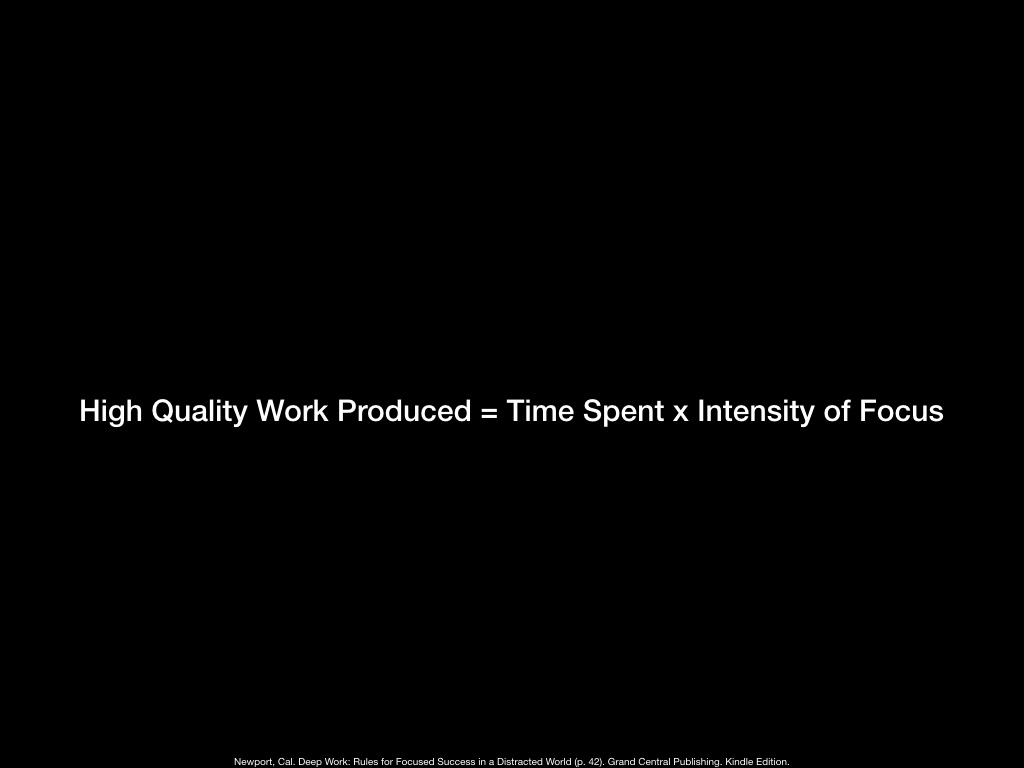
So if we continue to be cynical, just for fun, we might conclude that based on interruption data, intensity of focus is likely to be low for most brathletes…
__________________________
Equation proposed by Cal Newport: Newport, Cal. Deep Work: Rules for Focused Success in a Distracted World (p. 42). Grand Central Publishing. Kindle Edition.

…but a business should be able to offset that and recuperate high quality work production by getting employees to increase time spent.
__________________________
Equation proposed by Cal Newport: Newport, Cal. Deep Work: Rules for Focused Success in a Distracted World (p. 42). Grand Central Publishing. Kindle Edition.

The problem is, time spent can only be fine tuned so much. Because the brain is a muscle, it needs to replenish itself. Without replenishment, it begins to tire out and break down.

We heard before about ART

ART stands for “Attention restoration theory” and captures the idea that directed attention is a finite resource, and once it is depleted subjects will have difficulty performing attention demanding tasks.
Part of what is suggested by research around ART is that checking email at home in the evenings can keep the directed attention centers from replenishing.

Thus, if we continue to deplete our attention centers while at home by checking emails or performing work, and do not allow them the time to replenish (replicated in the study via walking through nature, but possible to achieve in a variety of leisure activities), we run the risk of reducing our ability to concentrate the following day, undermining our ability to get work done.
__________________________
Quote Citation: Newport, Cal. Deep Work: Rules for Focused Success in a Distracted World (p. 149). Grand Central Publishing. Kindle Edition.

But working at home is potentially hazardous not just because it keeps attention centers from replenishing, but also because one of the hallmarks of stressed out people is that they will often attempt to squeeze in more working hours at the expense of sleep.
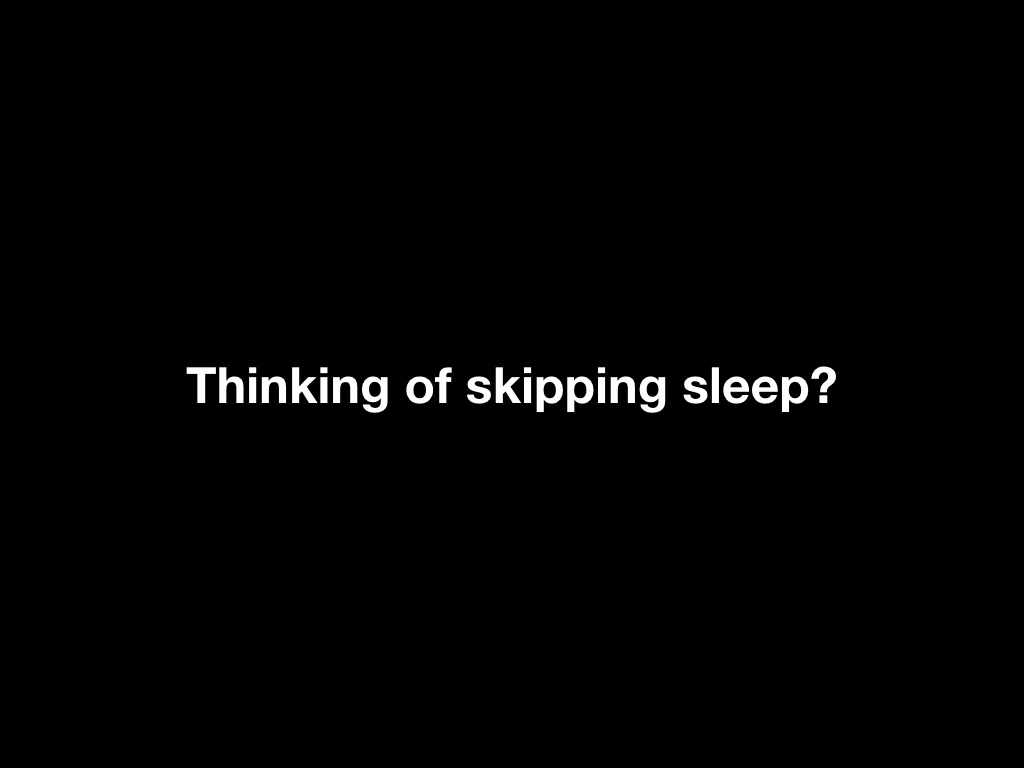
And physically and cognitively speaking, we have ample science that suggests this is a terrible terrible thing to do.
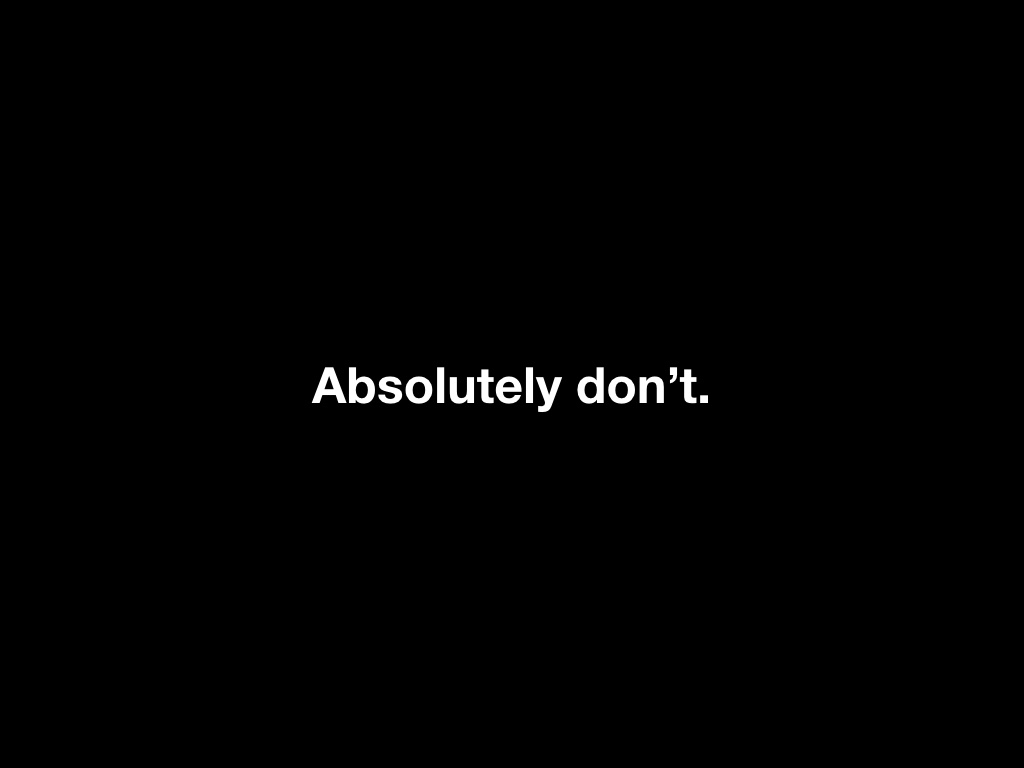
This is how things go from “real bad” to catastrophic. There is a tremendously good book by Matthew Walker called “Why We Sleep” that I personally think is one of the most perspective altering books I’ve ever read. I highly, highly recommend everyone read it. Dr Walker (PhD) outlines enough findings in the book to occupy several keynotes, but I’ll highlight just a few to illustrate the point.
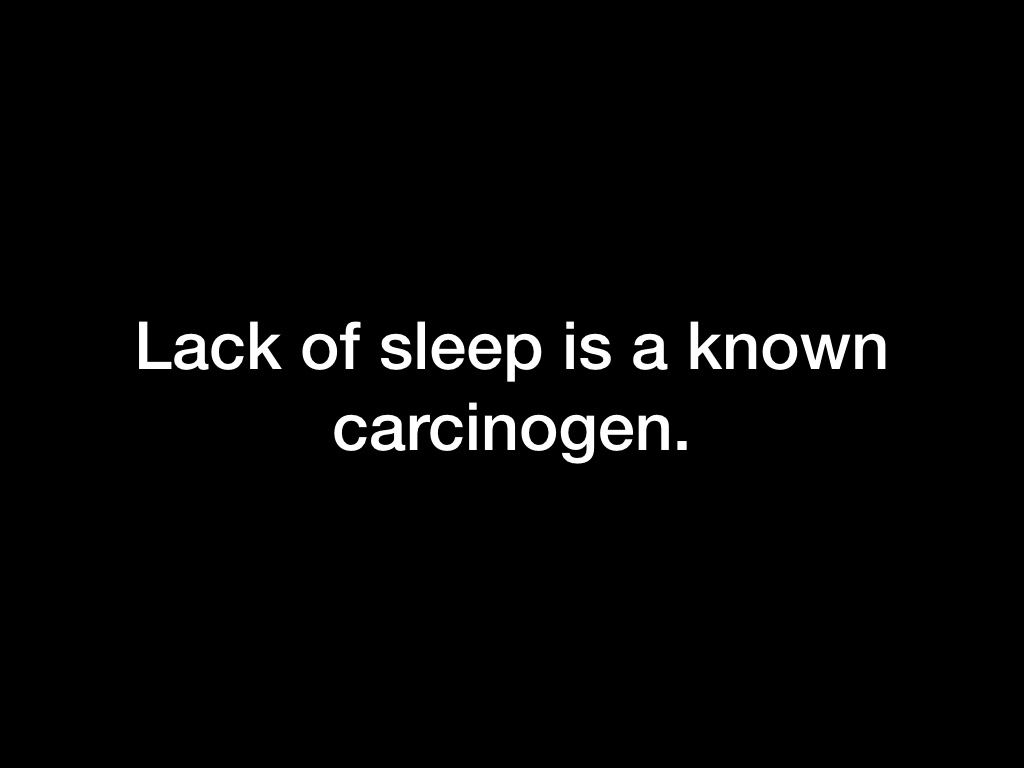
Among research cited in the book, you will find ones that show:
A 40% increase cancer risk in those sleeping 6 hours or less compared to 7 hrs or more1
That a society which transitioned form socially ingrained support for afternoon naps (for which we are biologically wired) to a social expectation of staying awake and working through the afternoon hours caused a 60% increase in mortality risk among male working populations.2
The WHO has classified nighttime shift work as a probable carcinogen3
__________________________
1: “A large European study of almost 25,000 individuals demonstrated that sleeping six hours or less was associated with a 40 percent increased risk of developing cancer, relative to those sleeping seven hours a night or more.”
Walker, Matthew. Why We Sleep: Unlocking the Power of Sleep and Dreams (pp. 184-185). Scribner. Kindle Edition.
2: “However, those that abandoned regular siestas went on to suffer a 37 percent increased risk of death from heart disease across the six-year period, relative to those who maintained regular daytime naps. The effect was especially strong in workingmen, where the ensuing mortality risk of not napping increased by well over 60 percent.
Walker, Matthew. Why We Sleep: Unlocking the Power of Sleep and Dreams (p. 71). Scribner. Kindle Edition.
3: “That may sound alarmist, but the scientific evidence linking sleep disruption and cancer is now so damning that the World Health Organization has officially classified nighttime shift work as a “probable carcinogen.””
Walker, Matthew. Why We Sleep: Unlocking the Power of Sleep and Dreams (p. 186). Scribner. Kindle Edition.
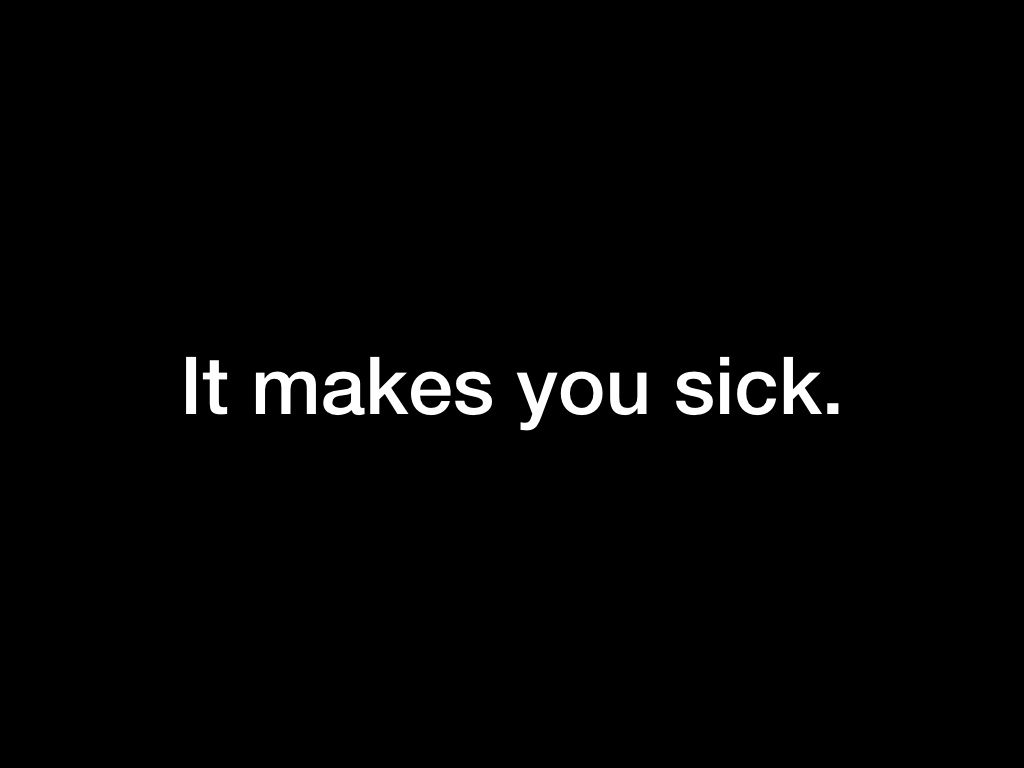
Infection rate of common cold was 2.5x in people who slept 5 hrs versus 7 (jumping to 50% vs 18%)1
__________________________
1: “There was a clear, linear relationship with infection rate. The less sleep an individual was getting in the week before facing the active common cold virus, the more likely it was that they would be infected and catch a cold. In those sleeping five hours on average, the infection rate was almost 50 percent. In those sleeping seven hours or more a night in the week prior, the infection rate was just 18 percent.”
Walker, Matthew. Why We Sleep: Unlocking the Power of Sleep and Dreams (p. 182). Scribner. Kindle Edition.
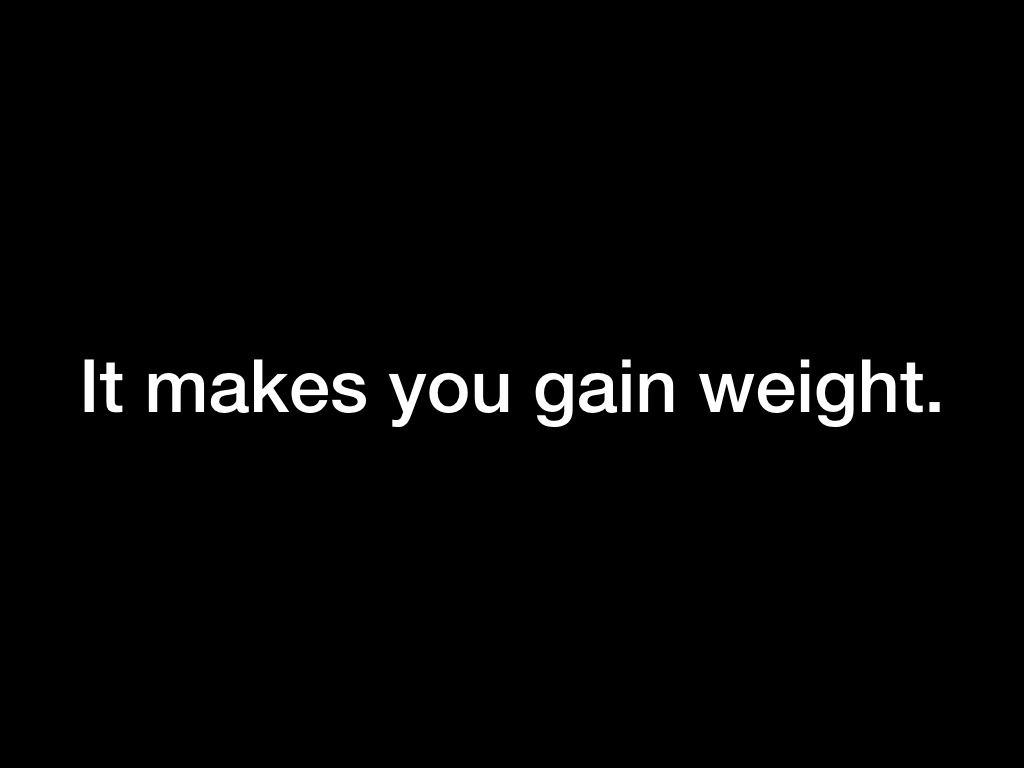
Lack of sleep will spike endocannabinoids in your brain, giving you the munchies and making you susceptible to weight gain.1, 2, 3
__________________________
1: “The less you sleep, the more you are likely to eat. In addition, your body becomes unable to manage those calories effectively, especially the concentrations of sugar in your blood. In these two ways, sleeping less than seven or eight hours a night will increase your probability of gaining weight, being overweight, or being obese, and significantly increases your likelihood of developing type 2 diabetes.”
Walker, Matthew. Why We Sleep: Unlocking the Power of Sleep and Dreams (p. 169). Scribner. Kindle Edition.
2: “When your sleep becomes short, you will gain weight. Multiple forces conspire to expand your waistline. The first concerns two hormones controlling appetite: leptin and ghrelin.II Leptin signals a sense of feeling full. When circulating levels of leptin are high, your appetite is blunted and you don’t feel like eating. Ghrelin, in contrast, triggers a strong sensation of hunger. When ghrelin levels increase, so, too, does your desire to eat. An imbalance of either one of these hormones can trigger increased eating and thus body weight. Perturb both in the wrong direction, and weight gain is more than probable.”
Walker, Matthew. Why We Sleep: Unlocking the Power of Sleep and Dreams (pp. 171-172). Scribner. Kindle Edition.
3: “Of relevance to this behavior is a recent discovery that sleep loss increases levels of circulating endocannabinoids, which, as you may have guessed from the name, are chemicals produced by the body that are very similar to the drug cannabis. Like marijuana use, these chemicals stimulate appetite and increase your desire to snack, otherwise known as having the munchies.Combine this increase in endocannabinoids with alterations in leptin and ghrelin caused by sleep deprivation and you have a potent brew of chemical messages all driving you in one direction: overeating.”
Walker, Matthew. Why We Sleep: Unlocking the Power of Sleep and Dreams (p. 174-175). Scribner. Kindle Edition.
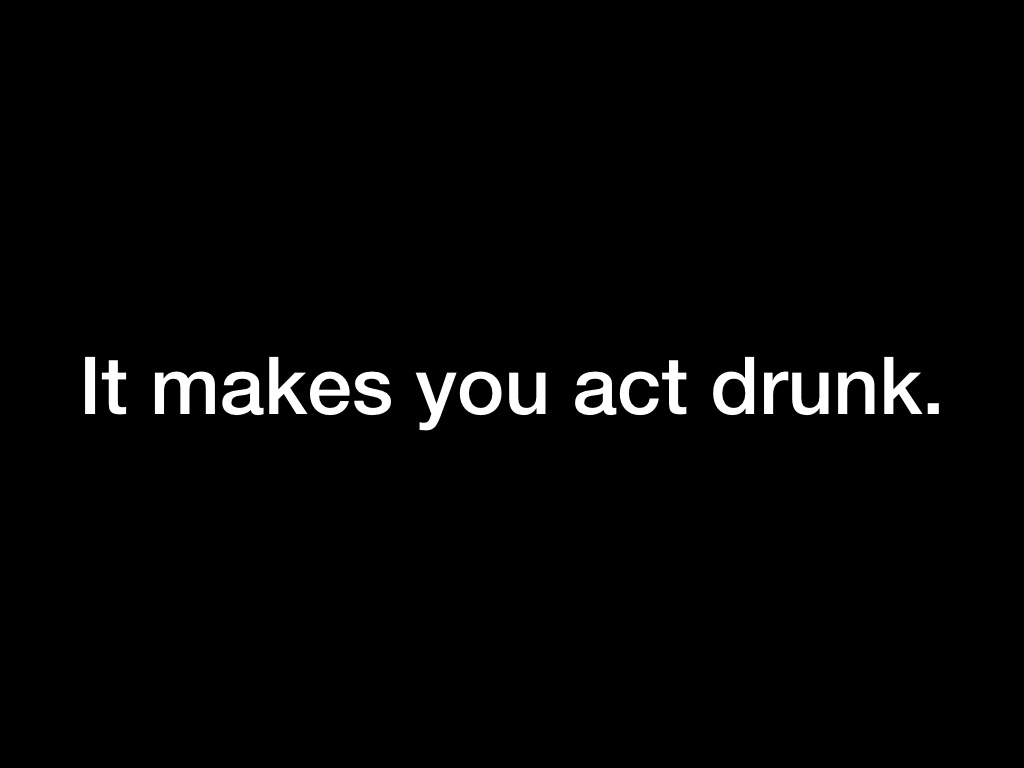
Lack of sleep can give you the cognitive performance of someone who is legally intoxicated.1
__________________________
1: “After being awake for nineteen hours, people who were sleep-deprived were as cognitively impaired as those who were legally drunk. Said another way, if you wake up at seven a.m. and remain awake throughout the day, then go out socializing with friends until late that evening, yet drink no alcohol whatsoever, by the time you are driving home at two a.m. you are as cognitively impaired in your ability to attend to the road and what is around you as a legally drunk driver. In fact, participants in the above study started their nosedive in performance after just fifteen hours of being awake (ten p.m. in the above scenario).
Walker, Matthew. Why We Sleep: Unlocking the Power of Sleep and Dreams (p. 138). Scribner. Kindle Edition.
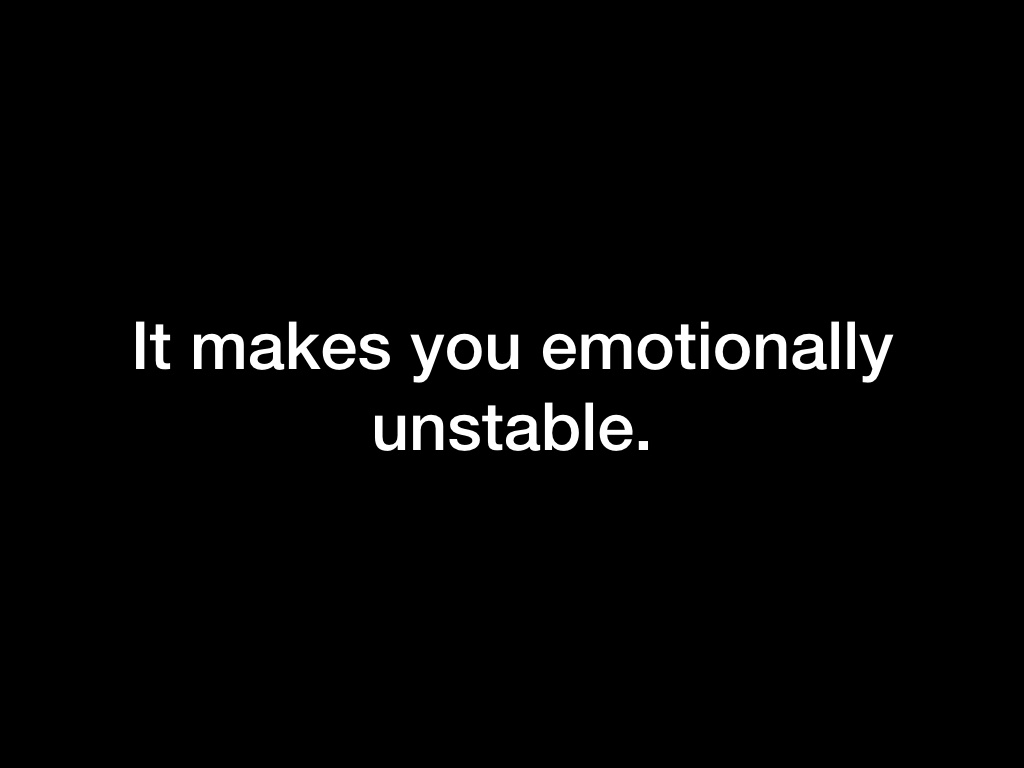
Removing REM sleep removes the ability to read the social world accurately and results in up to a 60% increase in amygdala activity when showed emotionally charged images compared to a much more measured response to such images when well rested1, 2
__________________________
1: “With the absence of such emotional acuity, normally gifted by the re-tuning skills of REM sleep at night, the sleep-deprived participants slipped into a default of fear bias, believing even gentle- or somewhat friendly looking faces were menacing. The outside world had become a more threatening and aversive place when the brain lacked REM sleep—untruthfully so. Reality and perceived reality were no longer the same in the “eyes” of the sleepless brain. By removing REM sleep, we had, quite literally, removed participants’ levelheaded ability to read the social world around them.”
Walker, Matthew. Why We Sleep: Unlocking the Power of Sleep and Dreams (pp. 216-217). Scribner. Kindle Edition.
2: “Analysis of the brain scans revealed the largest effects I have measured in my research to date. A structure located in the left and right sides of the brain, called the amygdala—a key hot spot for triggering strong emotions such as anger and rage, and linked to the fight-or-flight response—showed well over a 60 percent amplification in emotional reactivity in the participants who were sleep-deprived. In contrast, the brain scans of those individuals who were given a full night’s sleep evinced a controlled, modest degree of reactivity in the amygdala, despite viewing the very same images. It was as though, without sleep, our brain reverts to a primitive pattern of uncontrolled reactivity. We produce unmetered, inappropriate emotional reactions, and are unable to place events into a broader or considered context.”
Walker, Matthew. Why We Sleep: Unlocking the Power of Sleep and Dreams (pp. 146-147). Scribner. Kindle Edition.
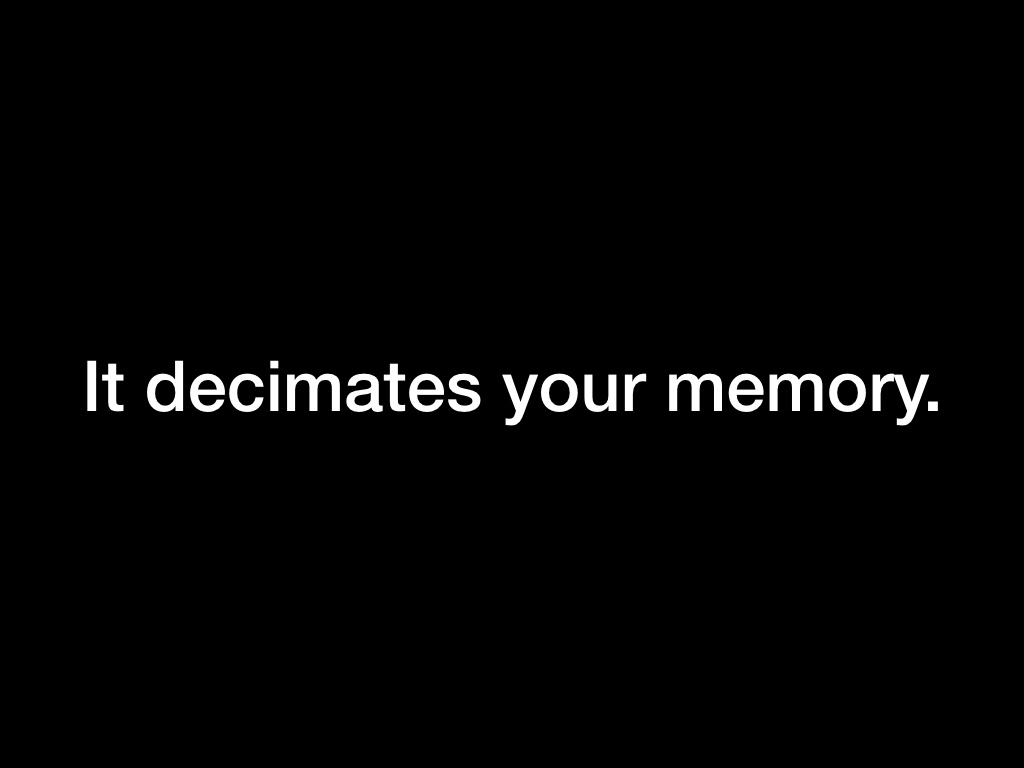
There is a 20-40% memory retention benefit offered by sleep1
__________________________
1: “The experimental results of Jenkins and Dallenbach have now been replicated time and again, with a memory retention benefit of between 20 and 40 percent being offered by sleep, compared to the same amount of time awake.”
Walker, Matthew. Why We Sleep: Unlocking the Power of Sleep and Dreams (p. 113). Scribner. Kindle Edition.

And unfortunately with sleep, “pretty good” doesn’t seem to be “good enough”. If you’re now thinking in your head, “Yikes! But luckily I get most of a night’s sleep so I should be good” you are not spared. Even small amounts of sleep reduction can show significant negative effects.
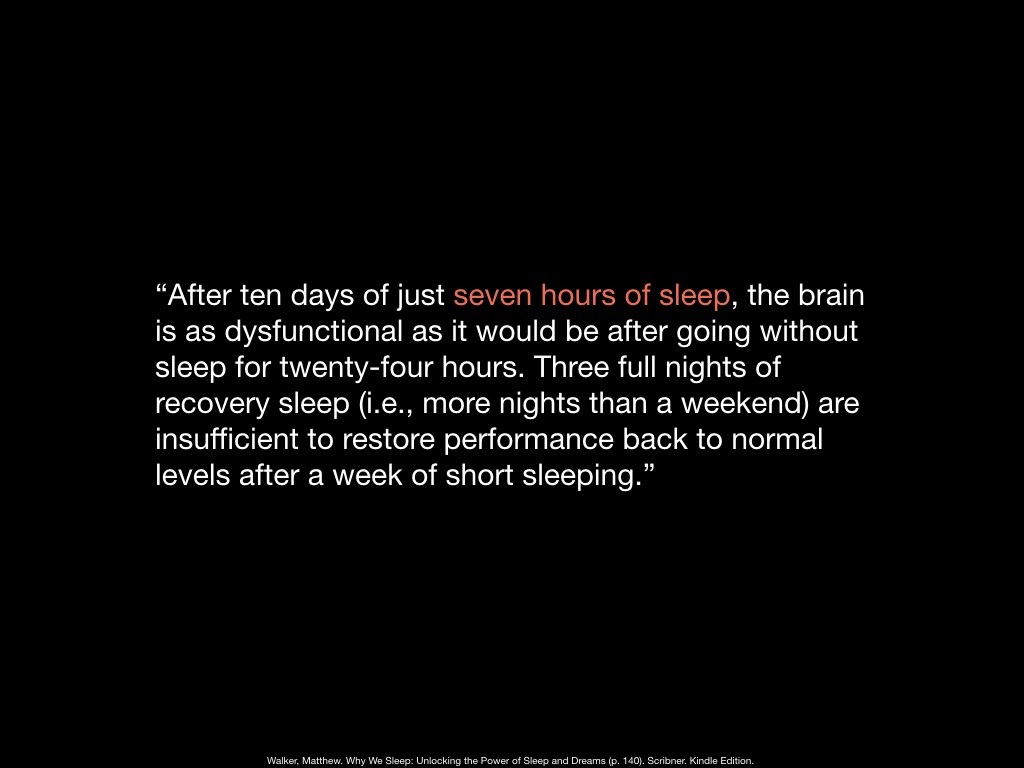
It turns out that sleeping just 7hrs a day for less than two weeks decreases your performance to levels you’d see after an all nighter. Further, a weekend’s worth of sleep is not enough to correct the effect.1
Also if you’re now thinking “I sleep 7 hrs daily and I’m not acting impaired, there’s no way this is true”, that’s probably due to the additional fact that the same research showed us that “the human mind cannot accurately sense how sleep deprived it is when it is sleep-deprived”2
__________________________
1: Quote on slide. Walker, Matthew. Why We Sleep: Unlocking the Power of Sleep and Dreams (p. 140). Scribner. Kindle Edition.
2: “Finally, the human mind cannot accurately sense how sleep-deprived it is when sleep-deprived.”
Walker, Matthew. Why We Sleep: Unlocking the Power of Sleep and Dreams (p. 140). Scribner. Kindle Edition.

Now many of us know intuitively that sleep is good for us, and yet we still ignore it. Athletes and coaches have also known the importance of sleep for a long time, but like us, they sometimes take it for granted. Golden State Warriors’ Andre Igoudala learned the hard way how much it was hurting his potential over the last few years.
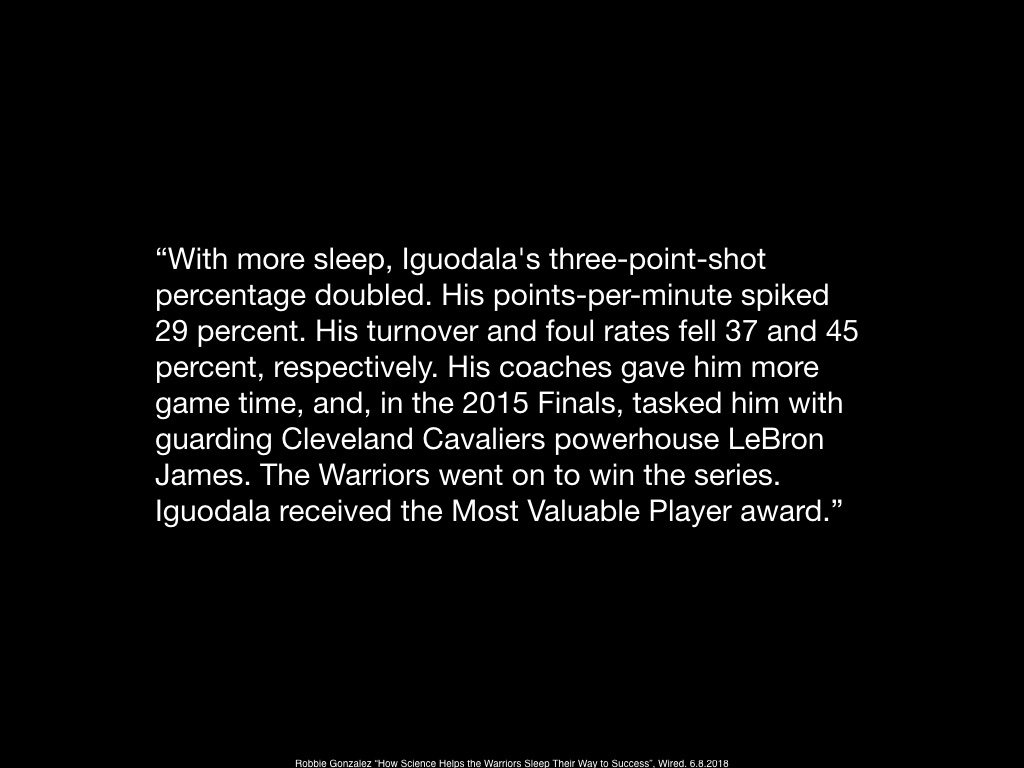
In an article written by Robbie Gonzalez about Iggy’s process of working with a sleep advisor to improve the quality of his sleep hygiene, we got this remarkable paragraph.
__________________________
Quote citation: Robbie Gonzalez “How Science Helps the Warriors Sleep Their Way to Success”, Wired. 6.8.2018

Which points out a series of astonishing improvements. His 3 point shot percentage doubled.
__________________________
Quote citation: Robbie Gonzalez “How Science Helps the Warriors Sleep Their Way to Success”, Wired. 6.8.2018
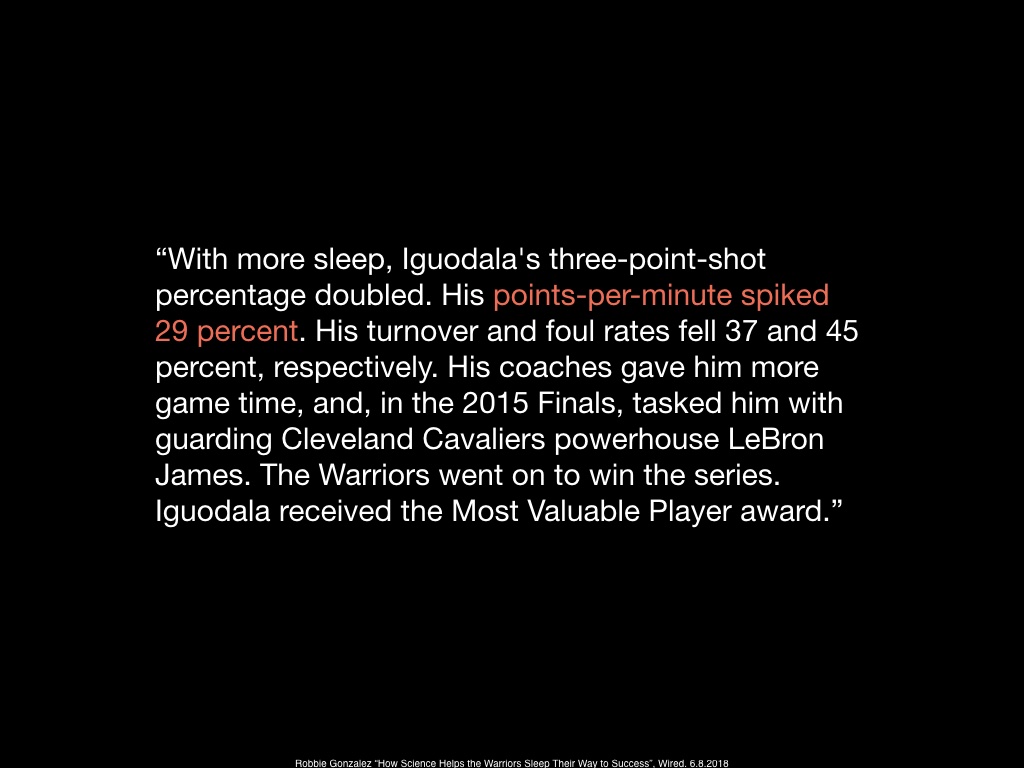
His points per minute spiked
__________________________
Quote citation: Robbie Gonzalez “How Science Helps the Warriors Sleep Their Way to Success”, Wired. 6.8.2018

Turnover and foul rates fell dramatically
__________________________
Quote citation: Robbie Gonzalez “How Science Helps the Warriors Sleep Their Way to Success”, Wired. 6.8.2018
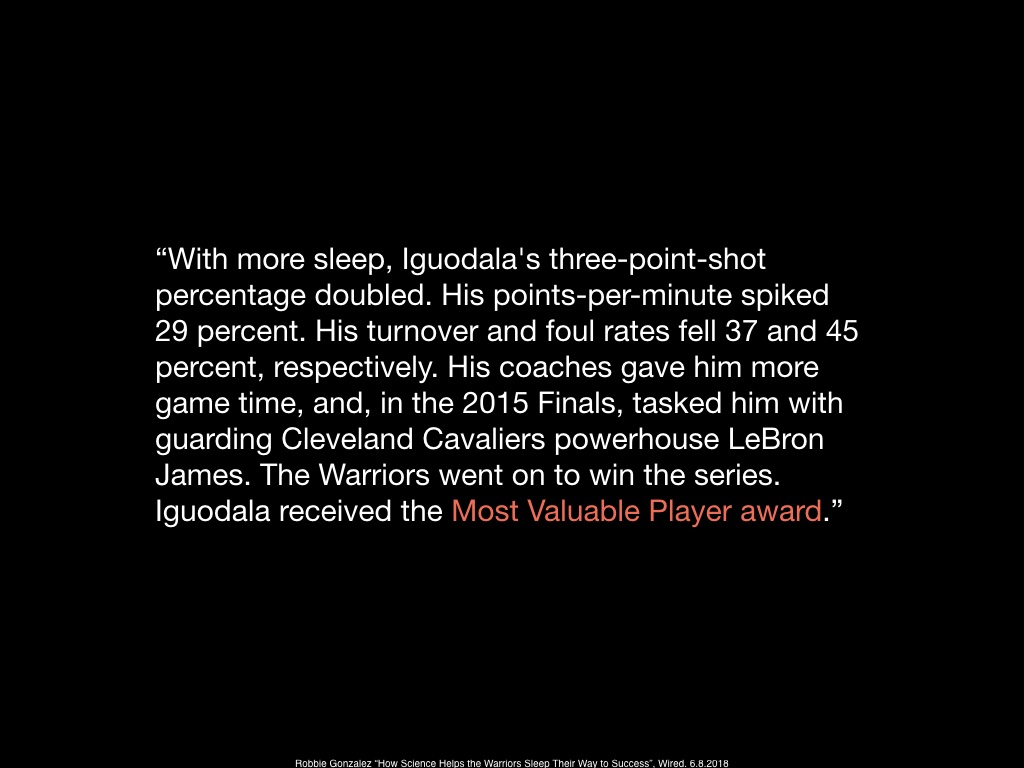
And best of all, he was given key responsibilities on the team, like guarding one of the best basketball players alive, that led him to being voted the MVP of the 2015 Finals.
All of this is particularly astonishing because Iggy was already a pro basketball player. At that level of accomplishment, it is usually difficult to make such huge improvements. And it should be a wakeup call for knowledge workers like us about how much potential we might be leaving on the table when we don’t prioritize our sleep.
__________________________
Quote citation: Robbie Gonzalez “How Science Helps the Warriors Sleep Their Way to Success”, Wired. 6.8.2018

So to recap, we know that being disrupted at work is bad, and giving up sleep or free time to try to recover it is even worse. What do we do then?
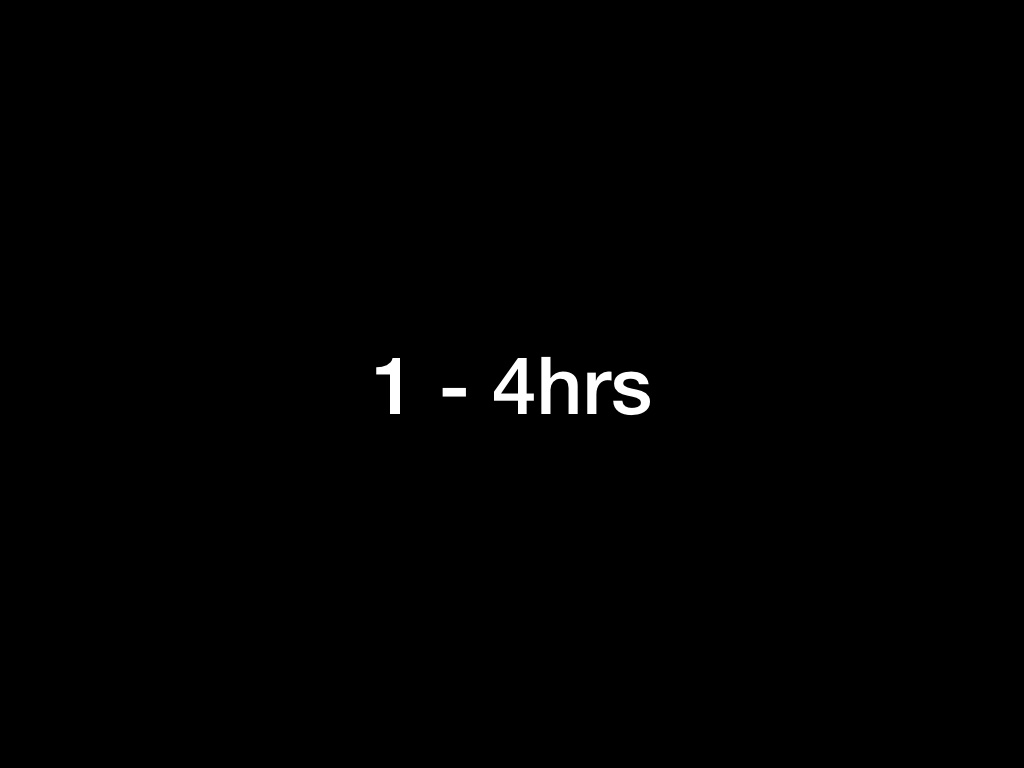
Well remember, most people can’t spend any more than 4 hrs a day in a state of deep practice or focus.

The standard workday is 8hrs long.
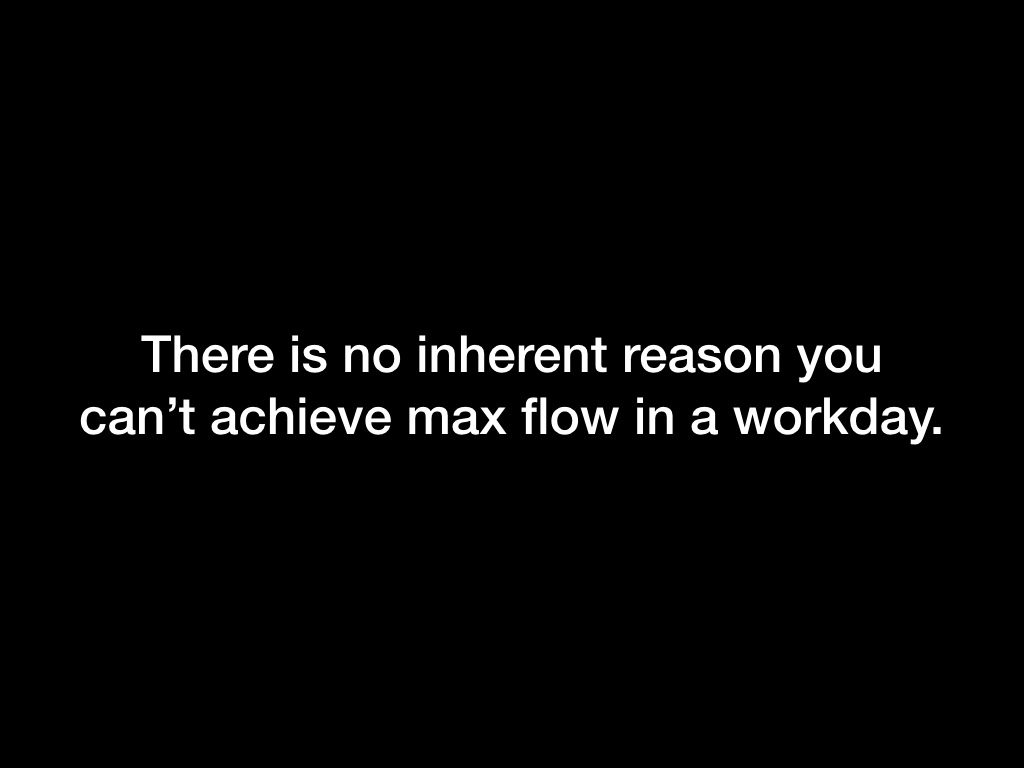
Thus, there isn’t any inherent reason we can’t achieve our allocation of deep work in a standard work day without dipping into free time and sleep.

The key is making sure that shallow work doesn’t eat up the up to 4hrs you should be spending in deep work.

So let me offer a few tips I’ve pulled together from the various studies I’ve been citing.

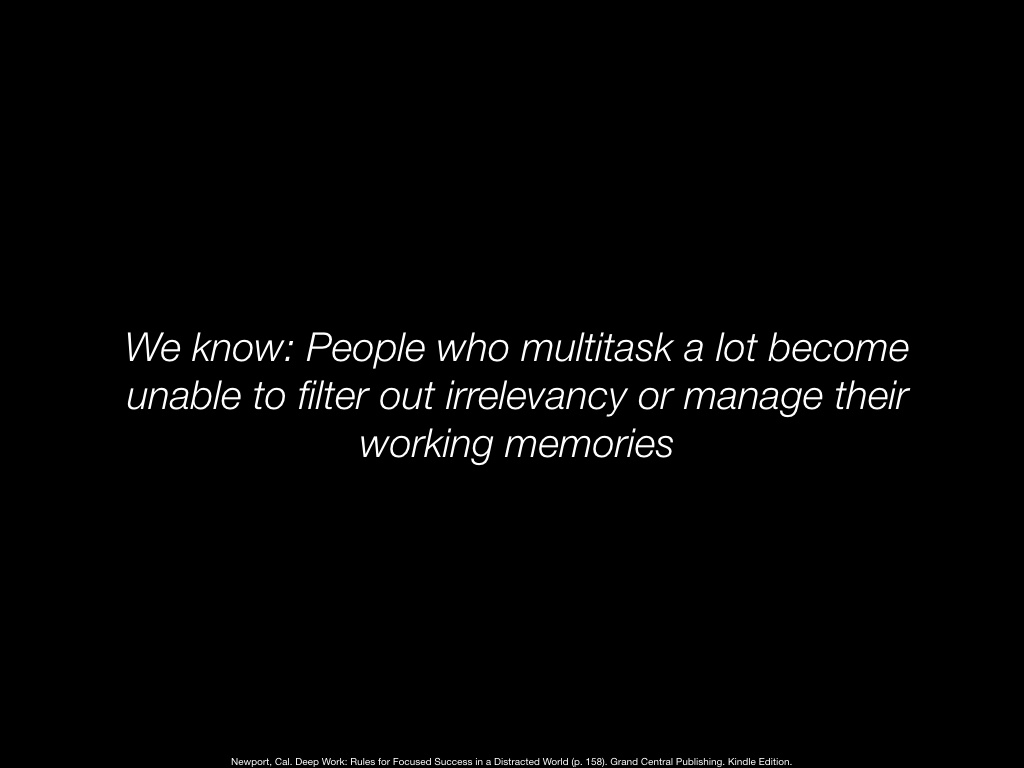
This tidbit is actually one I haven’t yet introduced in this talk, but it comes from an interview with Clifford Nass, a Stanford professor who studied digital behavior, where he summarized his body of research by explaining that people who attempt to constantly multitask cause physical changes in their brain that keep them from optimal performance.
__________________________
“We can find evidence for this claim in the research of Clifford Nass, the late Stanford communications professor who was well known for his study of behavior in the digital age. Among other insights, Nass’s research revealed that constant attention switching online has a lasting negative effect on your brain. Here’s Nass summarizing these findings in a 2010 interview with NPR’s Ira Flatow:
So we have scales that allow us to divide up people into people who multitask all the time and people who rarely do, and the differences are remarkable. People who multitask all the time can’t filter out irrelevancy. They can’t manage a working memory. They’re chronically distracted. They initiate much larger parts of their brain that are irrelevant to the task at hand… they’re pretty much mental wrecks.
At this point Flatow asks Nass whether the chronically distracted recognize this rewiring of their brain:
The people we talk with continually said, “look, when I really have to concentrate, I turn off everything and I am laser-focused.” And unfortunately, they’ve developed habits of mind that make it impossible for them to be laser-focused. They’re suckers for irrelevancy. They just can’t keep on task. [emphasis mine]
Once your brain has become accustomed to on-demand distraction, Nass discovered, it’s hard to shake the addiction even when you want to concentrate.”
Quote Citation: Newport, Cal. Deep Work: Rules for Focused Success in a Distracted World (pp. 158-159). Grand Central Publishing. Kindle Edition.
Link to original transcript: https://www.npr.org/2013/05/10/182861382/the-myth-of-multitasking
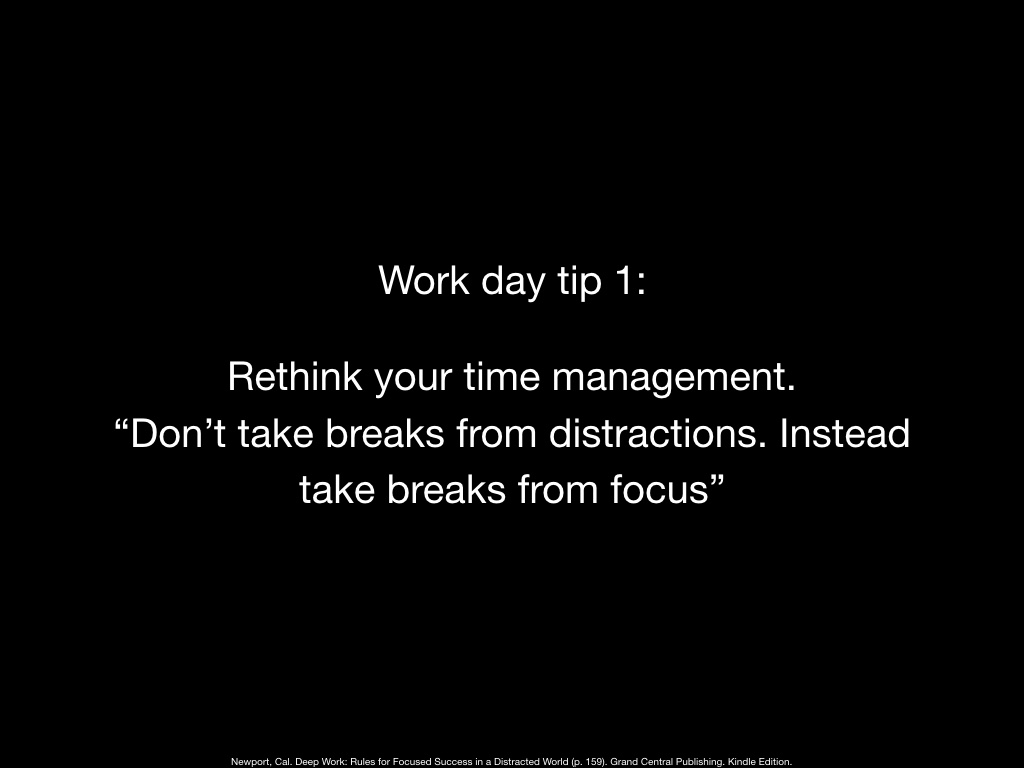
One way to get around the harm done to your brain by trying to multitask all the time is to start scheduling your distractions time instead of scheduling your time away from distractions. Let your default state become focused time and schedule your next distraction break in advance (i.e. decide you’ll work for an hour and then check your phone). The bonus here is that the time you spend resisting checking your phone before the hour is up acts like mental calisthenics for your brain, building your ability to resist and focus.
________________________
Slide quote: Newport, Cal. Deep Work: Rules for Focused Success in a Distracted World (p. 159). Grand Central Publishing. Kindle Edition.

We established earlier in this talk that thee ability to concentrate and do deep work is one that must be trained.
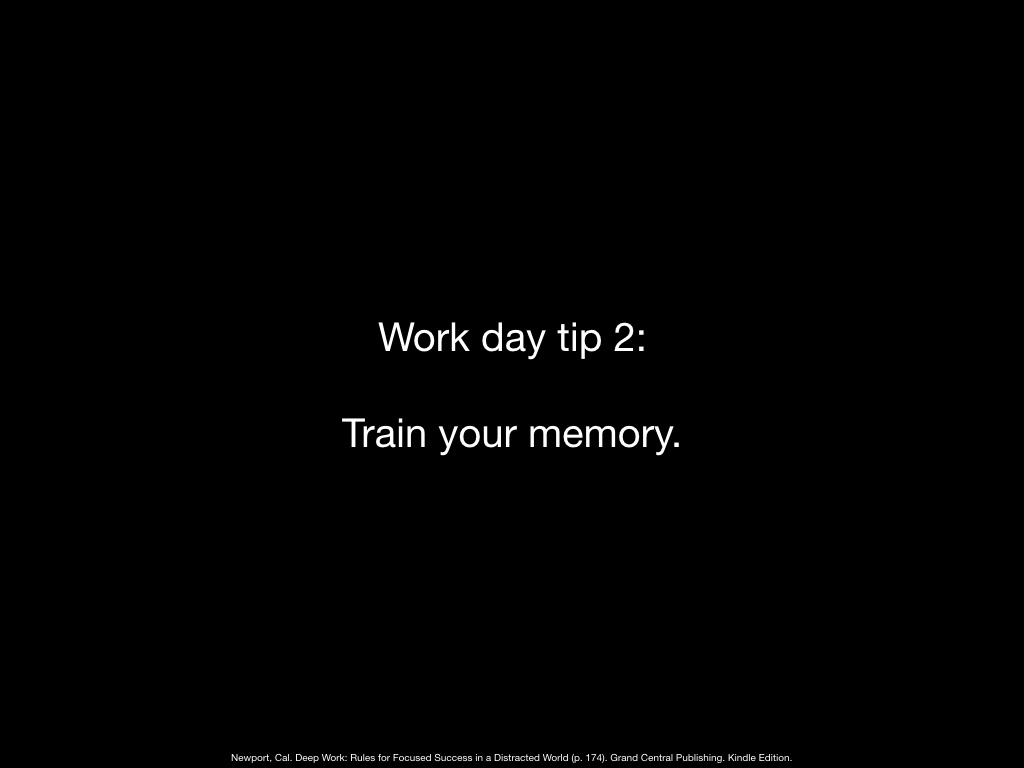
When studying memory athletes, researchers found that the key difference between them and ordinary people was that they had a heightened ability to concentrate. Thus, if we want to become better at concentrating, one way we can likely boost our abilities in this area is by training in the same ways as memory athletes. The author Cal Newport suggests starting with the common memory feat of learning to memorize an entire deck of cards.
______________________
“We found that one of the biggest differences between memory athletes and the rest of us is a in a cognitive ability that’s not a direct measure of memory but of attention” … “A side effect of memory training in other words is an improvement in your general ability to concentrate”
Citation: Newport, Cal. Deep Work: Rules for Focused Success in a Distracted World (p. 174). Grand Central Publishing. Kindle Edition.

Citation: Gloria Mark, Professor in the Department of Informatics at the University of California, Irvine in an interview with FastCompany 7.28.08

Thus it stands to reason that blocking like tasks together will minimize the number of times we switch spheres of work and thus should lesson the impact of attention residue on our performance and time to complete tasks.
Specifically for this audience, “browsing twitter” is not a like task to “coding”.
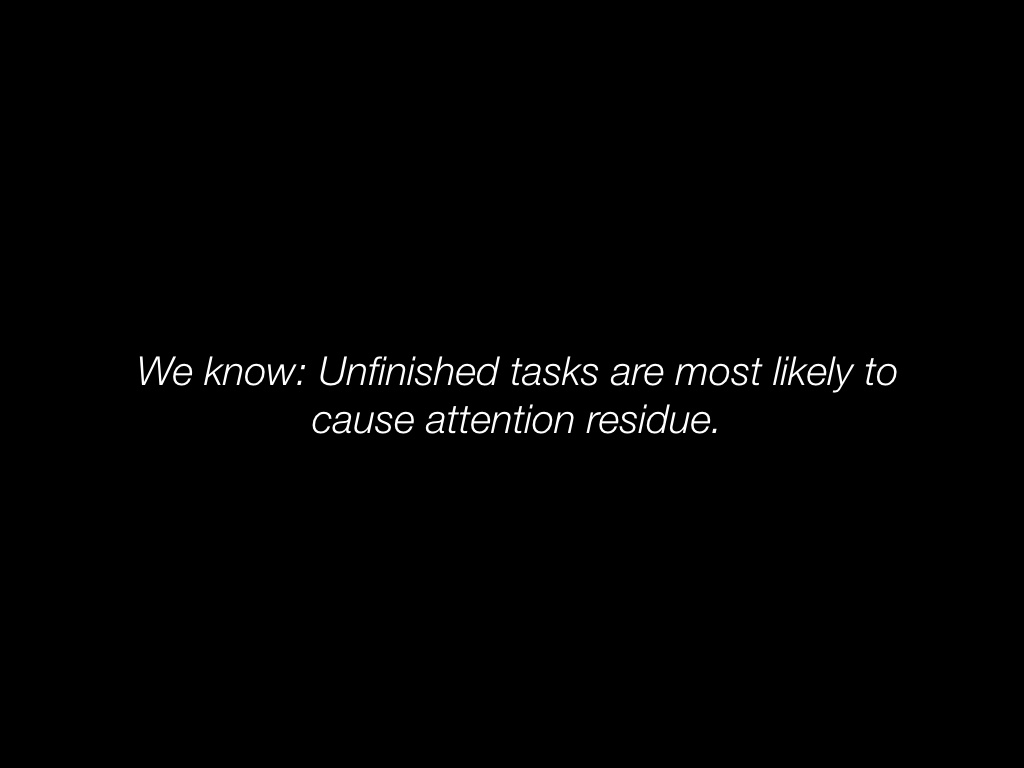
As we saw earlier, we know that unfinished tasks weigh heaviest on the brain in terms of attention residue
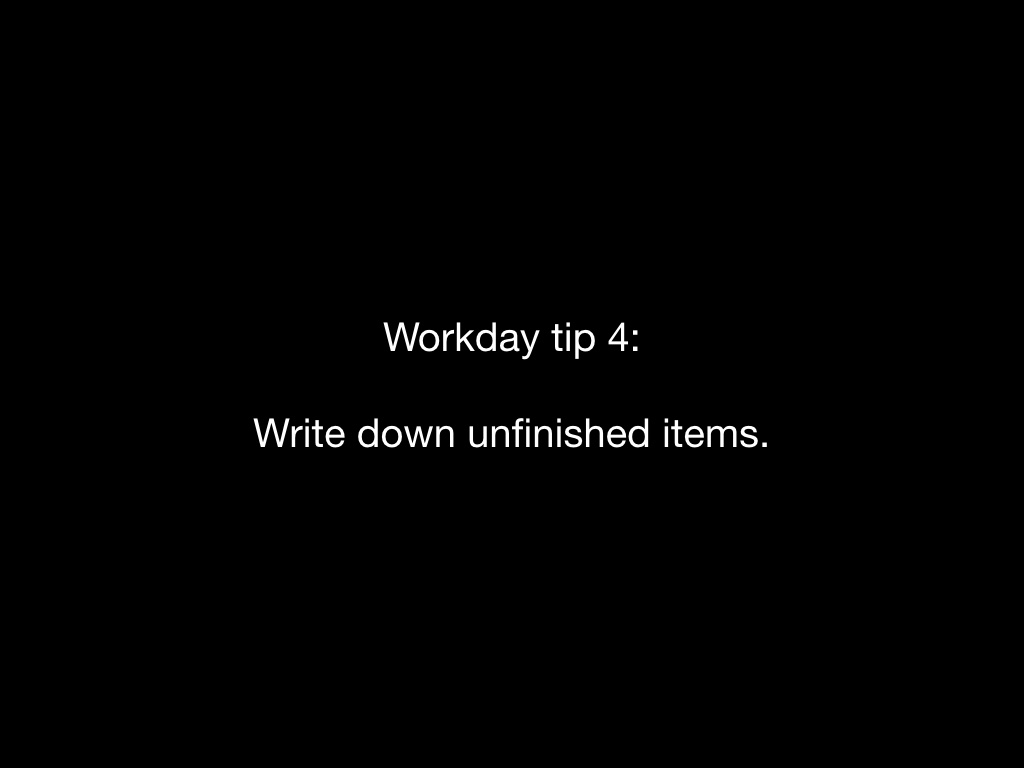
However, researchers “found that they could significantly reduce the effect’s impact by asking the subjects, soon after the interruption, to make a plan for how they would later complete the incomplete task.” It appears that attention residue can be at least partially mitigated by making a plan for completing a task at the time of interruption. Thus, we can employ this knowledge to our benefit by mitigating any inevitable interruptions in our workplace by writing down our own unfinished items before switching to the new task.
_________________________
Quote citation: Newport, Cal. Deep Work: Rules for Focused Success in a Distracted World (p. 153). Grand Central Publishing. Kindle Edition.
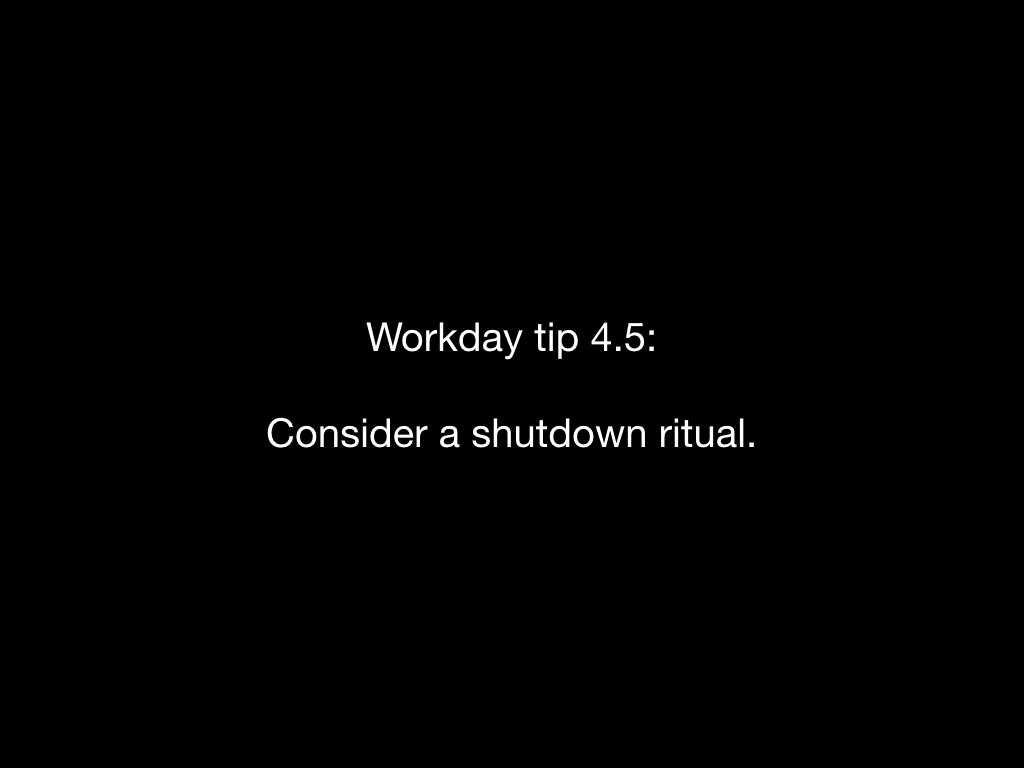
Further, this suggests that it might be beneficial to employ a shutdown ritual at the end of work each day to symbolically close out the day and allow your brain to transition into leisure mode. Doing so could allow us to reduce the attention residue of unfinished work tasks following us into our leisure time. Making this transition faster stands to benefit us by maximizing the amount of time at home where our brain is relaxed enough to replenish its attention centers, preparing us to pay attention the following day.

Earlier I cited one researcher who stated that many people give up long before they become experts at something, because the practice needed to become an expert is often unpleasant.
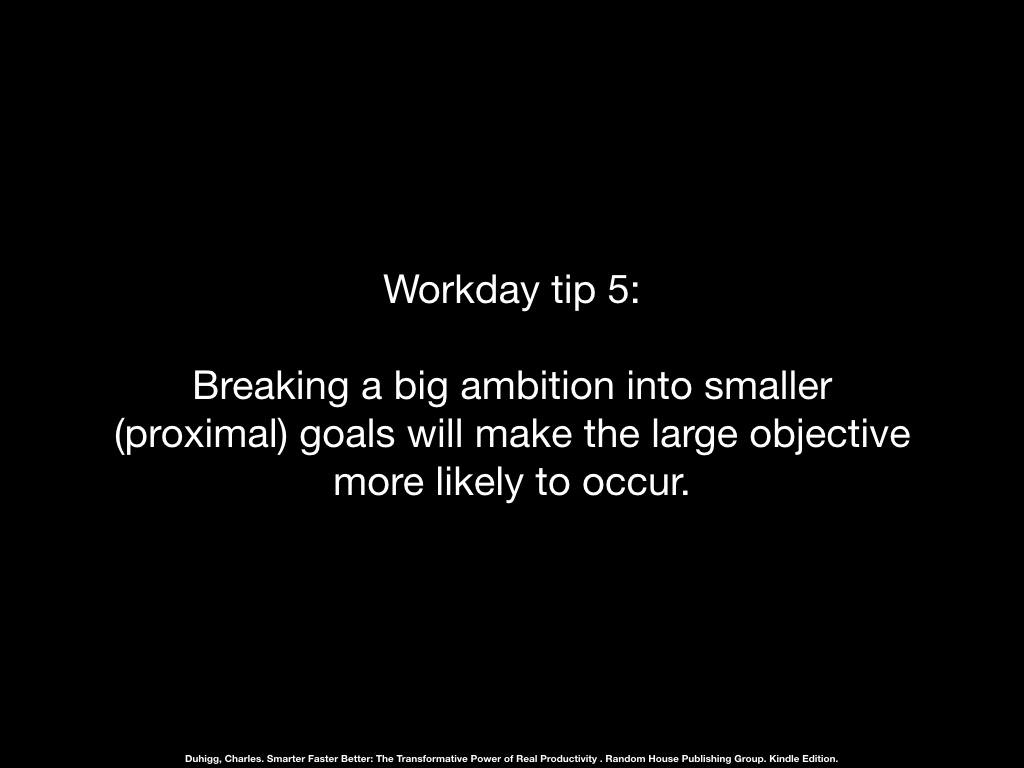
It turns out that one concrete way to help with this issue is by breaking our loftier goals into smaller pieces. By doing this, we make it more likely that we will actually achieve the larger objective.
__________________
Citation: Duhigg, Charles. Smarter Faster Better: The Transformative Power of Real Productivity . Random House Publishing Group. Kindle Edition.

Ok, and say you do all these things, and you increase flow at work and accomplish all your goals. You become an expert in your domain. What do you stand to gain?

Fame

GLORY

HONOR

Jk. You probably won’t get any of those. But all of those athletes shared something else: extreme happiness.
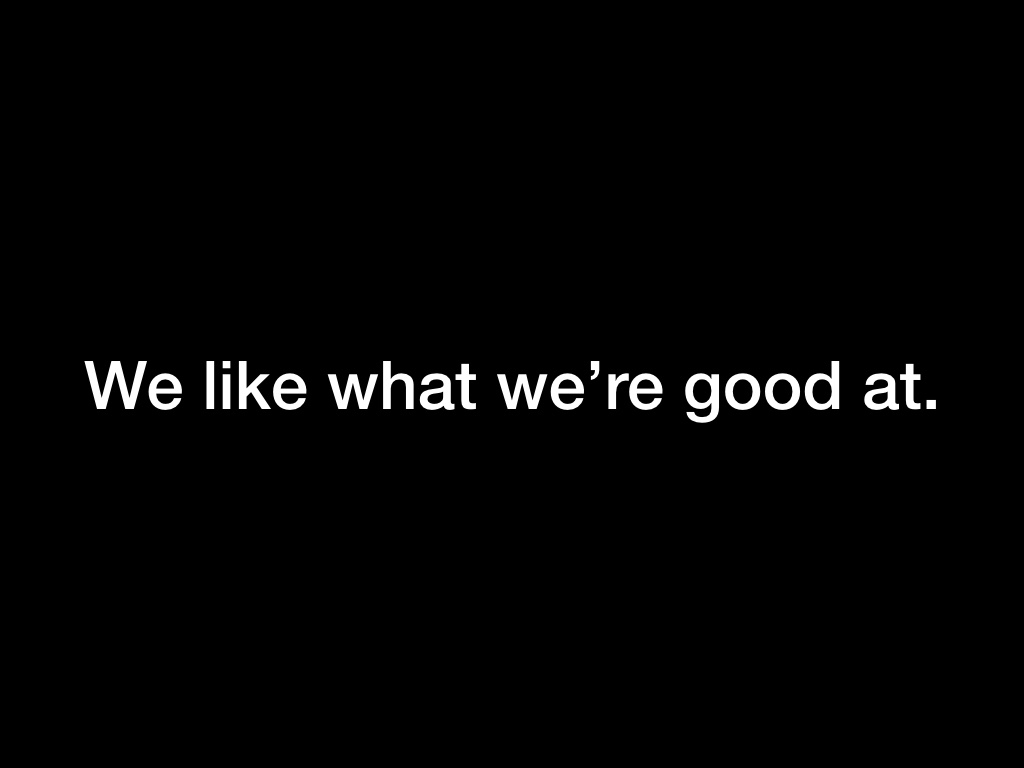
It turns out, we like what we’re good at. Most elite athletes say they love what they do. It’s tempting to say that they’re good because they love what they do, but there is some evidence that to the contrary they enjoy what they do because they’re good at it.
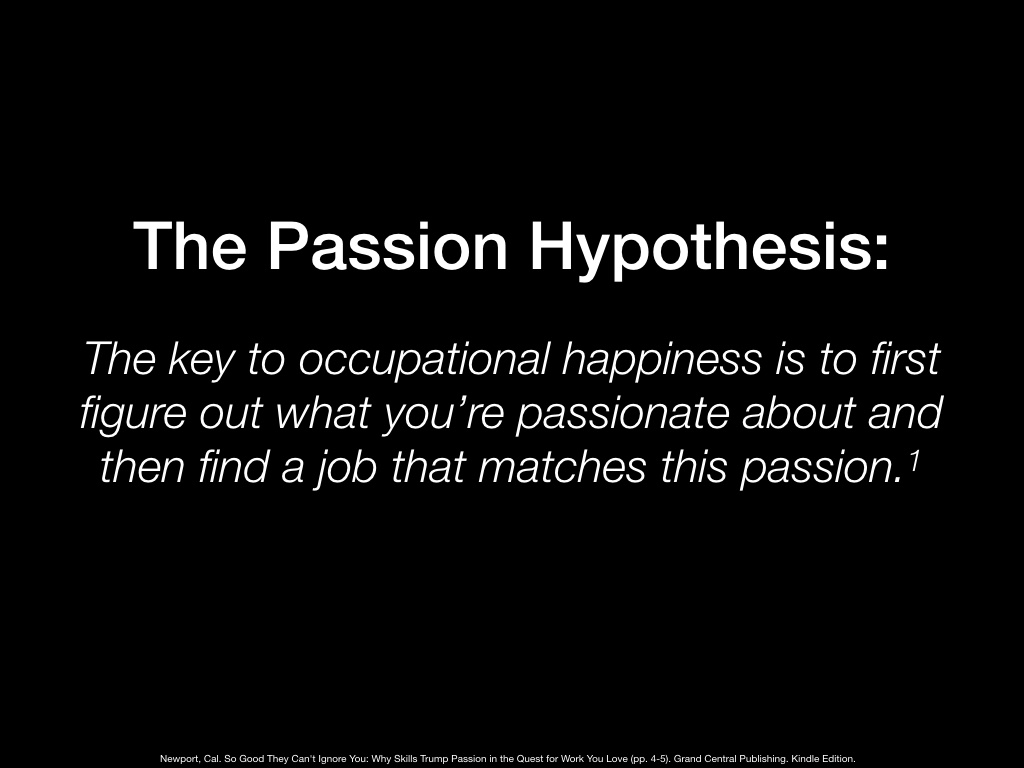
This flies in the face of conventional wisdom, which states that we all have some passions and if we’re not happy its because we haven’t yet uncovered the right job that unlocks these passions
_________________________
Quote citation: Newport, Cal. So Good They Can't Ignore You: Why Skills Trump Passion in the Quest for Work You Love (p. 4-5). Grand Central Publishing. Kindle Edition.
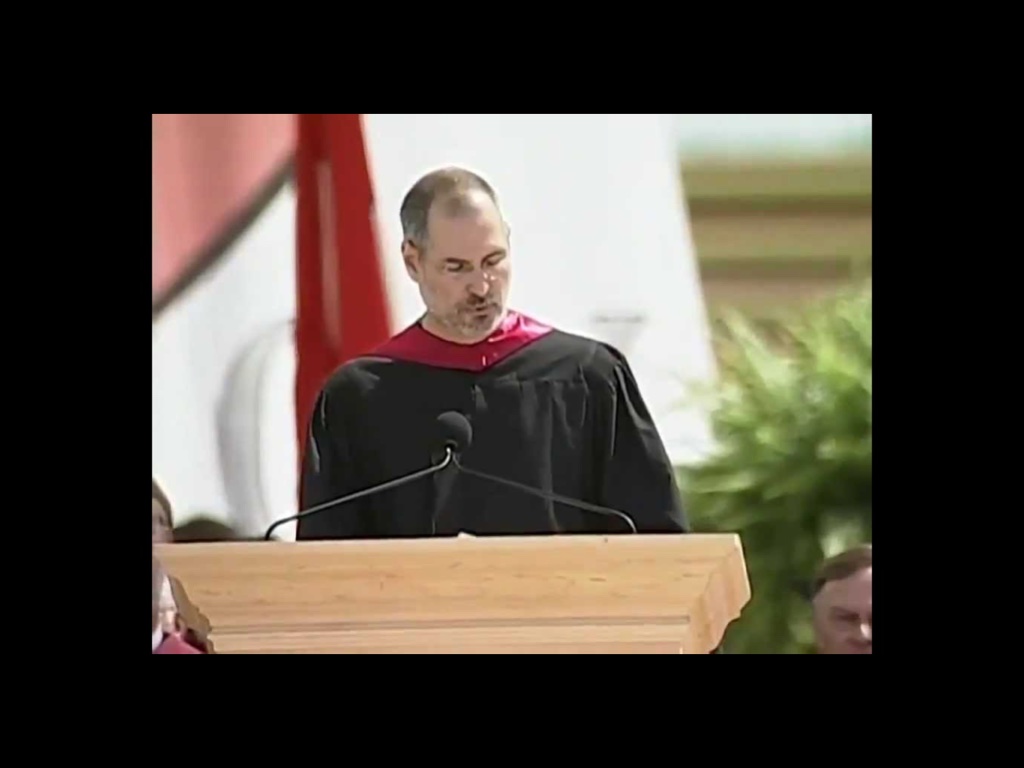
The passion hypothesis has many known proponents, not least of which was the viral Steve Jobs Stanford graduation commencement speech.
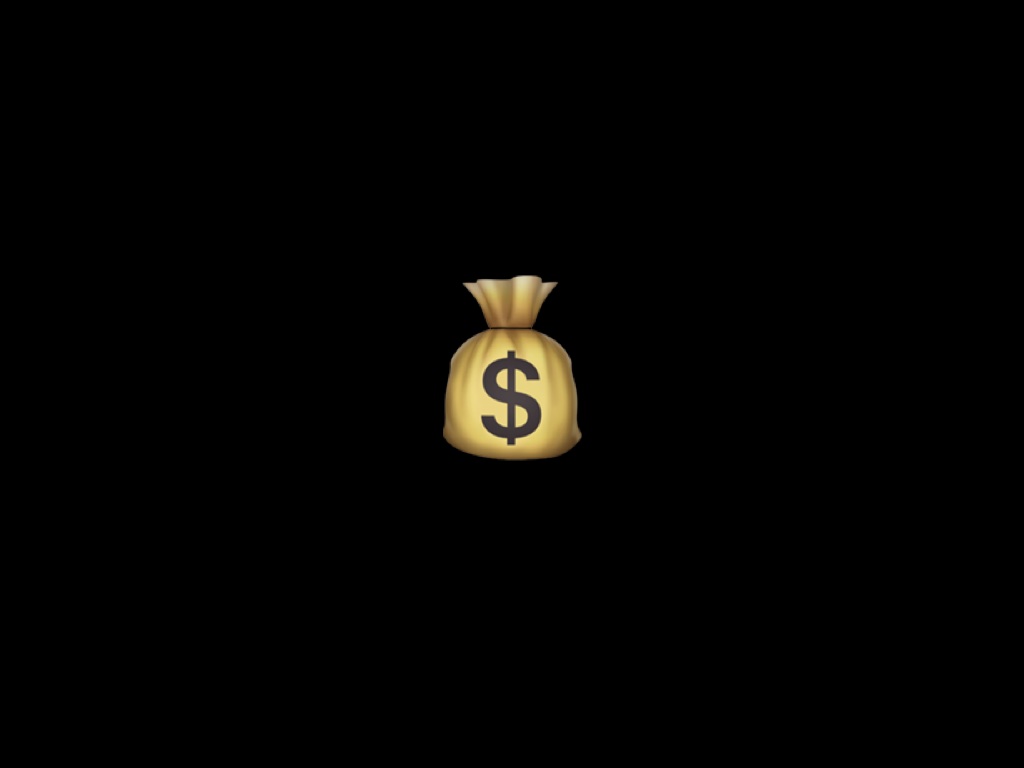
But Job’s own path to success, which is extensively documented, appears to have had nothing to do with passion and everything to do with wanting to turn a quick buck. He initially wanted money to fuel his lifestyle of mindfulness and retreats, and the scheme he devised happened to snowball him to fame and fortune.
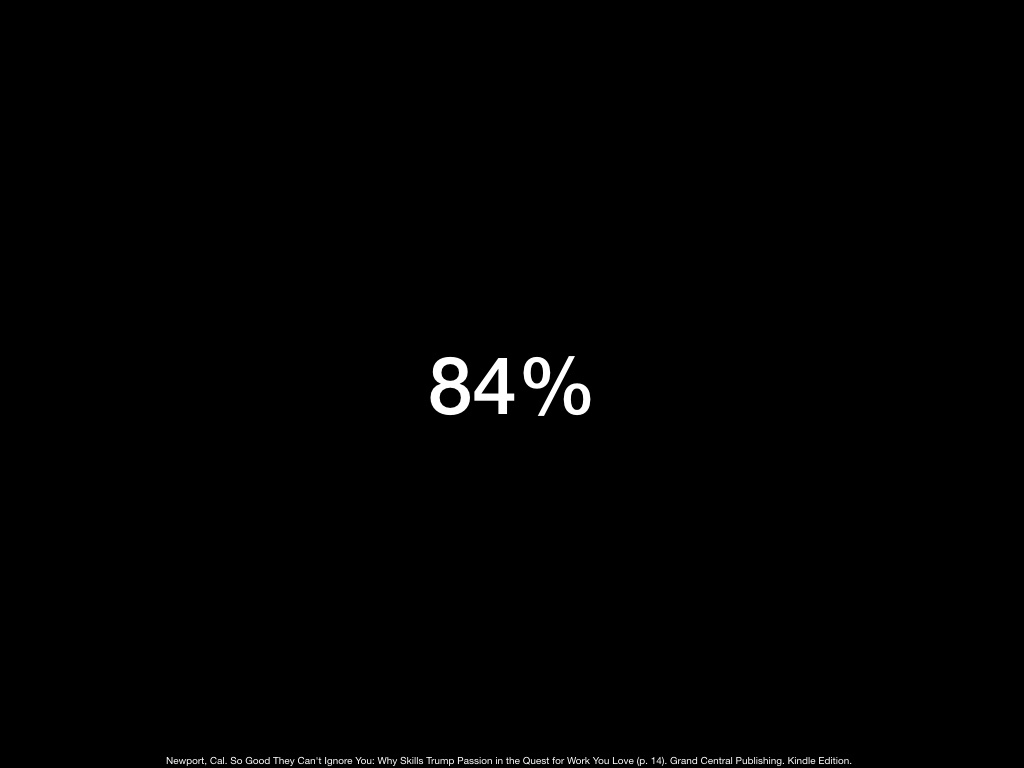
Further, the passion myth relies on the assumption that everyone has a work related passion just waiting to be discovered. But scientists in a 2002 study of university students found that only ~84% had any identifiable passion
_________________________
Quote citation: Newport, Cal. So Good They Can't Ignore You: Why Skills Trump Passion in the Quest for Work You Love (p. 14). Grand Central Publishing. Kindle Edition.
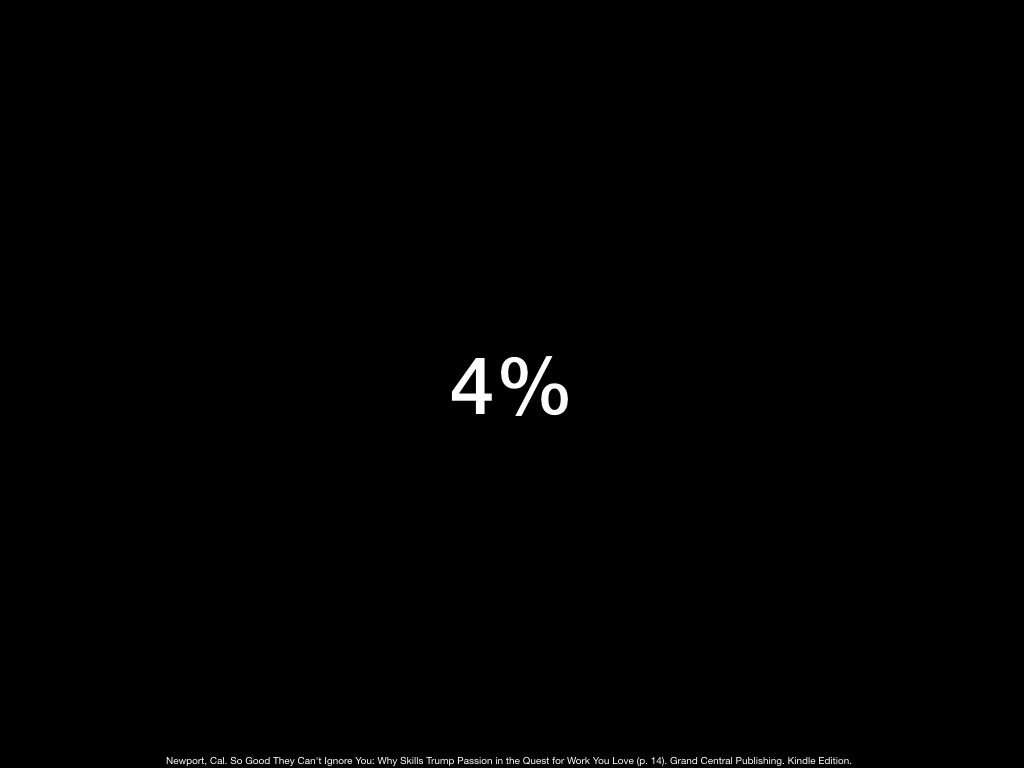
Of that 86% only 4% had a career related passion.
_________________________
Quote Citation: Newport, Cal. So Good They Can't Ignore You: Why Skills Trump Passion in the Quest for Work You Love (p. 14). Grand Central Publishing. Kindle Edition.
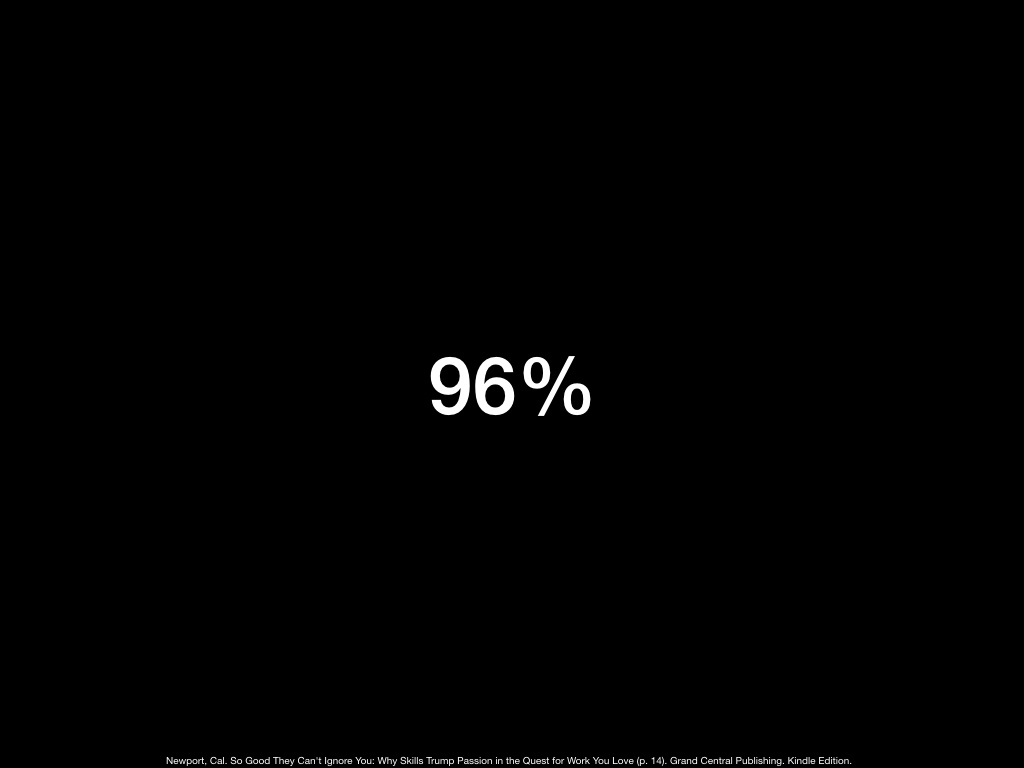
The other 96% had passions related to hobbies unlikely to be monetizable. This is a very scary statistic for anyone subscribing to the passion hypothesis for getting satisfaction from a job.
_________________________
Quote citation: Newport, Cal. So Good They Can't Ignore You: Why Skills Trump Passion in the Quest for Work You Love (p. 14). Grand Central Publishing. Kindle Edition.
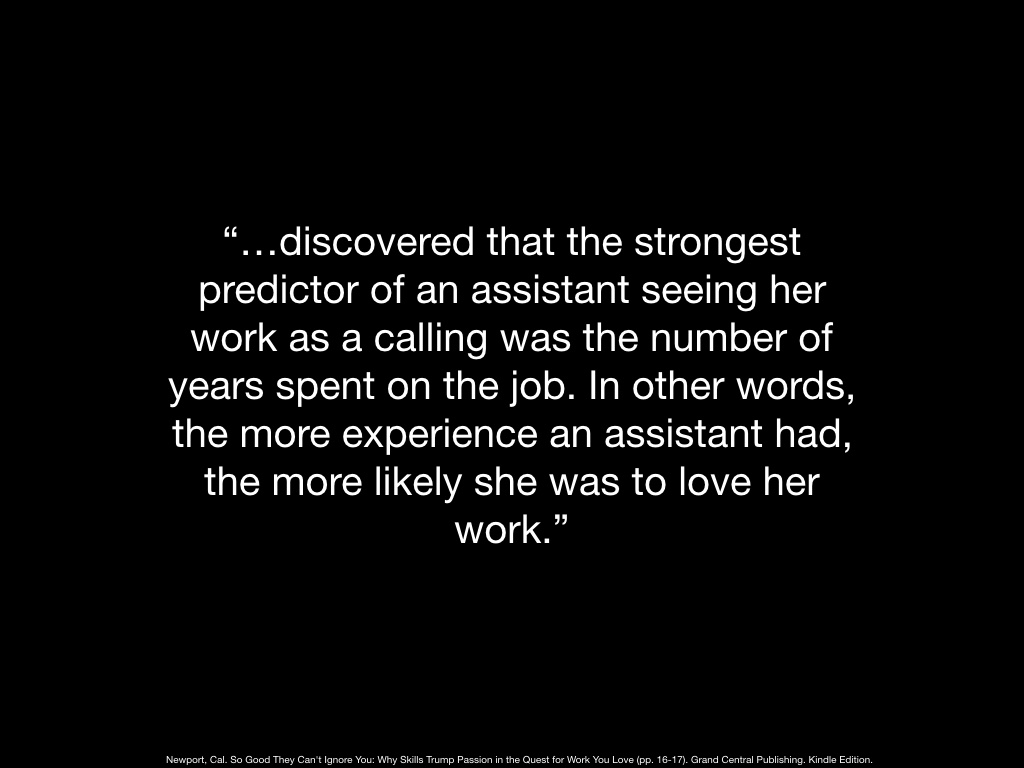
Luckily for the students surveyed who didn’t have work related passions, it turns out that a different researcher, Amy Wrzesniewski, found that the strongest predictor of whether someone saw their occupation as a job, a career, or a calling was the number of years spent in role, not whether they had a preexisting passion.
_________________________
Research from Amy Wrzesniewski, a professor of organizational behavior at Yale University, in the Journal of Research in Personality
Quote citation: Newport, Cal. So Good They Can't Ignore You: Why Skills Trump Passion in the Quest for Work You Love (p. 16-17). Grand Central Publishing. Kindle Edition.

My main goal here is not to be a downer about passion just for the sake of being a rebel. I, myself, have always identified as someone who is exceedingly passion driven.
The reason I point out that passion might not be the best way to conceptualize job satisfaction is that it seems to be actively harming the generations that came of age after it was popularized.

Being “My One True Passion” is a lot of pressure to put on a job, and indeed in a 2010 survey 64%1 of millennials expressed dissatisfaction with their jobs, with overall satisfaction in jobs decreasing every year since it started to get measured in 19872 (passion hypothesis popularized in the 1970s)
_________________________
Slide citation: Newport, Cal. So Good They Can't Ignore You: Why Skills Trump Passion in the Quest for Work You Love (p. 38). Grand Central Publishing. Kindle Edition.
1: “Among young people, the group perhaps most concerned with the role of work in their lives, 64 percent now say that they’re actively unhappy in their jobs. This is the highest level of dissatisfaction ever measured for any age group over the full two-decade history of the survey4. In other words, our generation-spanning experiment with passion-centric career planning can be deemed a failure: The more we focused on loving what we do, the less we ended up loving it.”
Newport, Cal. So Good They Can't Ignore You: Why Skills Trump Passion in the Quest for Work You Love (p. 23). Grand Central Publishing. Kindle Edition.
2: “The 2010 Conference Board survey of U.S. job satisfaction found that only 45 percent of Americans describe themselves as satisfied with their jobs. This number has been steadily decreasing from the mark of 61 percent recorded in 1987, the first year of the survey.”
Newport, Cal. So Good They Can't Ignore You: Why Skills Trump Passion in the Quest for Work You Love (p. 22). Grand Central Publishing. Kindle Edition.

Likely as a reaction to this steadily decreasing job satisfaction, there are movements of people who abandon jobs in risky financial gambits to start companies in areas they have no training it, or who job hop relentlessly looking for the instant click of passion, or who have anxiety at a job they otherwise enjoy because they worry they lack the passion they should have. Ironically, all of these behaviors inhibit the very thing they seek.
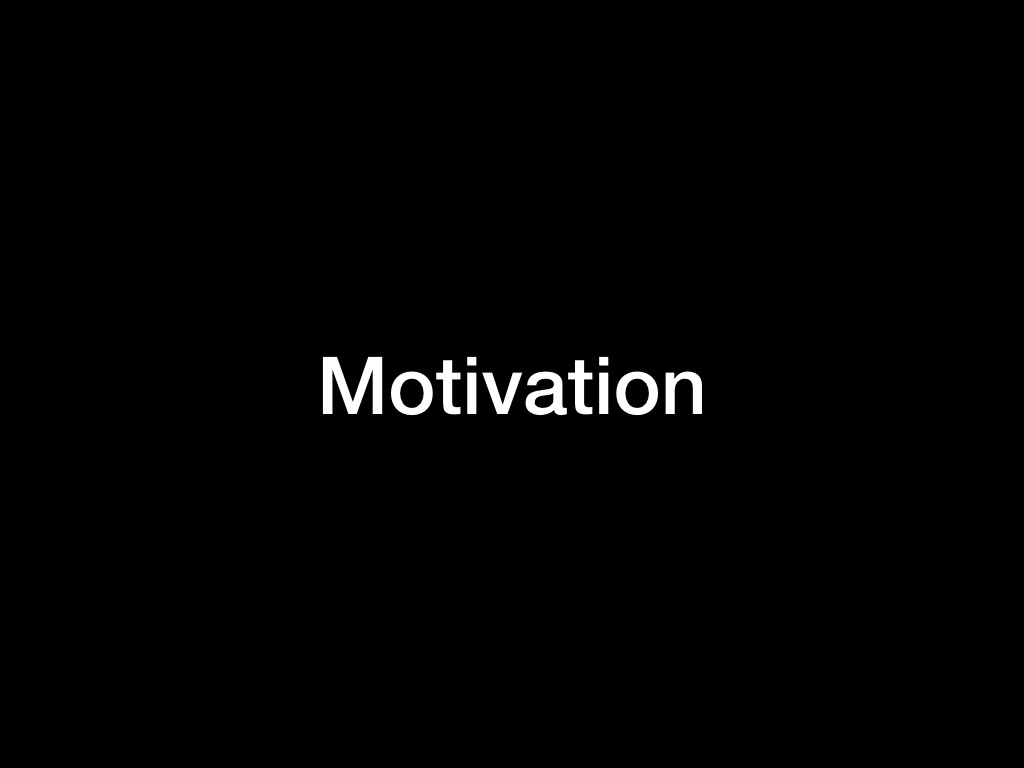
So what do we know about passion then? While passion is a hard term to define and measure, we do have really good science around motivation, which plays a core role in passion
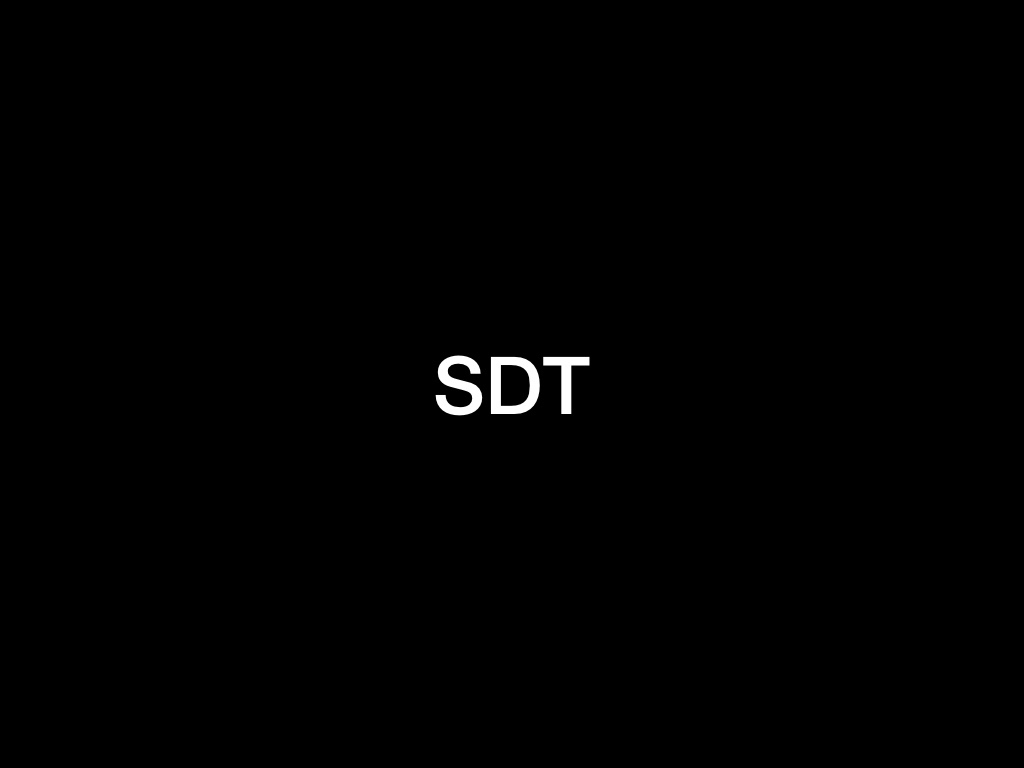
Specifically, this motivation research predominantly centers around the SDT
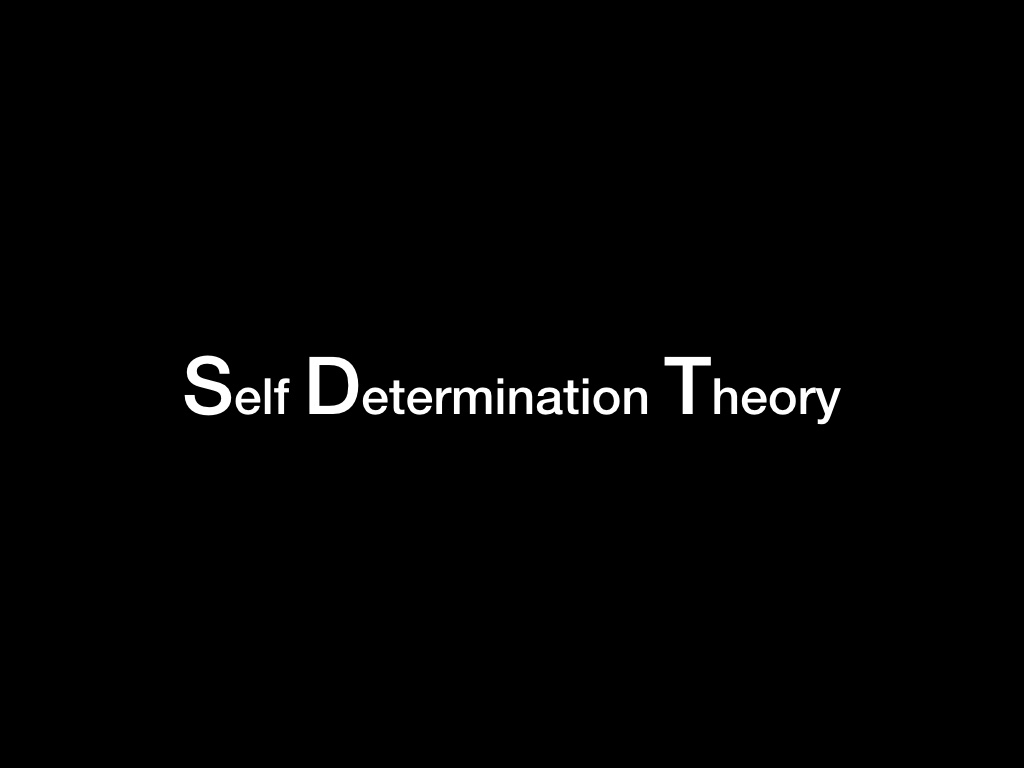
The Self Determination Theory
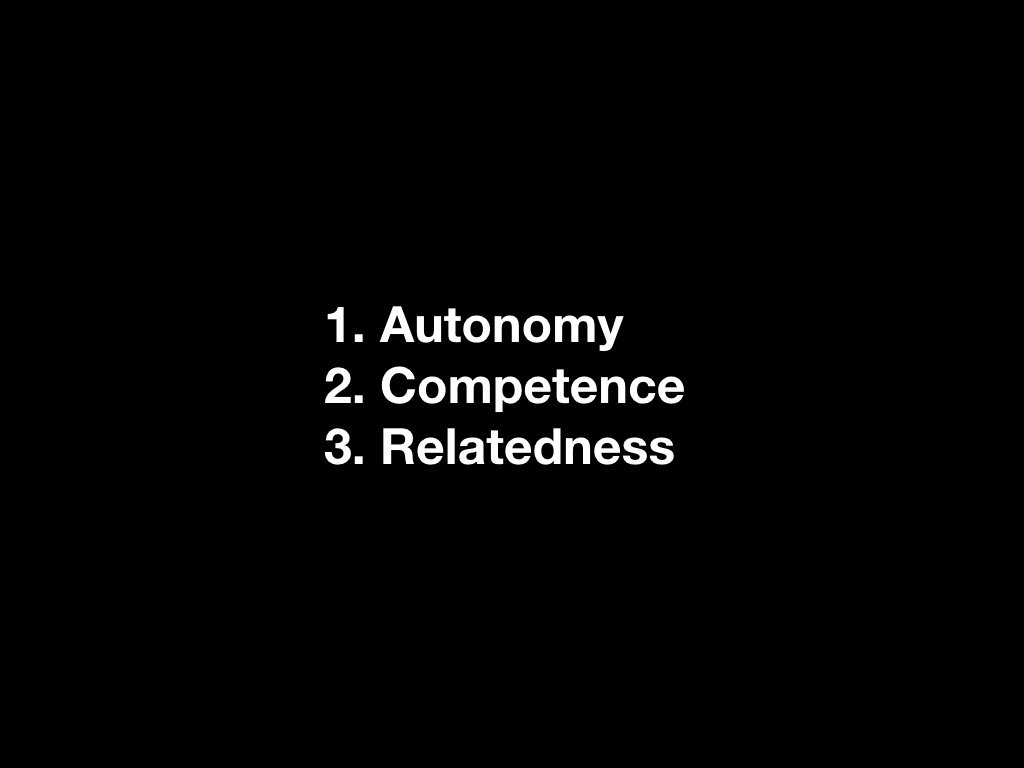
SDT tells us that humans are most motivated when they have access to these three factors
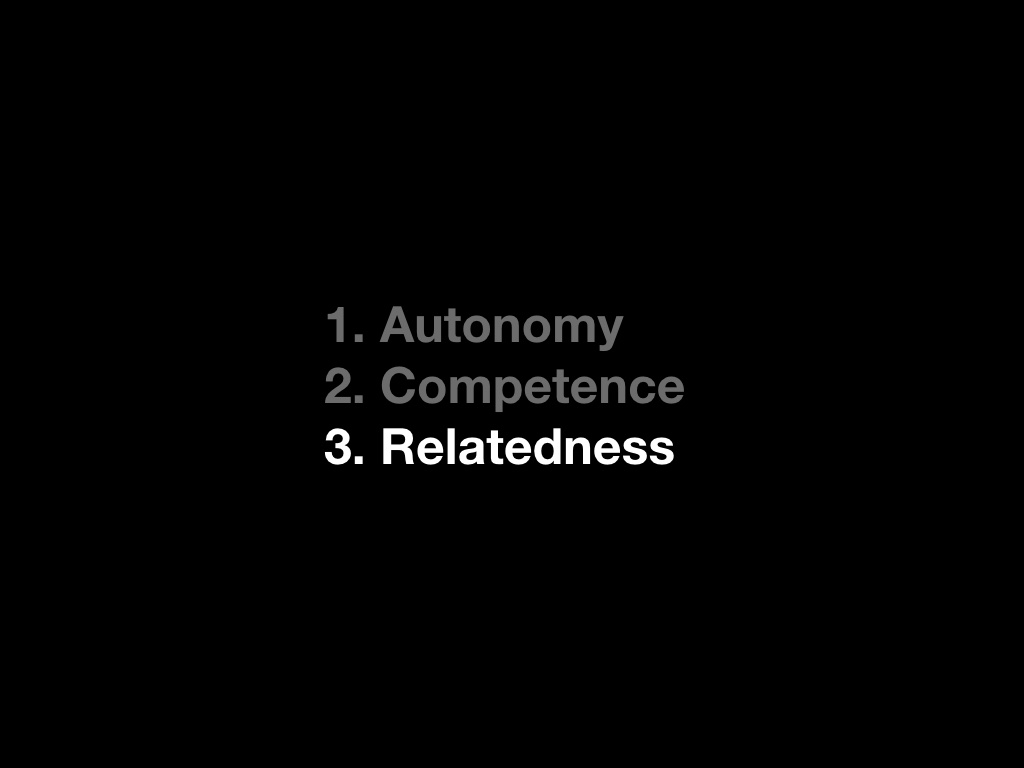
Let’s start with the easiest one. SDT tells us that if you’re isolated from or hate your coworkers, you won’t feel motivated. This probably surprises no one in the audience who has had coworkers they hated
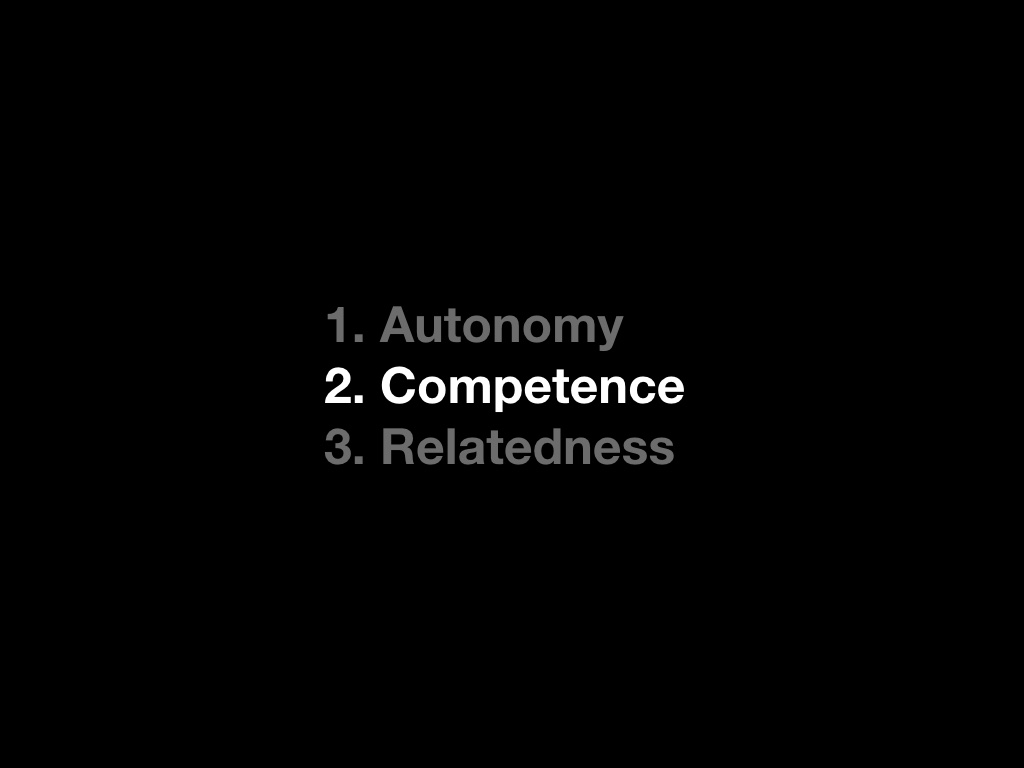
The competence piece we looked at earlier. Self reported happiness spikes based on the number of flow states achieved in a given week. This one also probably isn’t much of a surprise: we’re happy and motivated when we’re good at things.
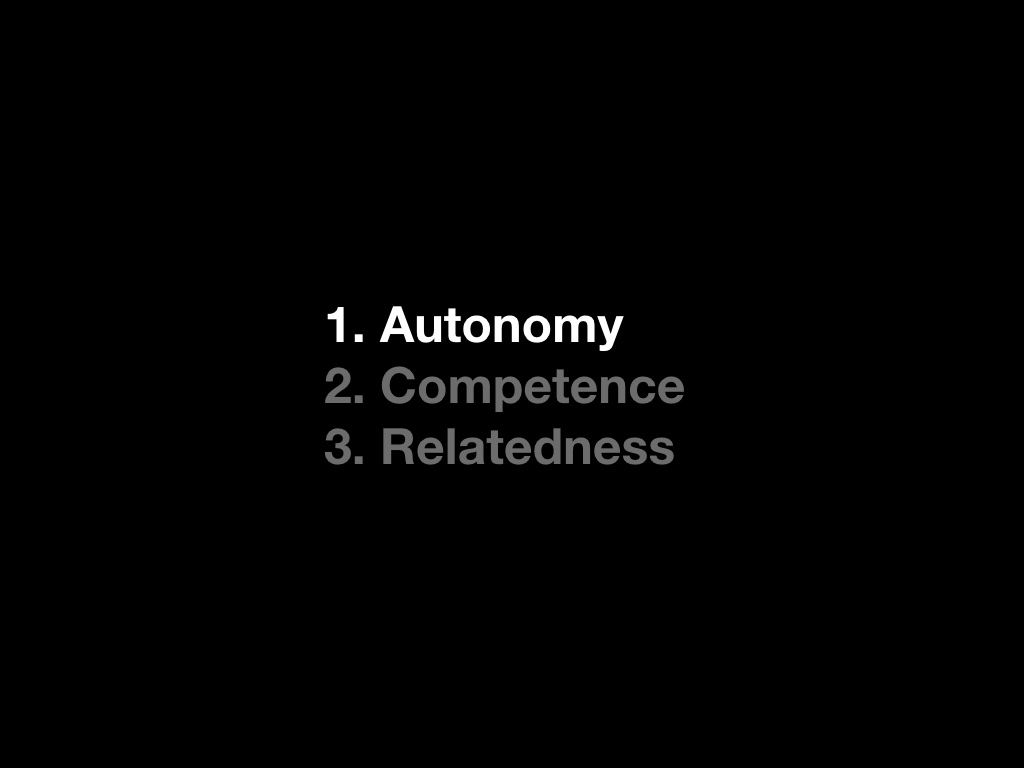
But autonomy is a factor we haven’t yet talked about, and it is a DOOZY.
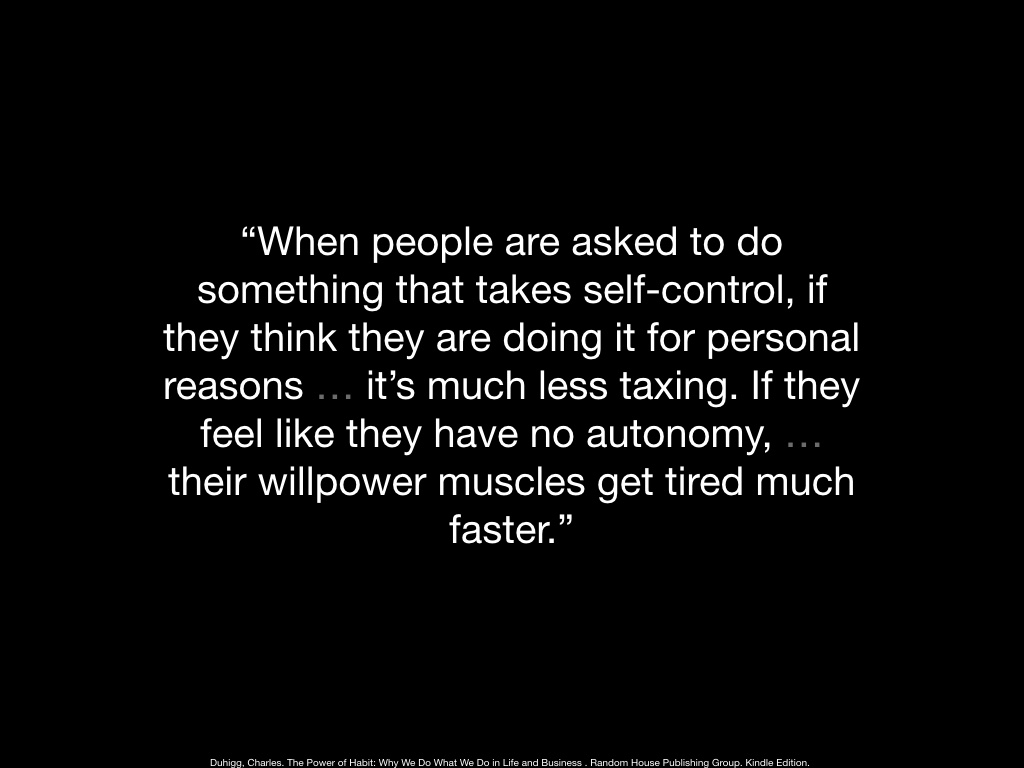
It turns out that if people think they are doing things for their own reasons, it requires much less willpower to complete a task.
_____________________
Quote: Duhigg, Charles. The Power of Habit: Why We Do What We Do in Life and Business . Random House Publishing Group. Kindle Edition.
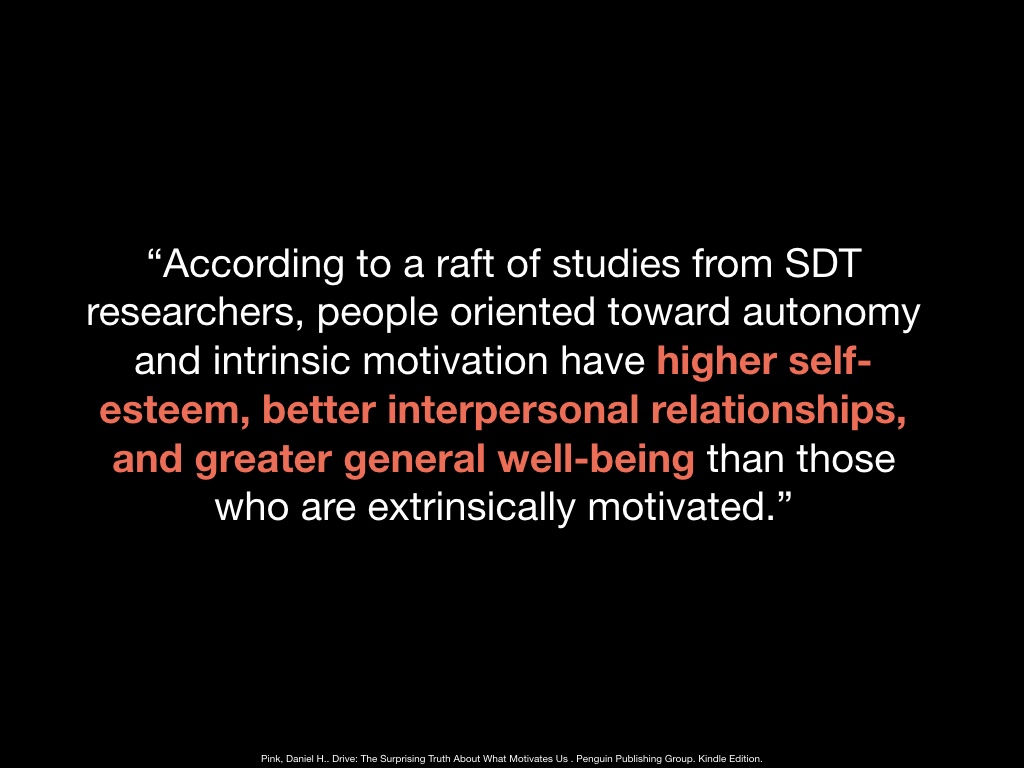
And that’s just the start. Autonomy is linked to a slew of good outcomes including higher self esteem and greater general well being
_____________________
Quote: Pink, Daniel H.. Drive: The Surprising Truth About What Motivates Us . Penguin Publishing Group. Kindle Edition.

And as if that’s not enough we can keep piling on the good things associated with autonomy. It also is tied to higher productivity, less burnout, and better psychological well being.
_____________________
Quote: Pink, Daniel H.. Drive: The Surprising Truth About What Motivates Us . Penguin Publishing Group. Kindle Edition.

So autonomy sounds really good. But let’s once again put on our pessimism pants for a minute and and look at this from a business’s point of view. Does a business benefit from giving employees a sense of autonomy?
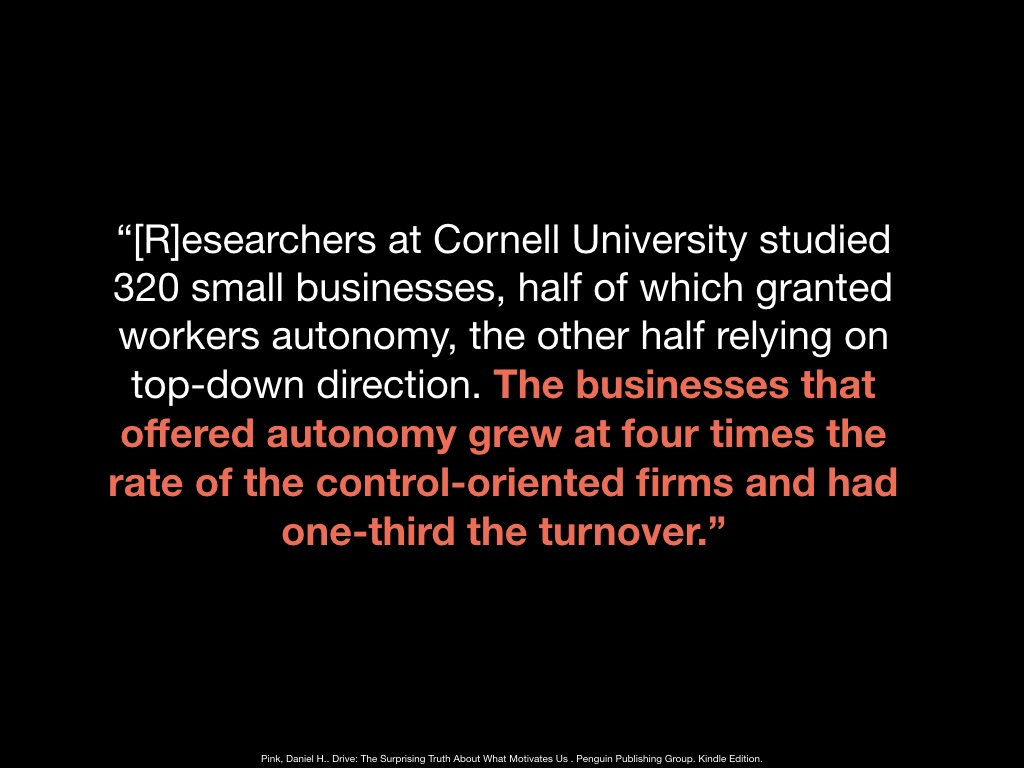
Boy oh boy they sure do. One study found that businesses who did this saw a 4x growth rate and 1/3 lower turnover that firms who did not.
_____________________
Quote: Pink, Daniel H.. Drive: The Surprising Truth About What Motivates Us . Penguin Publishing Group. Kindle Edition.
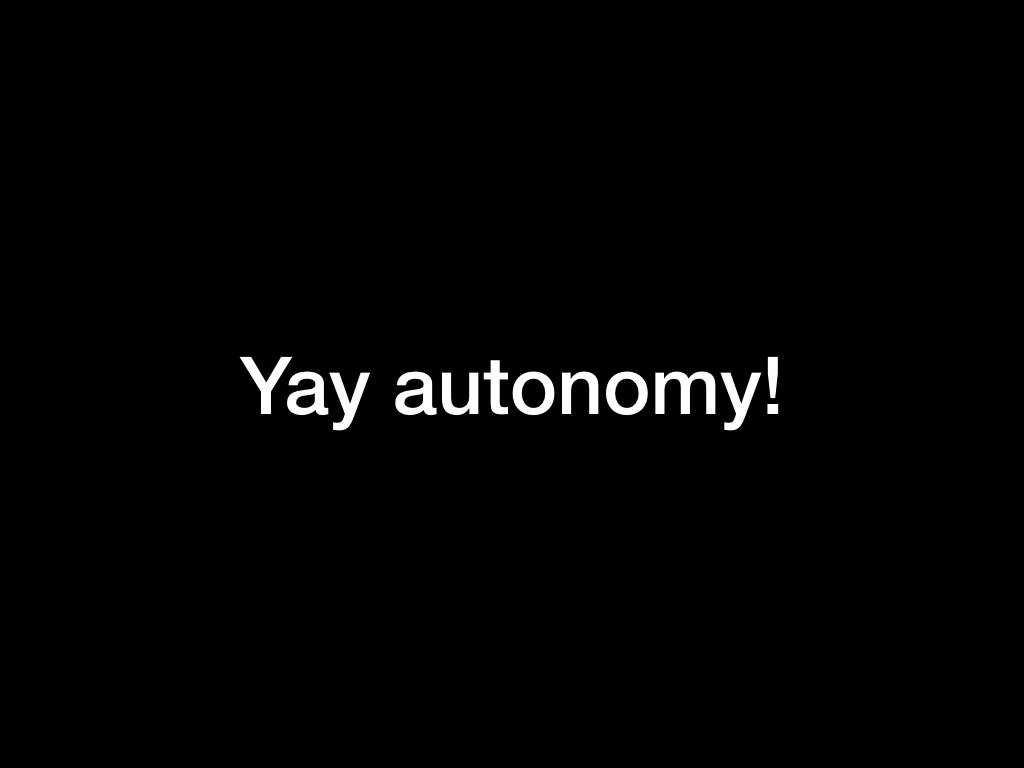
So wow. A sense of autonomy is wildly powerful. Sounds great! And it sure is. But as with most things in life, it can be a bit more complicated than we might think. So let’s take a moment to think about managers.

Up until now, I’ve spent this whole talk speaking about how to think of ourselves as athletes. But I’ve up until now ignored a crucial fact: that almost all professional athletes have coaches. So before we end, I want to take a brief moment now to address this vital relationship, that between athletes and their coaches (aka managers)
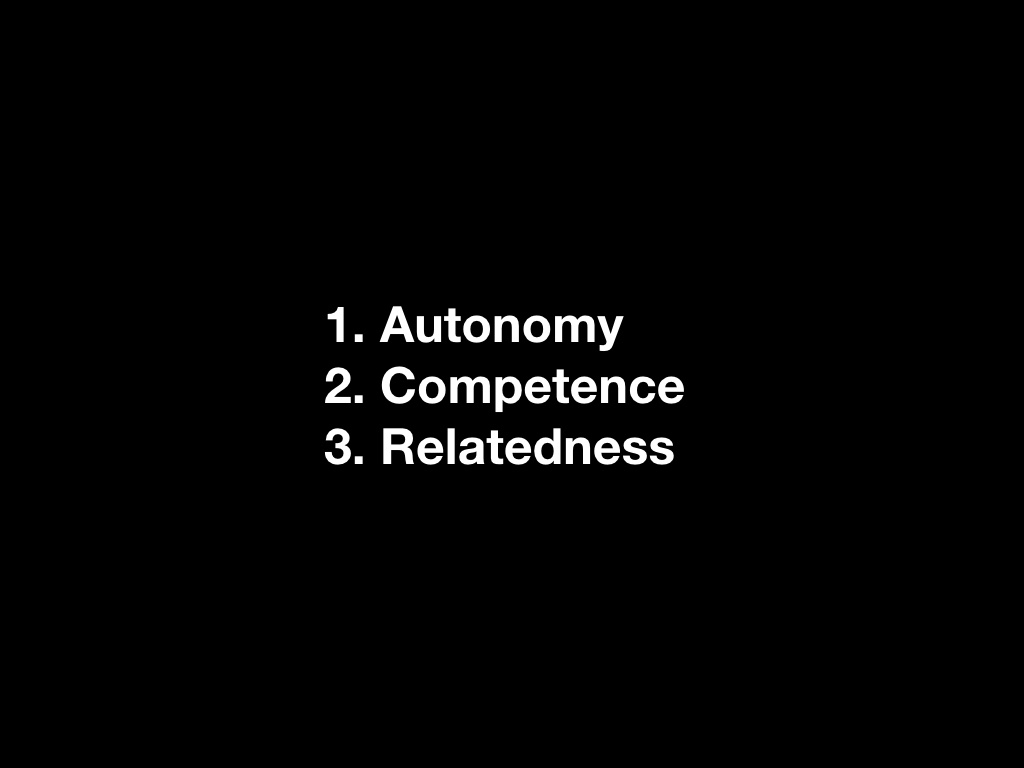
If you are a manager, by and large you should be thrilled by the lack of research based support for the passion hypothesis and the rigorous data on SDT primarily because all three of the SDT factors can be augmented by a good manager, unlike passion, which you cannot gift someone.

However, beware this gift is EXTREMELY fragile. The fact that managers have direct influence over worker’s sense of autonomy is great in one way, because it means they can adjust it to make workers happier and multiply their output. But on the other hand, this makes brathletes extremely susceptible, as even an elite athlete can be easily undermined if paired with a coach who is not operating optimally. And this is far easier to do with a sense of autonomy than you might think, as it’s surrounded by quite a few unintuitive gotchas.
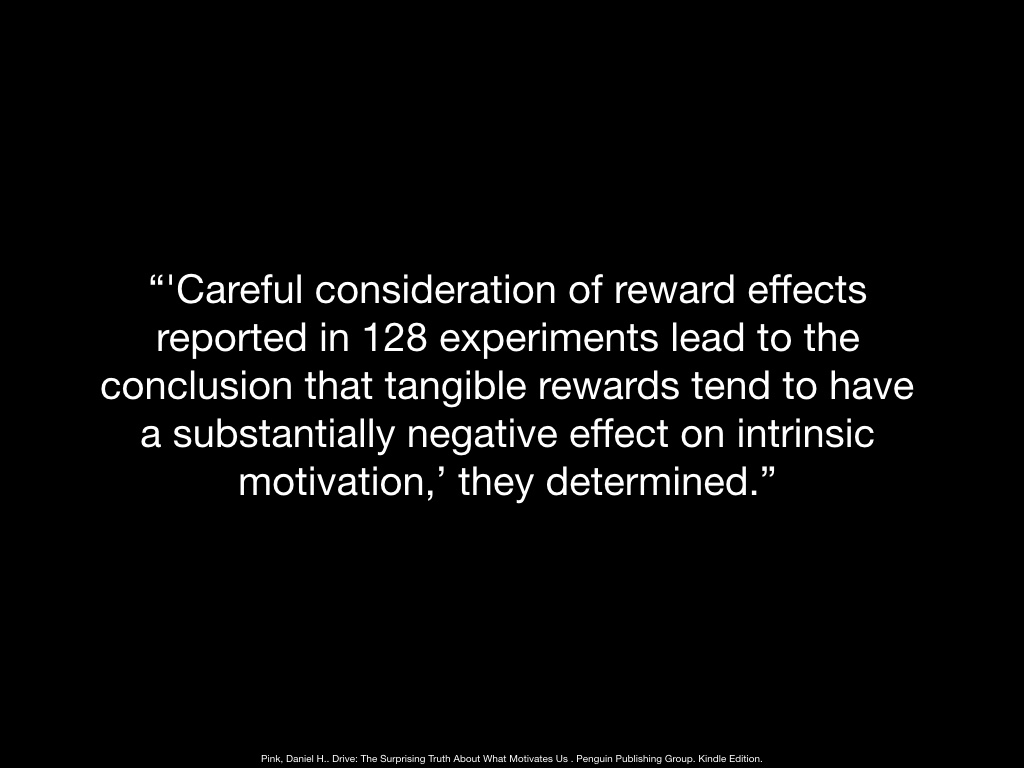
For instance in one study in Sweden, people were less likely to give blood when paid for it than when not, unless they were also given the option to donate the money to a charity, in which case they were as likely to give blood as the unpaid group1. The act of trying to reward these blood donators robbed them of their sense of joy in doing something good “just because”.
________________________
Quote on slide: Pink, Daniel H.. Drive: The Surprising Truth About What Motivates Us . Penguin Publishing Group. Kindle Edition.
1: “They’d shown up, which indicated intrinsic motivation. Getting a few kronor on top might give that impulse a boost. But—as you might have guessed by now—that’s not what happened. In this group, only 30 percent of the women decided to give blood. Instead of increasing the number of blood donors, offering to pay people decreased the number by nearly half. Meanwhile, the third group—which had the option of donating the fee directly to charity—responded much the same as the first group. Fifty-three percent became blood donors. Titmuss’s hunch might have been right, after all. Adding a monetary incentive didn’t lead to more of the desired behavior. It led to less. The reason: It tainted an altruistic act and “crowded out” the intrinsic desire to do something good.”
Pink, Daniel H.. Drive: The Surprising Truth About What Motivates Us . Penguin Publishing Group. Kindle Edition.
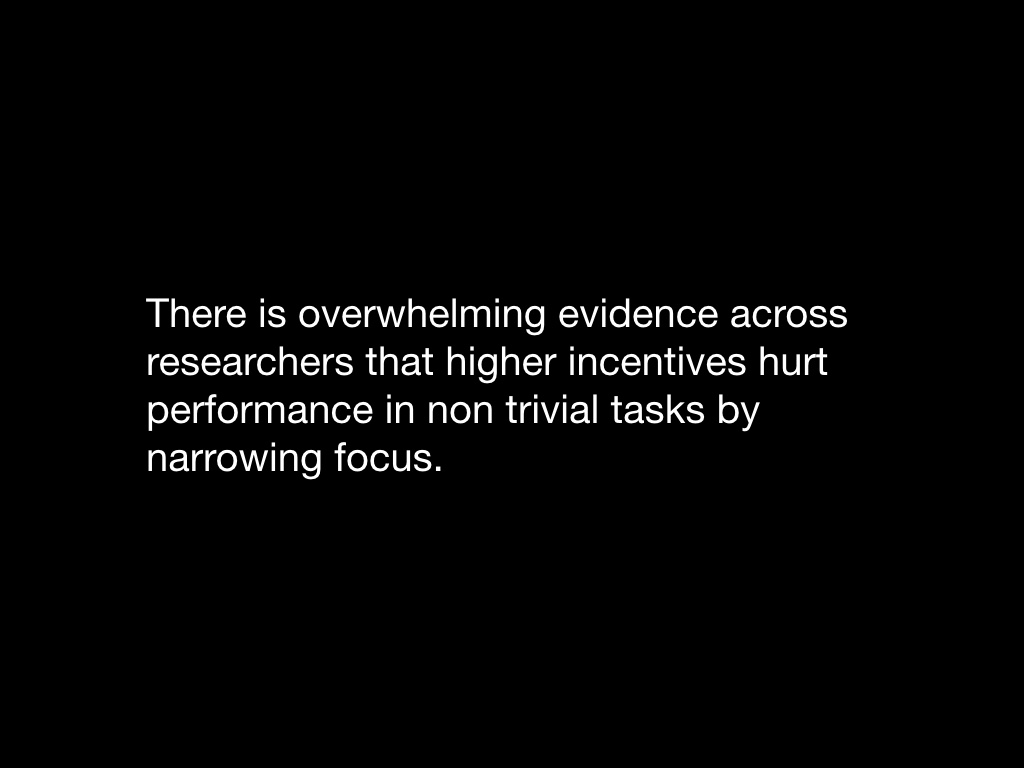
Well intentioned rewards can undermine people in other ways as well. In addition to robbing us of our feeling of autonomy (as we saw on the previous slide), rewards can also cause us to narrow our focus and miss solutions. Specifically, offering high financial rewards results in lower levels of creative thinking, as measured by studies such as the candle problem, in which the higher the reward offered on a task requiring creative thinking, the slower the participants were to find the answer.
________________________
“In direct contravention to the core tenets of Motivation 2.0, an incentive designed to clarify thinking and sharpen creativity ended up clouding thinking and dulling creativity. Why? Rewards, by their very nature, narrow our focus. That’s helpful when there’s a clear path to a solution. They help us stare ahead and race faster. But “if-then” motivators are terrible for challenges like the candle problem. As this experiment shows, the rewards narrowed people’s focus and blinkered the wide view that might have allowed them to see new uses for old objects.”
Pink, Daniel H.. Drive: The Surprising Truth About What Motivates Us . Penguin Publishing Group. Kindle Edition.
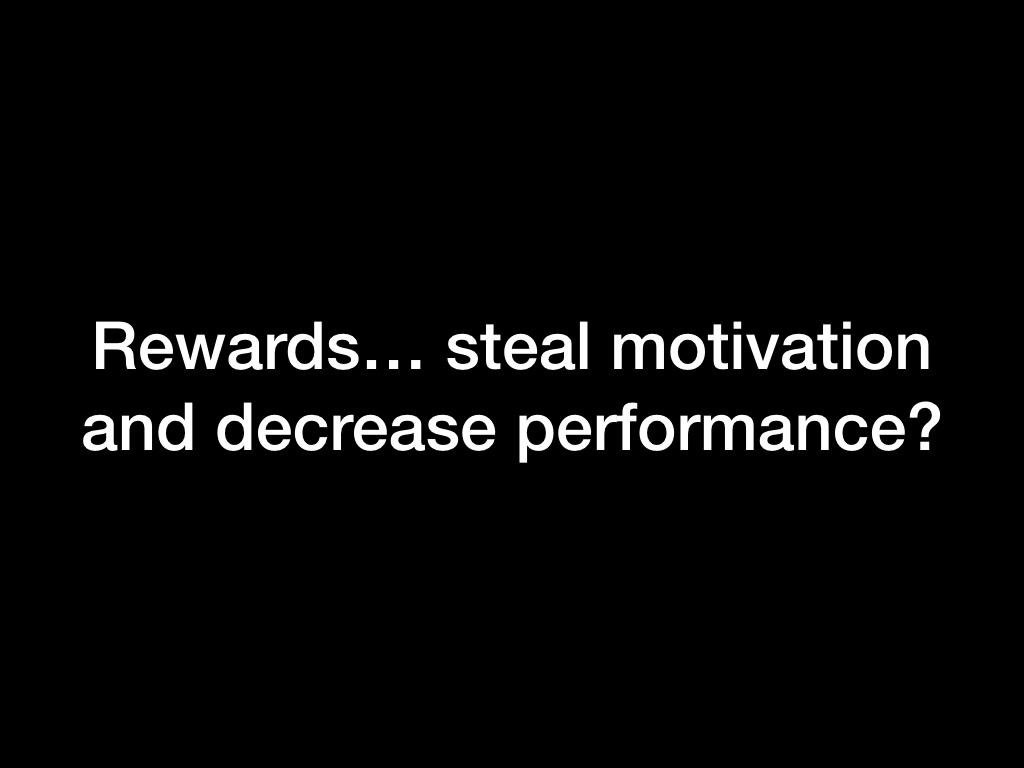
Wait, so you’re telling me rewards steal motivation and decrease performance?

Well not entirely. But when not administered with care, they easily can cause people to feel like they lack autonomy (you say jump and I jump just to get the money) or make them feel too pressured to take a step back and think creatively (a lot is at stake here, I really need to perform!!).
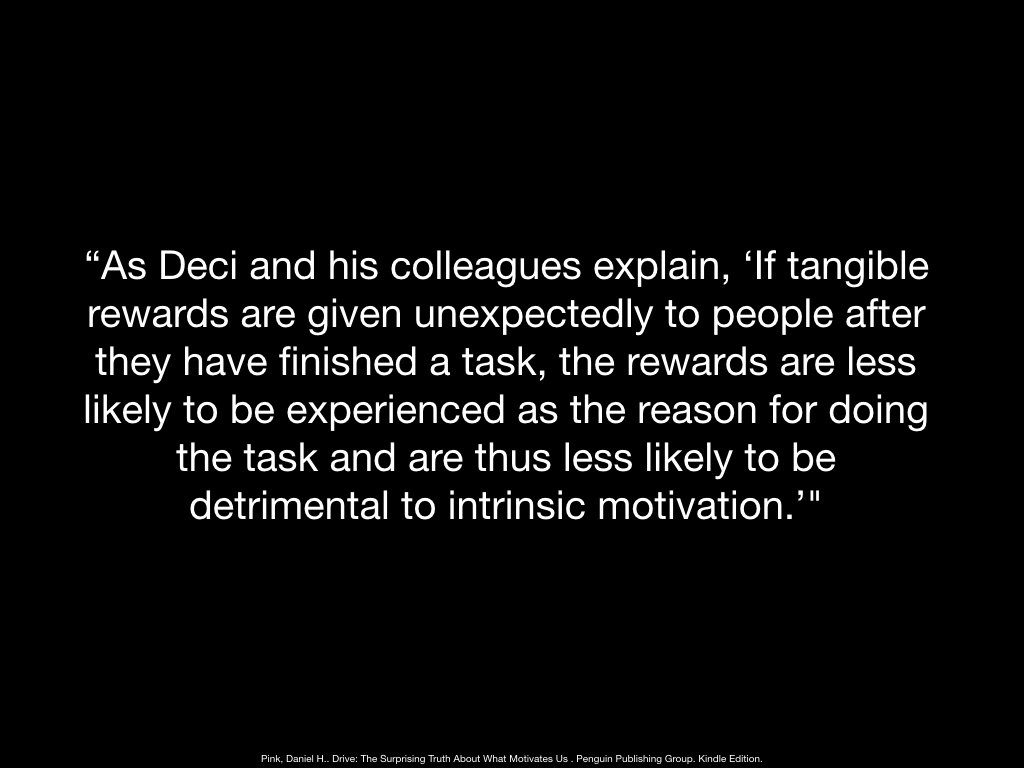
Luckily though, with this knowledge of why rewards can go wrong, we can quite easily fix the ways we administer them so as not to cause these unwanted effects.
Quote Citation: Pink, Daniel H.. Drive: The Surprising Truth About What Motivates Us . Penguin Publishing Group. Kindle Edition.

And that is to make sure it is unexpected and offered only after the task is complete.
Quote citation: Pink, Daniel H.. Drive: The Surprising Truth About What Motivates Us . Penguin Publishing Group. Kindle Edition.

But I make this point not to convince everyone to change how they give rewards, but primarily to show that motivation, which I’m using here as proxy for passion, can be extremely unintuitive at times. It is unlikely that someone would have guessed ahead of time that paying participants more money to solve problems would slow them down, or that offering people money for blood donations would make them less likely to donate.
And given that rewards are often administered by managers, this should let us know how important the manager/employee relationship can be to our own performance, motivation, and happiness. We can be an elite brathletes, putting into practice all of the recommended habits, but be woefully undermined in our pursuit if our manager is not applying the same rigor to their craft. Managers, like ICs, cannot simply “try harder”. Informed, deliberate practice with accurate feedback is every bit as important for them as it is for ICs, because the skills they are managing are just as cognitively demanding and can have outsized impacts on productivity.
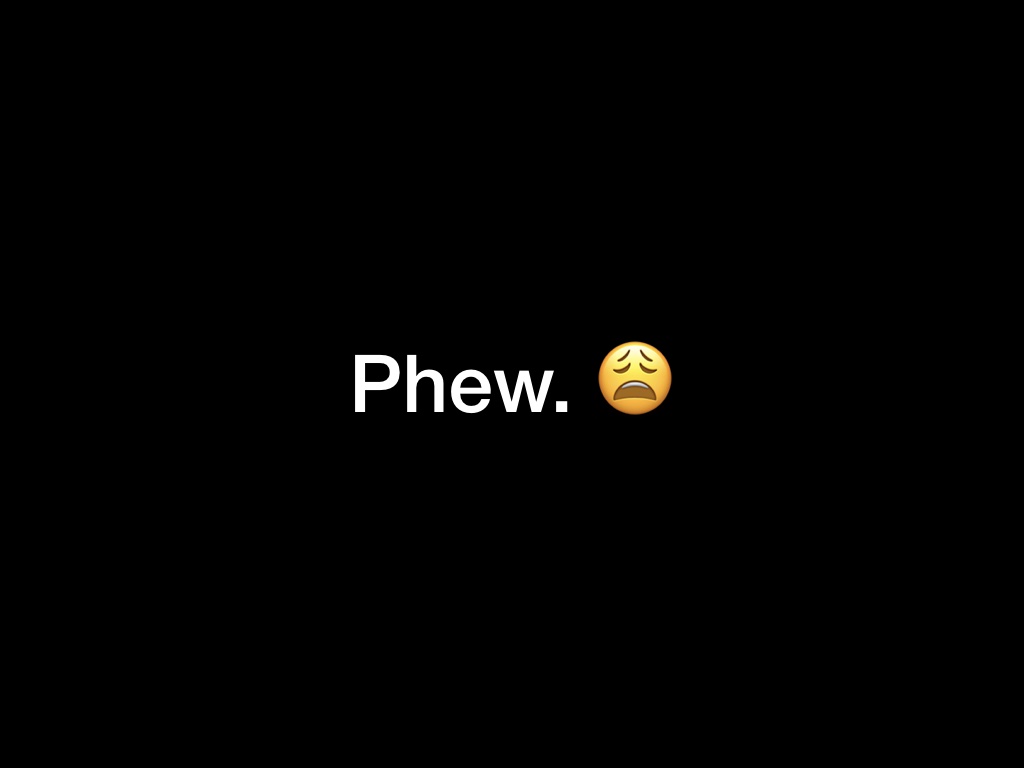
OK, phew, that was a lot of material.

So where have we been? Let’s recap some of the key arguments put forth.
First, I made a case that the brain should be viewed as analogous to a muscle.
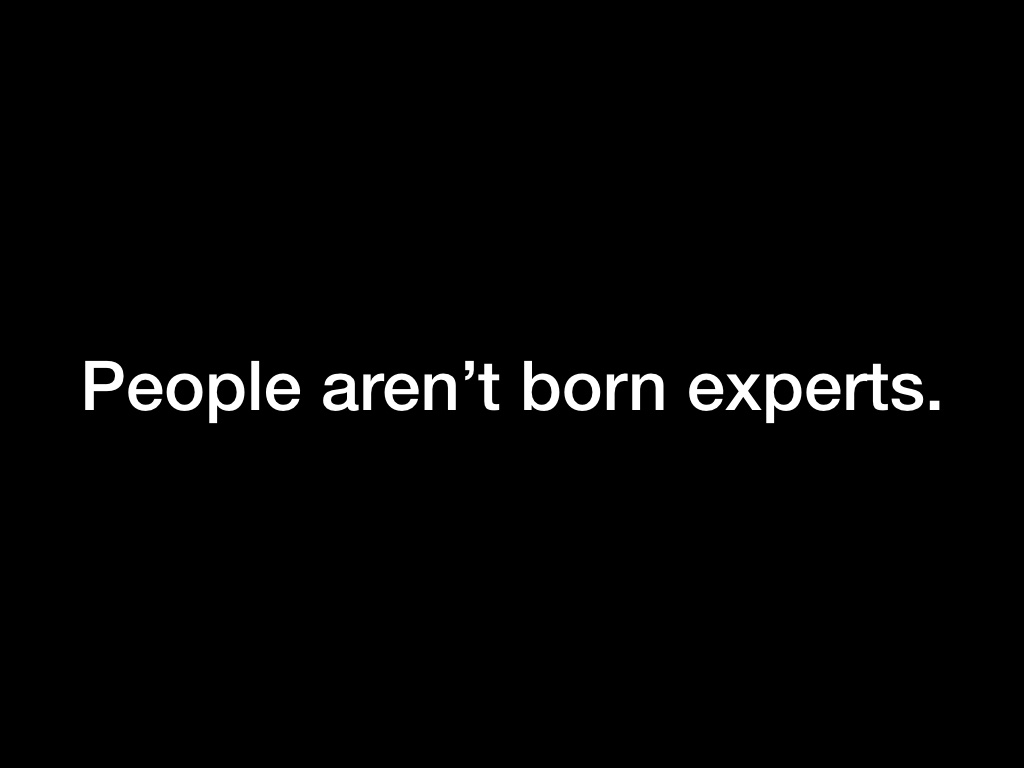
Then I argued for the fact that people are not born experts and instead achieve that level through dedicated practice.

This lead to a discussion of the fact that genetic differences appear to be quickly surpassed by quality practice, at least in studies of chess players, who are, like programmers, cognitive athletes and not physical ones.
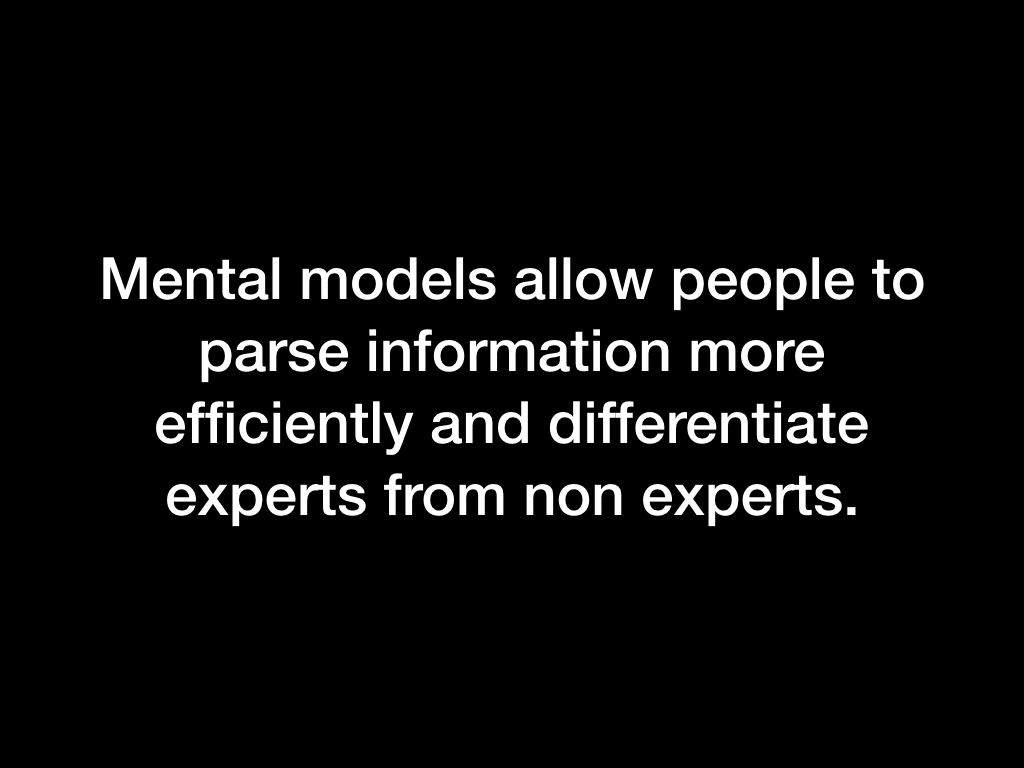
From there, we talked about how a key differentiator between expert performers and others was that the experts held sophisticated mental representations in their minds.
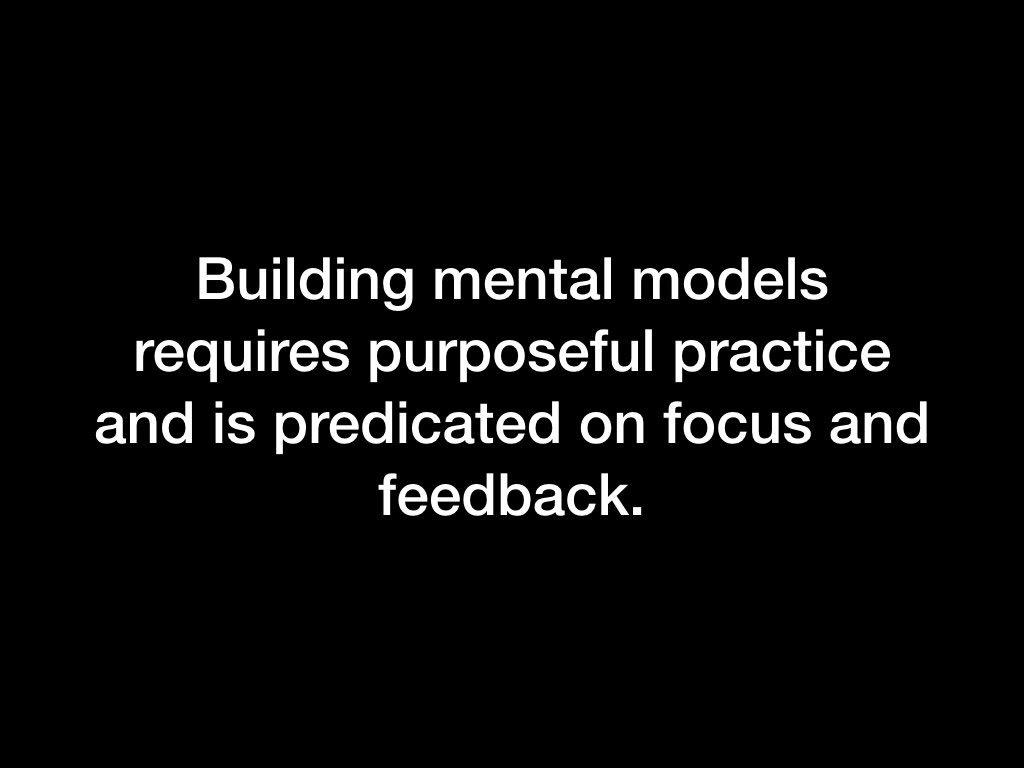
And that building these representations required diligent and focused practice with lots of feedback and layered skill acquisition.

From here, I pointed out that the standard workplace is not ideally set up to help us do the deep concentration tasks necessary to build these mental models or get feedback routinely.
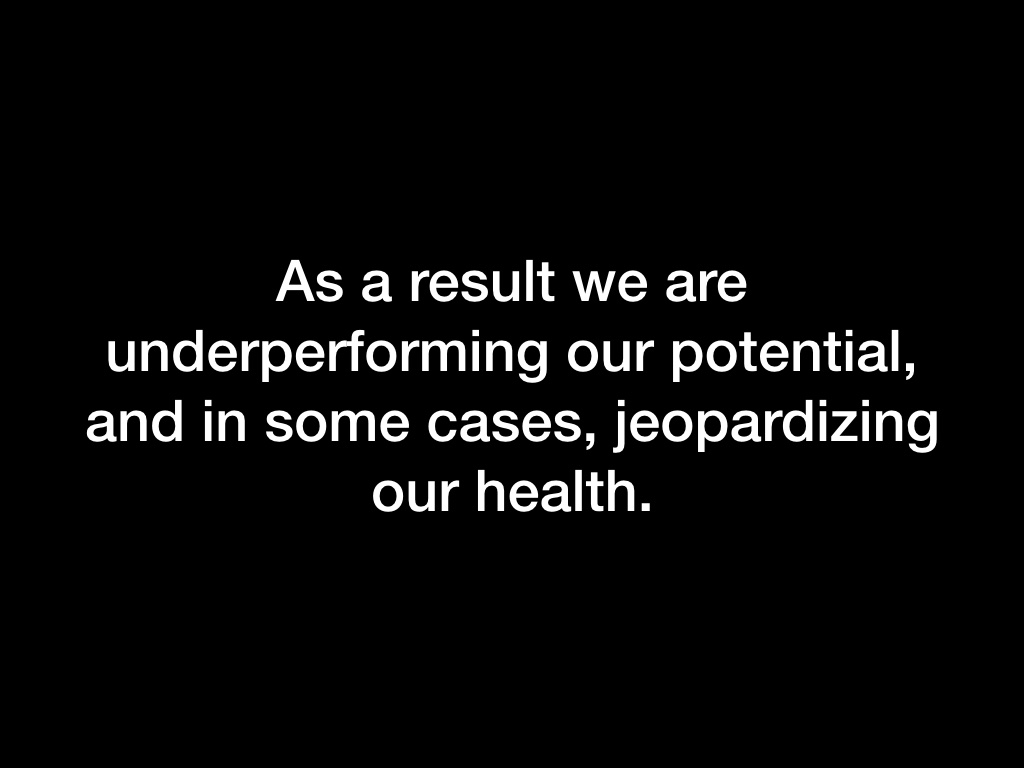
And as a result it is likely that we ware underperforming our potential. Further, some people try to make up for this by giving up sleep or free time, which compounds the issue and makes it worse than before.

I argued that if we had adequate time to focus and get feedback, we’d be able to achieve mastery of our crafts.

And that a direct result of that mastery would be the ability to be more motivated by our work, as competence is one of the three pillars of the SDT.

We ended by looking at autonomy, which is required in addition to mastery to support the SDT, and concluded that it had overwhelming positive effects for workers but was easy to accidentally undermined if a worker was not paired with an excellent manager/coach


Now that I’ve spent an hour telling you how to master your crafts and become the next SuperBrain Champion, I think it’d be a good time to leave you with one crucial piece of parting advice.

After all this advice about acing your craft, it turns out no one likes a winner*. We know this already instinctively! Think of a team you hate. Any team. I’m betting the one that comes to mind is probably one that beats your favorite team a lot, or beat them in a key game. But there is one caveat here, and that is…
Amendment: No one likes a winner, unless it is them 😉
________________________
Quote Citation: Grant Ph.D., Adam M.. Give and Take: Why Helping Others Drives Our Success (p. 75). Penguin Publishing Group. Kindle Edition.
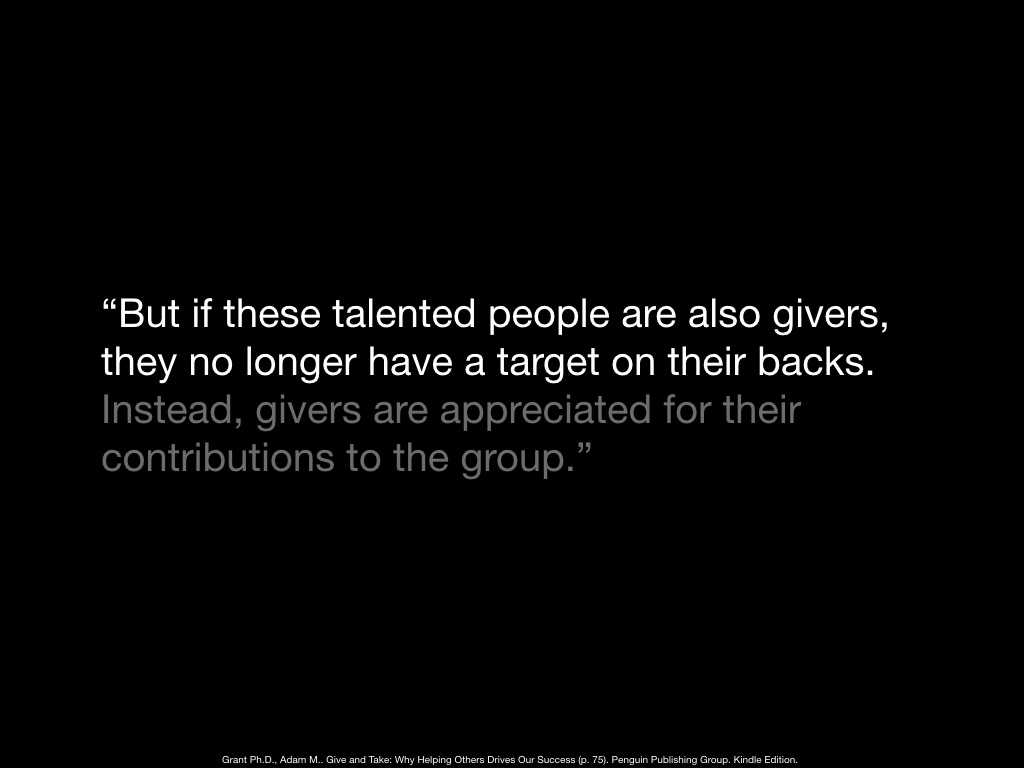
This effect can be offset by generosity. So go forth with this new knowledge, improve yourselves, and be generous you champion Brathletes you.
_________________________
Quote Citation: Grant Ph.D., Adam M.. Give and Take: Why Helping Others Drives Our Success (p. 75). Penguin Publishing Group. Kindle Edition.
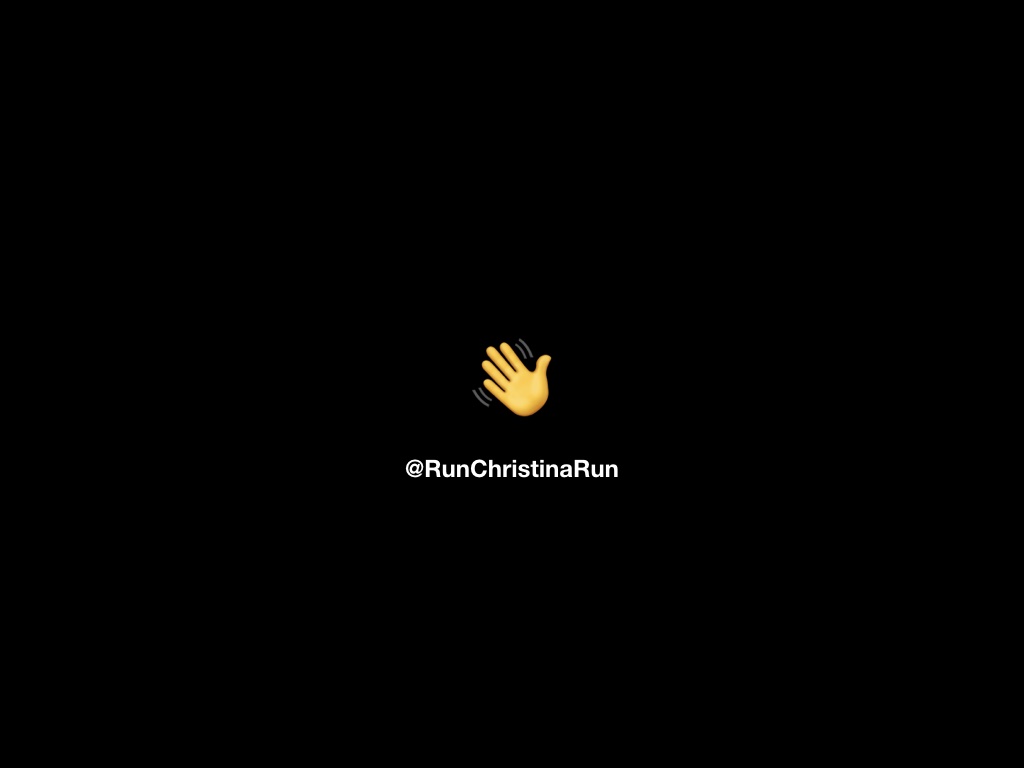
Thanks!